2
Some experiences leave an indelible impression not because they illustrate or represent a phase in life’s journey but because they seem disconnected from it, standing outside its arc. That is the way I remember my most vivid recollection of my first month in Vietnam, following my arrival in Saigon in October 1963. The incident jarred me out the familiar contours of my previous life experience, and left me standing on the brink of a world whose outlines I could only dimly grasp. It was the moment that the limits of my understanding of the world around me were starkly revealed.
I can no longer recall what led up to it, or what followed it, but it was my first experience of being swept up in a collective galvanizing experience – other than the late night rallies in front of a massive bonfire preceding Deerfield Academy’s annual football game against its hated rival Choate, that whipped us into a frenzy (Beat Choate!!) that would have put the Nuremberg rallies to shame. This was totally alien from anything I had previously encountered. Standing in a residential alley in front of my fiancée’s family home, surrounded by a crowd of Vietnamese gesticulating to the heavens with extreme agitation left an indelible memory.
As Mai, who was standing next to me, recalled years later in her family memoir, “One day I heard a commotion in our alley late in the morning. I ran out and noticed a crowd of people peering at the sky and saying, ‘The sun is spinning! The sun is spinning!’ I looked up and saw – to my amazement – that the sun was etched with a dark circle that was turning very fast.” Along with everyone else she was baffled. “Perhaps there is scientific explanation for this strange phenomenon, but none of us could think of one. Perhaps, induced by hysteria, we were only imagining things. We stood there, awed by what we had witnessed. My neighbors told one another that this could mean only one thing: Diem was going to be overthrown.” (p.298) It is emblematic of the power of this shared collective cultural moment among Vietnamese that Mai does not remember my presence at the event. Despite my physical presence among the crowd, as an uncomprehending foreigner, I was outside the framework of that remembered moment – a disconnect from the collective event that I was keenly aware of at the time.
As Mai later surmised, it could have been due to mass hysteria triggered by the volatility of the Saigon political atmosphere in the last days of the Diem regime. Every Vietnamese was immersed in a shared political culture in which, as illustrated by Chinese popular historical novels like the Romance of the Three Kingdoms, the loss of the mandate to rule as inevitably prefigured by strange natural phenomenon. “When a ruler violates this mandate, heaven sends the signs that he will be punished, usually natural disasters like earthquakes or unnatural phenomena like roosters suddenly laying eggs.” As Diem’s unpopularity was ratcheted up by events like the self immolation of Buddhist monks, all of Saigon was on edge, and instinctively awaited the confirming signs of heaven’s disfavor or the current regime, which now seemed at hand. Indeed the “sun is spinning” episode was one of the experiences of my life in which the atmosphere could truly be characterized as “electric.”
So the perception of the corona around the sun rotating could have been mass hysteria, but I saw it too (though I wonder in retrospect how I could have been staring straight at the sun) – an alien outside observer, not knowing the deeper significance of what I was witnessing. I even understood what the crowd was saying, though it was a phrase that I had never heard in the 47 weeks of intensive Vietnamese language training that I had just completed in Monterey California: “mặt trời quay! mặt trời quay!” I understood the literal meaning of the words – “the sun is turning” but, unlike the crowd of Vietnamese in the alley, I had no clue of the deeper meaning that these words, and what the phenomenon which we all observed, signified.
It is only in retrospect that I can recognize how aptly this incident reflected the chasm in cultural understanding that separated Americans from the Vietnamese whose fate they had come to determine. The sensible program to train Americans in the Vietnamese language to fill the linguistic gap between official America and the society it hoped to transform, could only assure communication at the most superficial and literal levels. Even the most basic cultural underpinnings of real communication would take much longer to acquire.
And even with a rudimentary functional grasp of the language and the personal ties with Vietnamese society provided by my connections with Mai, and her cohort of American-educated Vietnamese who had served as my initial introduction to a country about which I had been totally ignorant, I was disoriented by my initial encounters with Vietnam. The summertime swelter of Boston and Virginia had not prepared me for the blast-furnace heat of Saigon which greeted us as we stepped off the plane at Tân Sơn Nhứt Airbase (this is a common South Vietnamese spelling of Tân Sơn Nhất airport, based on the Southern dialect pronunciation), and moved the short distance on the military side of the base to our barracks in the adjacent compound of the Third Radio Reconnaissance Unit (3rd RRU) which would be my home for the next several months.
The 3rd Radio Reconnaissance Unit was a cover designation for the 400th Operations Unit (Provisional) of the Army Security Agency.1 The “cover,” intended to disguise the connection with the super-secret Army Security Agency, was fairly transparent and, I’m sure, did not deceive anyone. It was formed as a result of President Kennedy’s April 1961 decision to beef up America’s signals intelligence capabilities. “On 13 May 1961 92 personnel of the 3rd RRU landed at Tân Sơn Nhứt Air Force Base, located just west of Saigon proper. … The 3rd RRU’s entry marked the first time that an entire army unit had deployed to South Vietnam; previously only individual advisors had been assigned. The headquarters and processing elements of the 3rd RRU immediately found a home in an empty warehouse.” Most of the first contingent of the 3rd RRU lived downtown in the Majestic Hotel, the grandest accommodations available in Saigon at that time.2
By the time I arrived two years later, the initial base had been expanded and all unit members lived there. We lived in wooden barracks, some with rudimentary protection from sandbags. Although the base was barren and dusty, I still recall the musky odor of decomposing tropical vegetation which suffused the military side of Tan Son Nhut air base, before it was overwhelmed by the gas fumes of aircraft operations as the last traces of the reclaimed jungle on which the base had been built were submerged in the mechanical detritus of the massive military operations of the U.S. air force.
John Buquoi, a fellow linguist from Monterey who was a contemporary at the 3rd RRU, and whose brilliant poetry and remarkable personal experiences I will mention in this chapter, arrived around the same time I did, and later wrote the following memorable description of the smells that the first-time visitor to Saigon encountered in 1963. “It was a sweltering tropical mid-afternoon, and, as Thomas Fowler would say, it was the smell that was the first thing that hit him, and then the heat. The smell an unfamiliar, exotic, sickly sweet mixture of tropical fruits, flowers, sea breezes, rotting vegetation, diesel fumes, piss, gunpowder and cordite was wholly different than anything in his experience. It was not offensive, rather strangely enticing, erotic almost, but, very different and in no way offensive as he might have expected. They were scents and odors which dissolved in his blood and attached themselves to him from that moment, for life; scents which, fifty years and ten thousand miles later, he would still conjure from memory and be overcome with nostalgia for the place and the time and the people, the youthful adventure of it all.”[1]

Entrance to Davis Station, base of the 3rd Radio Research Unit circa 1963
Ten years later when I returned to Davis Station in 1973 with Jacques Leslie of the Los Angeles Times, it had become the headquarters of the delegation of the Provisional Revolutionary Government (PRG), newly arrived after the Paris Peace Accords of January 1973. They held periodic press conferences there for the benefit of the foreign press. Not only had the barracks of Davis Station changed hands, the former presence of the 3rd RRU had been completely effaced, and the tropical vegetation inside the base restored. Journalist John Spragens reported “Inside the compound the atmosphere is relaxed. The road is lined with banana trees and flowers planted by the Hanoi and PRG delegations, and delegation members greet correspondents as they walk the few dozen yards from the gate to the briefing room.”3

Provisional Revolutionary Government delegation at their Davis Station headquarters, April 1973.
One former member of the 3rd RRU describes the early years of the unit. “For the first time, a U.S. military unit had been sent to Vietnam as an operational unit. They were not advisors; they were a fully functioning field unit established to provide intelligence to [MACV].” The job was “to intercept enemy radio communications, break codes, analyze radio traffic, and utilize various methods of monitoring signal intelligence (SIGINT). … Their mission was conducted in what can only be described as ‘third world’ conditions, in the worst possible sense of the term. Their main operational facility was an old aircraft hangar at the base, which had no air-conditioning. Temperatures inside regularly rose about 100 degrees, and then the monsoon rains came. Water poured through the doors and flooded the entire area to a depth of several inches. The various operational sections were separated by stacks of C-ration boxes, and the analysts worked together at long tables pieced together from plywood and scrap lumber. There were no chairs so the tables were built high enough that the men could stand while they worked.”4

https://www.flickr.com/photos/13476480@N07/7743872460/in/album-72157630998344742/

3rd Radio Reconnaissance Unit barracks, Davis Station circa 1963

Outside the gates of the Davis Station compound, a few three wheel Lambrettas, converted to hold up to a dozen Vietnamese (and, of course correspondingly fewer larger Americans) served as a shuttle to take passengers to the main gate on the military side of the airport.
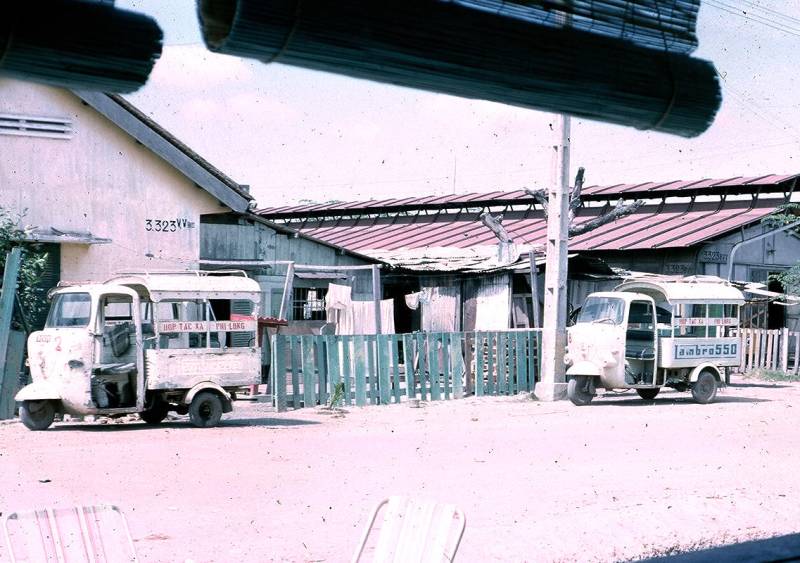
Three wheeled Lambrettas wait for passengers near the Davis Station main gate
Not long after my arrival in Vietnam I learned first-hand the distinction between the military and civilian sides of Tân Sơn Nhất airport. My first excursion out of the Tân Sơn Nhất base was on my first full day in Vietnam. I had not yet been assigned to any job at the 3rd RRU, and my time was my own. My first thought was to find Mai who had herself returned to Vietnam only a few weeks earlier in October 1963 after graduating from Georgetown University. Wearing civilian clothes, I climbed on to the Lambretta shuttle which took me from the Davis Station gate to the main military gate of Tân Sơn Nhất.

Tan Son Nhut AB, Main Gate. 1963. Photographer: Robert G. Anisko, 1962-1963
http://www.vspa.com/tsn-gates-and-posts.htm
The military gate, later called O-51, was over a half mile from the main civilian entrance to Tan Son Nhut airport, but I didn’t realize this at the time. Outside the military gate was a cluster of blue and white Renault Saigon taxis.
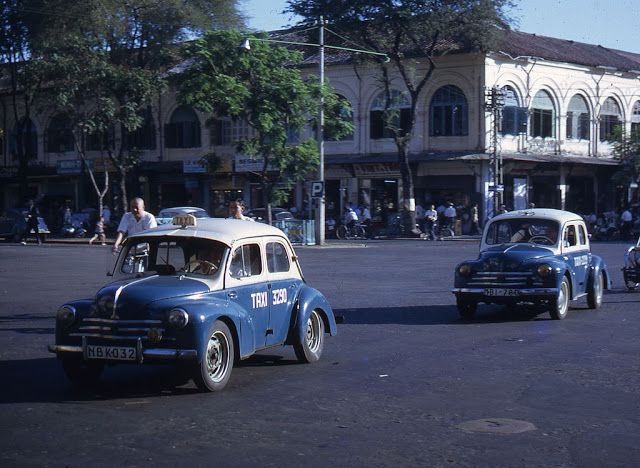
I was confident that my functional Vietnamese language skills would get me where I needed to go. For the moment, I was focused on finding Mai’s house and not on how to get back to the base (I assumed I would simply retrace my steps). I told the taxi driver to take me to 380/5 Công Lý. Công Lý was the main avenue connecting downtown Saigon with the airport. Mai’s house (number 5) was actually in a small hem or unpaved alley of contiguous stucco houses that, in this case, had been built to house civil servants after 1954.

Mai’s family home in the hẻm in front of their house, 1972.
The hẻm did not directly connect with Công Lý and there were a number of hẻm linked to the main alley leading from Công Lý, so it took a bit of trial and error to find. Later I would learn that the taxi drivers identified the general location along Công Lý where the main turnoff to the hem was, as being just below what later became internationally known as the “McNamara Bridge,” spanning a small creek flowing under Công Lý. This was the place where the Viet Cong terrorist Nguyễn văn Trỗi had planted a bomb intended to assassinate McNamara in 1964. For the Vietnamese, however, it was always the Cầu Bạc Má Hồng (Macmahon was the colonial era designation for Công Lý avenue, named for a French official. The literal meaning of the transliterated phrase was “bridge of a great beauty with a tragic destiny.” – derived from a famous line in Vietnam’s immortal epic poem, Tale of Kieu. I would only have to tell the cab driver “take me to the Cầu Bạc Má Hồng” and, as we approached the bridge tell him to take the turn-off to the hẻm.
But, on my first full day in Vietnam, I didn’t yet have this local knowledge, and had to locate the hẻm by trial and error. I got out of the taxi at the head of the first offshoot hẻm and walked down the row of houses until I found number 5. I asked someone in front of the house “Đây có phải là nhà cúa Ông Dương Thiệu Chi không?” (Is this the house of Mr. Duong Thieu Chi) which was the name of Mai’s father. My unexpected presence had created a commotion in the alley, and consternation in Mai’s house. She was not home at the time, and the neighbors were astounded to see me coming, probably the first American who had ever set foot in this hẻm. As would often be the case in Vietnam, I did not get a response to my question posed in Vietnamese because the idea that an American could speak the language was so improbable that even if I had spoken with native fluency it would have only registered as a babble of incomprehensible sounds.
Mai’s older sister Binh recalled that though she lived next door, she happened to be in Mai’s house when I arrived. As people inside the house spotted me, Mai’s father said “How come there is an American coming to our house?” and instructed Binh to go out and see what I wanted since she was the only one around who spoke some English. Binh recalled, “David was still standing at the door, so I showed off my English by asking ‘who are you looking for?’ David replied in English ‘I am a friend of Mai’s, and have come to see her. Is she at home?’ I said to Father, ‘he is a friend of Mai’s and has come to see her. Father responded ‘tell him that Mai isn’t home but will probably return soon, and ask him where he is staying at present.’ The entire family was astounded when David replied in Vietnamese ‘I am staying at the military base in Tân Sơn Nhất.’ The entire family was astonished and delighted, and Father exclaimed, ‘This American knows Vietnamese!” and he invited David into the house. David and Father began to converse, but I had gone into the back room so I didn’t know what they discussed.”5
Mai eventually returned home and we were of course delighted that we had managed to re-connect, since our last communication had been before either of us had departed the United States, and because I didn’t know exactly where I would be, we could not make specific plans to get together. I had only Mai’s complicated street address as a guide. Now, however, we knew where I would be for the immediate future, and I knew how to reach Mai. Although I did not yet know what my assignment would be (and therefore what my schedule would be) we made arrangements to meet again soon.
My trip back to base was, unexpectedly, an adventure. I got in a blue and white taxi and told the driver to take me to Tân Sơn Nhất. Not knowing the layout of the base, I didn’t realize that he had taken the turn to the civilian side of the airbase instead of the military side. I got off at the civilian terminal, feeling that something was not quite right – I didn’t see the American MP’s and the guarded gate, but only a civilian passenger entrance. I walked inside the terminal, totally disoriented. The only person in sight was a uniformed Indian Army officer, replete with turban. I was vaguely aware that there was a diplomatic sensitivity to the military presence of Americans – especially those involved in combat related tasks like signals intelligence, and the International Control Commission, of which this Indian officer was clearly a member, was there precisely to ensure that there were no American combat troops in Vietnam in violation of the 1954 Geneva Agreements (recall that the 3rd RRU was the first complete unit sent to Vietnam to support combat operations), so it was not very appropriate to ask him, of all people, where the American military base to which the ICC was turning a blind eye was located. If he had a sense of humor, he might have referred me to an ASA recruiting poster which underlined that an advantage of signing up for that branch was that you would not be sent to Vietnam.
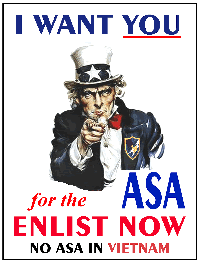
However, I felt I had no recourse other than to ask him how I could get from the civilian terminal to the American military base on the other side of the airport. He was probably mildly amused by the situation, but took it stride and pointed me in a general direction. By this time, the civilian airport was empty and there were no more blue and white taxis. So I hailed a pedicab and told the driver vaguely to take me to the other side of the base. By this time it was dark, and the streets adjacent to Tân Sơn Nhất were deserted. I don’t recall whether the pedicab driver simply took a wrong route because he was not clear that I wanted to reach the military gate to the airport, or whether we simply passed the dimly lit gate and I didn’t notice it.

Tân Sơn Nhất airbase circa 1963.
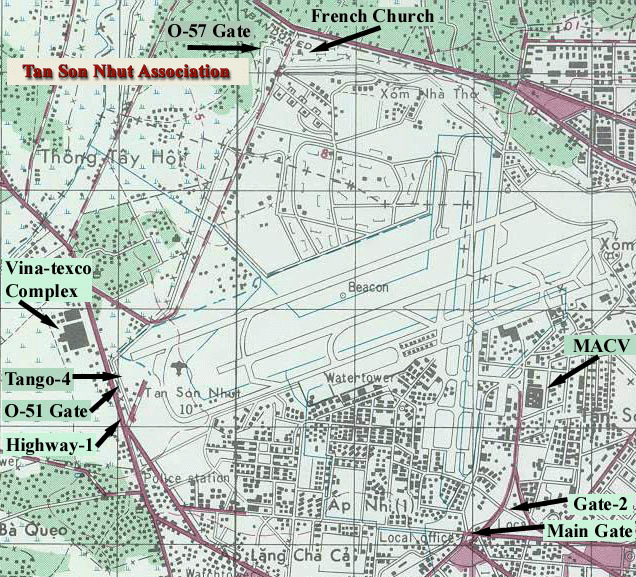
Main civilian gate and military gate 0-51 of Tân Sơn Nhất airport 1963
After about ten minutes I began to notice that the urban landscape had changed to open countryside. I later discovered that I was headed toward Hóc Môn, a traditional revolutionary stronghold, along the road which led to Tay Ninh. More recently Hóc Môn has become the symbol of the rapidity of urban sprawl which has obliterated the once sharp distinction between urban and rural in the massive and rapidly expanding urban sprawl of Saigon. Barely twenty kilometers from downtown Saigon, it is sometimes considered the “edge” where urban meets rural, though Erik Harms’ brilliant book of that name persuasively contests the idea that there is such a sharp dividing line, and points to the many overlapping indicators of both rural and urban dimensions of Hóc Môn, where he did his research.

Harms describes travelling from Hóc Môn in the early 2000s on motor bike, “starting down the road toward Saigon, enjoying the cool but dusty breeze. This was the edge of Hóc Môn, at the boundary of District 12, where Highway 22 turns into the Boulevard of the August Revolution, where the road commemorating Hồ Chí Minh’s revolution becomes the road to Ho Chi Minh City itself. On the map, this marker between the inner-city district and the outercity district appears substantial and seems to mark a divide. Move one direction and you will go in (đi vào) to the numbered districts of Ho Chi Minh City; the other way leads out (ra) to Hóc Môn. But the divide is more symbolic than real. Hóc Môn is also part of (thuộc) Ho Chi Minh City, and there seems no objective difference between the density or urban character of the streets on either side of the planners’ arbitrary divide. In Hóc Môn, Thành and I found ourselves both inside of Ho Chi Minh City and outside it.”6
In 1963, unwittingly travelling along the road to Hóc Môn, I perceived a sharp and unmistakable dividing line between city and countryside less than a few kilometers from Tan Son Nhut. Suddenly I noticed that the road was eerily deserted and no longer lit by street lamps. It was by now pitch black in the late evening. The only sound was the whir of breeze created by the pedicab and the noise of the rotating chain driven by the pedals. I was clearly headed in the wrong direction and into the unknown. I had read Graham Greene’s Quiet American and uneasily recalled the scene where Pyle and Fowler broke down along the same deserted road I was now travelling, and barely escaped capture by the Viet Minh. Although I didn’t know it at the time, this was also probably the road where Specialist James Davis had been ambushed and killed while on an operation in 1961, becoming the first KIA of the 3rd RRU. I told the pedicab driver to turn around and retrace our route.
Eventually we arrived at the gate to the military base and, fortunately, this time I recognized where I was. Somehow I managed to get back to Davis Station, and regain my orientation to my new surroundings. It was probably a good thing that I learned my limitations in negotiating the most simple challenges in Vietnam early on. My sense of complacency based on the idea that speaking rudimentary Vietnamese would solve every problem dissipated, and I would encounter many instances of the perils of relying on a false sense of competence in the months and years to come.
Assistant Mail Clerk
My indeterminate status at the 3rd Radio Reconnaissance unit dragged on for days, and then weeks. All the linguist slots at Davis Station were filled and, while waiting for something to open up elsewhere, I was shuttled around between a series of menial jobs. First was in the company orderly room (administrative office), presided over by a First Sergeant who, coming from the South like many NCO “lifers” (career soldiers) as we called them, had a variety of homespun expressions. His favorite was “well, you ain’t just a’whistling Dixie.” to express his approval of some underling’s remark. Behind his back, the slacker who served as company clerk called him (in Vietnamese) “bạch xà” (white snake) with the xà a prolonged sinister hissing sound trailing off into nothingness. I later learned from John Buquoi that this descriptor originated from Berkley Cook, who was the senior linguist at the 3rd RRU during the late ’63-mid ’64 period, and the phrase caught on even among non-linguists. It might have been because of the First Sergeant’s graying hair or possibly simply because it sounded disrespectful.
My few days in the orderly room taught me a valuable lesson about how the army works. The reason that the slacker who dissed the First Sergeant was able to get away with his insolence (which he did little to disguise) was that he was the only one in the entire unit who had mastered the tedious details of how to fill out a perfect “morning report” which was the most essential cornerstone document of the entire military administrative command system. As Wikipedia describes it “In the United States Army, the ‘morning report’ was a document produced every morning for every basic unit of the Army, by the unit clerk, detailing personnel changes for the previous day. The morning report supported strength accountability from before World War II until the introduction of SIDPERS during the 1970s.The report was signed by the unit’s Commanding officer, and submitted to the appropriate higher administrative unit. It was the source for tabulation of the Army’s centralized personnel records. The morning report detailed changes in the status of soldiers in the unit on the day the change occurred, including for example, transfers to or from the unit, temporarily assignment elsewhere (TDY), on leave, promotion or demotion, and other such events. Familiar abbreviations such as KIA (killed in action), AWOL (absent without leave), WIA (wounded in action), and MIA (missing in action) were the authorized notations used on the morning report for those statuses. When a soldier was transferred to or from another unit, his or her orders specified an Effective Date of Change of Strength Accountability (EDCSA) specifying the exact date that the soldier is counted as leaving one unit and officially joining the other. The morning reports of the respective units will show the soldier transferred out, or in, on that date, as the case may be.”7
Failure to submit a spotlessly clean and accurate morning report to the next highest level would be an indelible black mark on the First Sergeant (and the company commander) and a blot on their efficiency reports that would affect future promotions. The company clerk was a living refutation of the Army’s contention that there “are no indispensible soldiers” and that everyone is an interchangeable and replaceable cog in a well-oiled machine. Without this clerk the administrative structure of the unit would have collapsed. The same could not be said for anyone else.
As a result, the First Sergeant generally ignored the insubordinate attitude of his company clerk. The clerk was not the only slacker at company headquarters. Another low level enlisted man was equally impertinent to his superiors. He also enjoyed hassling the Vietnamese waitresses in the dining hall. Like the company clerk, he had one go-to Vietnamese expression. Leering at a waitress he would say “Đẹp quá!” (really beautiful), drawing out the “quaaaaa” in a languid and lewdly suggestive drawl, with the tone trailing off in a downward direction rather than the correct short rising tone, and bore no relation to the sharp and clipped way “quá” was pronounced by Vietnamese who generally used it as genuine compliment rather than a crude come-on.
One shouldn’t conclude from these cases that the army, or at least the 3rd RRU was nothing but slackers. The specialists with technical training worked hard and took pride in doing a good job – though I never actually got to see them in action at their highly classified trade. An even more remarkable case of dedication to duty was the company mail clerk. I was assigned to assist him for a few days – long enough to learn what a stifling and mind-numbing task this was. The mail clerk was either a specialist fourth class (corporal) like me, or a specialist fifth class (E-5 or fifth grade enlisted man, equivalent to a sergeant, but without the authority that a sergeant had, as a non-commissioned officer (NCO) to order people of lesser rank around). In short, not a high ranking enlisted man and certainly not a “lifer.” I hated the job so much I tried to get away with doing as little as possible – especially since I knew it was temporary and I would never derive any satisfaction from doing the job well, and anything I did only got in the way of the hyper-efficient designated mail clerk. But unlike me, the mail clerk threw himself into his monotonous task with energy, imagination and efficiency. The explanation for this anomaly, I concluded, was that he was a Swede from Minnesota, of great natural integrity and driven to his astounding work ethic by an unbending Lutheran conscience. The miracle of the draft-era army, I discovered, was how many of these self-motivated soldiers performed at a level far above the usual standard of Army mediocrity. When I later read Casualties of War, Daniel Lang’s harrowing true account of a horrific war crime (the rape and murder of a young Vietnamese woman by G.I. members of a patrol who had abducted her), I immediately recognized the same personality type as the mail clerk in Eriksson, the straight-shooter (played by Michael J. Fox in the movie version) who blew the whistle on his fellow soldiers who had perpetrated the crime, placing himself in great danger to uphold what he knew to be right. Much as I admired the mail clerk’s dedication, I couldn’t match it or even aspire to it. I just wanted to get out of there.
My next job was only slightly less tedious. Because I had a top-secret cryptographic clearance (a requirement for being a member of the Army Security Agency branch, which was what got me to language school at Monterey), I was allowed to enter the highly classified working quarters of the cryptanalysts and other signals intelligence personnel to supervise the Vietnamese workers who had been brought in to spruce things up these shabby and Spartan working spaces with a coat of paint. This struck me as typical Army idiocy; my presence there would not prevent the uncleared Vietnamese from seeing things they shouldn’t. Who knew if there were any Viet Cong among them?
A month after my arrival in Vietnam, the coup which overthrew President Ngo Dinh Diem that had been prefigured by the spinning sun, broke out, on November 3, 1963. Since I was an unassigned body hanging around the orderly room, the company commander requisitioned me to follow him around with a clipboard and note pad, in case he had to issue orders as he rushed from one side of the base to another inspecting the unit’s defensive perimeter which was right next to the military flight line. A rumor swept through the camp that a Diemist airborne counter-assault would land on the adjacent runway, and that the area would be used as a base for assaulting the coup forces.
Ironically, given the fact that we were a signals unit and monitored friendly as well as enemy communications, in the sphere of the company commander there seemed to be little reliable information about what was happening in other parts of Saigon, or the country at large. A few of the linguists knew much more about the coup plotters, but apparently much less about the Diem forces with which we were nominally allied. I discovered later from my Monterey classmate John Buquoi that the company commander wasn’t even cleared to know about any of the classified work regarding signals intelligence, and was only there to run the daily routine of living for the members of the 3rd.
After an hour or so of pointless running around the base behind the company commander, he saw how useless my services were to him, and gave me a different assignment. We came across an M-60 machine gun, pointed at the flight line which, for some reason, was unattended. I was ordered to man the gun until further orders. The company commander didn’t bother to ask whether I, a linguist, knew how to operate an M-60 (I didn’t), but it at least got me out of his way. After several hours we learned that the anticipated counterattack on the adjacent flight line would not take place, and that the coup forces were now in full control of the situation. Our flimsy perimeter defense was disbanded and everyone went back to their jobs (except me, because I still didn’t have one).
Life in the barracks proceeded uneventfully until, a few weeks later, I was awoken by a great commotion. President Kennedy had been shot. It is said that every one of my generation remembers exactly where they were when they learned the tragic news. I certainly do. I was awakened from a sound sleep in our barracks with the unprecedented shock of learning that our President had been shot, halfway around the world, while we were in Vietnam supposedly defending the frontiers of freedom. In the view of many Vietnamese, Kennedy’s own assassination was Heaven’s judgment on his role in Diem’s death. It was only much later that I learned of the American complicity in this coup, which at least would make more sense if itwas to repulse a Diem counter-attack on the coup forces whom we secretly instigated. But of course, I didn’t know that at the time. I also didn’t realize, until much later, that the Diem coup was the point of no return for American direct intervention in Vietnam, and the point at which American complicity made it politically impossible to withdraw, but also impossible to win the war that followed.
Only recently did I discover that John Buquoi, one of my Monterey classmates who was at the 3rd RRU during the coup, had published a book of poetry – including a poem about how the coup and the American role in it affected him.
Oversight by John Buquoi
saì gòn
november 1-2, 1963
tapped into conversations
between the general staff,
we listened to the chaos
of the bloody coup d’etat
in the ritual dying
of the cut off palace guard
and the manic hide and seek
of the hunt for two brothers,
ngô đình diệm ‘ông nhu’
betrayed now both by ourselves
and those trusted generals
baying down their escape trail
along the bloody darkness
to that final fatal dawn.
but we didn’t recognize
the tangled karmic pivot,
as the circling wheel of fate
on this steamy tropic day
turned their little local war
toward our owned holocaust
of soon on-rushed fire and blood

John Buquoi outside Saigon, 1963 (in steel helmet and holding a pack of cigarettes).
In the photo above on John Buquoi’s left is Harvey Kline and on his right is Dave Gustin, both Monterey trained linguists and behind Gustin is Steve Shlafer, also a linguist. Schlafer later became a Buddhist monk for a time and lived briefly in a pagoda on the outskirts of Saigon, where he was during the Tet Offensive of 1968. Except for John, all of them were a class ahead of me at Monterey. John was in my class of 27 but in another nine-man section. He had arrived on September 11 and recalls that I was already there when he got to the 3rd. They had been ordered to the rifle range to update their weapons qualification, coincidentally on the day President Kennedy was killed. As a newly arrived unassigned soldier, I was not part of this group and remained behind in the Davis Station barracks, where I awoke to the news of the assassination. Stanley Karnow described this “karmic pivot” in similar, if somewhat less poetic terms. Americas responsibility for Diem’s death haunted U.S. leaders during the years ahead, prompting them to assume a larger burden in Vietnam.8
The overthrow and assassination of Ngo Dinh Diem and his brother Nhu affected those of us in the 3rd RRU in different ways. I fully accepted the US view that Diem’s dictatorial ways and alienation of the population had been an obstacle to effectively prosecuting the war, and I was deeply impressed by the ecstatic sense of deliverance in Saigon and the popular relief at the dissipation of the oppressive atmosphere of the last days of the Diem regime. I did get some glimpses of the underlying complexity of the Saigon reaction, which I had initially assumed was unqualified joy and relief. Soon after the coup, I climbed in a three wheel Lambretta on the base to go the main military gate. There were several ARVN Airborne soldiers jammed in with the rest of the passengers, resplendent in their distinctive red berets.
Saigon newspapers were lionizing the Airborne for their central role in the coup, calling them Thiên thần mũ đỏ (celestial heroes in the red berets). So I repeated this phrase, widely circulating in Saigon to the Airborne troops. Instead of the smiling acknowledgement of this praise, which I expected, the response was a glowering, reproachful stare. I interpreted this as a silent rebuke and a message that Americans had no business in intruding in a Vietnamese affair. It was an indelible lesson in the limitations of American bonhomie and easy assumption of shared interests and feelings, the power and complexity of Vietnamese nationalism, and the start of a process of progressive disillusionment about American assumptions that we knew what was best for Vietnamese.
Unknown to me until very recently, some of my fellow linguists had a quite different reaction from my euphoria, based on their front row seat as witnesses to the events of the coup. John Buquoi and some of his fellow linguists were monitoring the communications of the coup plotters who were providing each other updates about the search for Diem and his brother Nhu. John wrote me in an email on April 4, 2019 “The Diem coup was a helluva intro to ‘the mission’ and, as it turned out, I ended up monitoring Big Minh’s phone (among others) and actually heard the Sunday morning report of Diem and Nhu’s death…the quotes in the poem are direct quotes from the assassin’s mouth.”
Escalation
When I arrived in Vietnam in early September 1963 there were less than 16,000 American soldiers in country, collectively euphemistically called “advisors” to assert that, in conformity with the Geneva Accords, they were not directly involved in military combat. Though it did not directly engage in combat operations, the 3rd RRU was clearly not advising anyone.9 Its attempts to locate Viet Cong radio transmitters had resulted in casualties. Indeed Davis Station was named after Sp.4 James Davis, one of the earliest Americans killed in action in December 1961 while on such a ground operation.10 As the American military presence escalated, the 3rd RRU was supplemented by a new ASA unit called Detachment J (Det. J) and stationed in Phú Bài a small air base on the southern outskirts of the city of Hue in central Vietnam. Despite its proximity to Hue, the ARVN detachment in Phú Bài had been overrun by Viet Cong forces in January, 1963. The MACV report that decided on the placement of Det J had itself termed the area around Phú Bài “virtually a VC camp ground.”11
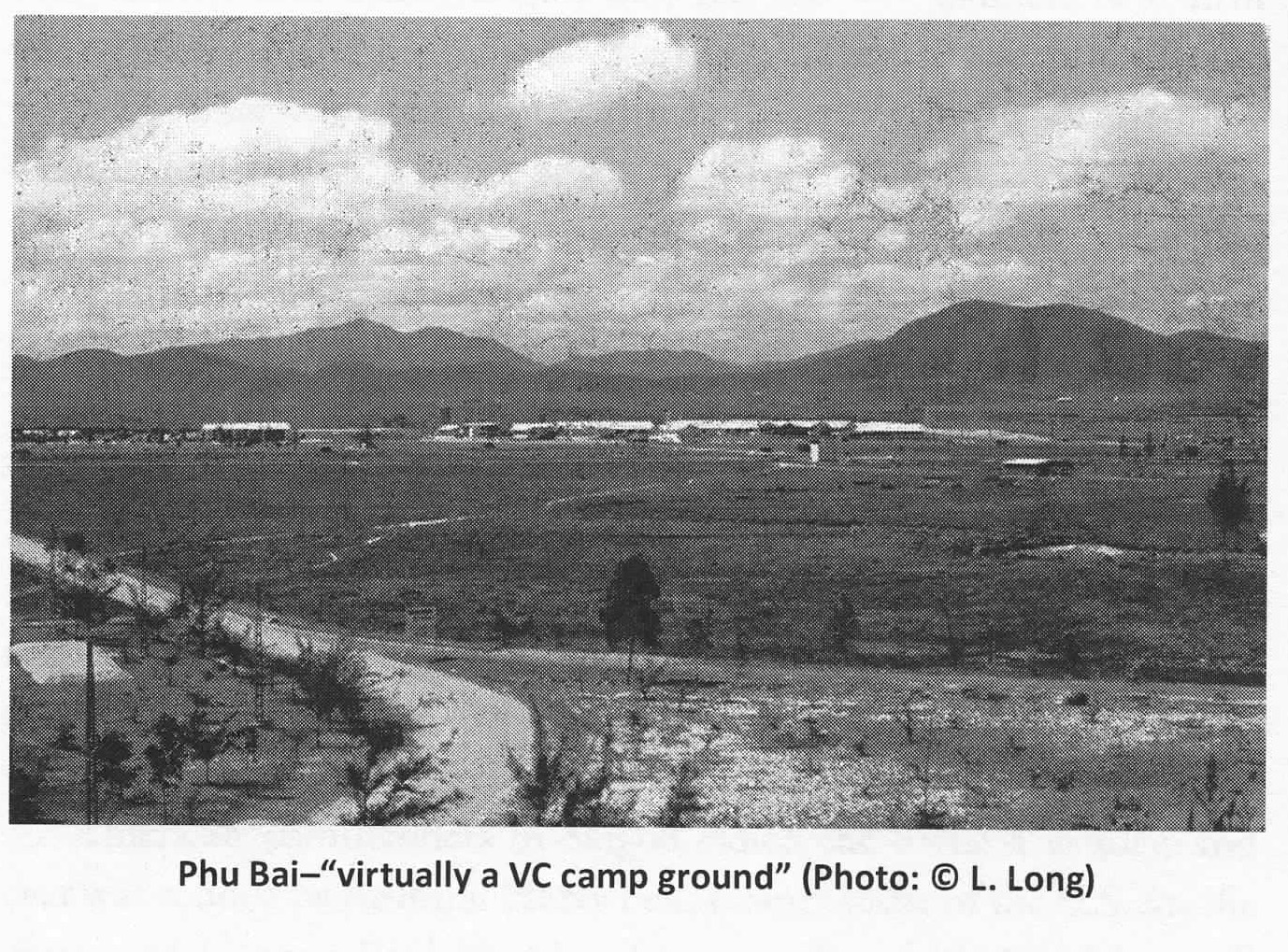
The value of the location was that it brought ASA’s surveillance capabilities closer to the fighting (and to North Vietnam, which it also monitored), but that also raised the dangers to Det. J. For the 3rd RRU , the expansion of Det. J provided a solution to the problem of what to do with me, a linguist with no available slot to fill in Saigon. So, in early 1964, I got orders to transfer to Det. J in Phú Bài.
At the time, I wasn’t aware of the earlier attack on Phú Bài, or the MACV “VC camp ground” designation, but I had heard that all members of Det. J were indefinitely confined to base because of the political agitation and anti-Americanism in Hue that had been triggered the previous year. A soldier stationed in Det. J wrote a letter to an ASA buddy in Taiwan dated 26 November 1964: “Yes, I’m in Vietnam and it’s hell. I’m in the northern part of the country outside of a town called Hue. I work straight days and train every night. … The VC haven’t bothered us yet, but frankly we expect to be hit before the first of the year. …There is absolutely nothing to do in town [Phú Bài] or on base and we cannot go out after 6:00 p.m. because the VC controls the area at night.”12

The idea of not only being separated from Mai, but isolated in a backwater encampment did not appeal to me. This new development accelerated our plans for marriage. I went to the 3rd RRU company commander to inform him of my intention to marry a Vietnamese national.
He was dumbfounded. I had only been in Vietnam a few months and was already contemplating marrying a local? The C.O. was sure that it must be a case of momentary infatuation with a bar girl. He didn’t need to remind me by marrying a foreign national that I would lose my cryptographic clearance (though I would retain my top secret clearance), and would be transferred out of the Army Security Agency (and, therefore, the 3rd RRU). I explained our situation, that Mai was a graduate of Georgetown University and that we had known each other for over two years. With reluctance he allowed the Army procedures for approving a marriage to be set in motion.
What followed was a real education about the constraints of citizenship and military regulations that most Americans never have to confront in their lifetimes despite all the complaints about government overreach. Combined with the Vietnamese government red tape, by the time we were finally married in a civil ceremony at the Deuxième Arrondissemont (Quận Nhì) we had been forced to jump through countless bureaucratic hoops. Mai has vividly described the tedium and frustration of this process in her book. I was outraged that the Army had arrogated the right to intervene in one of the most important decisions an individual can make. I accepted that the duty of a citizen was to pay taxes and be drafted and, if the government so chose, sent off as cannon fodder, but I emphatically did not agree that it could dictate whom I could or could not spend my life with. I fleetingly considered the possibility of renouncing my citizenship in protest, but the thought passed as quickly as it had come.
I didn’t learn of the crowning absurdity of the process until many years later when Mai mentioned it in her memoir. She was called in for a counseling session with a military chaplain – something I also thought was a governmental overreach, since the army was using the cloak of religion to disguise its methods of obstructing marriages of service personnel which it felt were inconvenient to the army’s mission. But when I learned much later what the chaplain had actually said to Mai, I must admit I found it uproariously amusing. He knew all about the perils of mixed marriages, he advised her. “I myself am married to a Norwegian!” (E.g. an American of Norwegian descent, who were looked down on by the Swedish-Americans like the chaplain). No comedian could make this up! It was a perfect example of the Freudian concept of the narcissism of small differences. I don’t mean to make light of the seriousness of the issue of inter-racial marriage at that time. Although I didn’t know it then, until the Supreme Court struck down Virginia’s anti-miscegenation law in the case of Loving v. Virginia in 1967, inter-racial marriage was a felony in my own home state.
Eventually the army ran out of delaying tactics and gave the necessary approval. So, accompanied by Mai’s father and two Vietnamese witnesses from my new workplace, the Translation Section of J-2 MACV, and a consular official from the U.S. Embassy to witness the event and provide the official certification of the marriage, we were wed on March 3, 1964. Despite the fact that I indicated that I spoke Vietnamese, the Saigon city official insisted on conducting the ceremony in French, the only proper language for dealing with foreigners in the eyes of the Vietnamese civil service, who had been formed in service to the colonial regime. The consular official somewhat sheepishly passed on request from CBS television to include us in a short piece that it was doing on “war brides” in Vietnam, but he readily agreed with my response that this was an invasion of privacy.
In addition, I thought it insulting to include Mai in the “war bride” category along with the bar girls who constituted the largest number of Vietnamese marrying Americans in 1964. It was bad enough that walking down the street in Saigon together, the automatic assumption of the passers-by was that any mixed couple could only be a GI with a bar girl. Eventually we became resigned to the inevitable comments “Mỹ với đĩ” (“there goes the American with the prostitute”) and even, in time, began to find them amusing, and turned them into a shared private joke. Every time we passed another mixed couple I hummed the melodic line that followed the contours of the Vietnamese tones of Mỹ với đĩ. In the absence of the words, only Mai knew what this tune meant. Nonetheless, the inevitable perception of any mixed couple on the streets made us keep our public appearances together to a minimum, and ruled out any public display of affection. The disparaging commentary was ubiquitous – but sometime amusing. Once on a very hot mid-day, Mai and I were walking from our apartment on Hai Ba Trung to her college room mate’s nearby house on Yen Do. There was no traffic on the street and only one other living soul out in the mid-day sun, a kid who was probably nine or ten years old. As we passed, he continued to squat down and play some game in the street. Without looking up he muttered “Năm trăm đồng một cú” so softly I had to ask Mai to repeat what he had said. She told me. It translates to “500 piasters a shot.” That was about five US dollars at the black market rate, but obviously a formidable sum in the view of this kid. Mai was not amused, but I told her she should be flattered at the knowledgeable evaluation, which put her in the poule de luxe class.
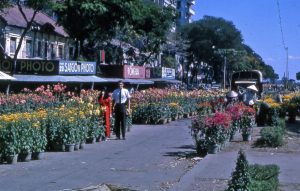
Tet flower market on Nguyen Hue street February 1964.
Mai has described the negative reactions of her relatives to our impending marriage, leading some of the clan elders to threaten a boycott of the wedding reception which would officially launch us as a married couple in Vietnamese society. In the end, curiosity got the better of them and the reception at the Dong Khanh restaurant in Cho Lon was well attended by members of her extended family. Some of her American-educated Vietnamese friends were also there for moral support.
Mai’s father carefully coached me in delivering a flowery toast to the assembled relatives in the Vietnamese equivalent of King James English. Somehow I managed to deliver the appropriate Sino-Vietnamese sentiments. “We, your niece and nephew, beg to thank you, the venerable elders for coming to witness our wedding today. This gives us happiness and great fortune….” (“Chúng cháu xin cảm tạ các cụ đã đến chứng kiến đám cưới của chúng cháu ngày hôm nay. Như vậy là hạnh phúc cho chúng cháu lắm….” Mai’s father’s coaching produced the desired effect, and the wedding turned out to be a great success – despite our unprepossessing arrival at the restaurant in a humble blue and white taxi which, to Mai’s chagrin, looked “like a frog on wheels” rather than the customary rented oversized rented 1950s vintage American car with chrome and fins.

Dong Khanh Restaurant and Hotel 2018
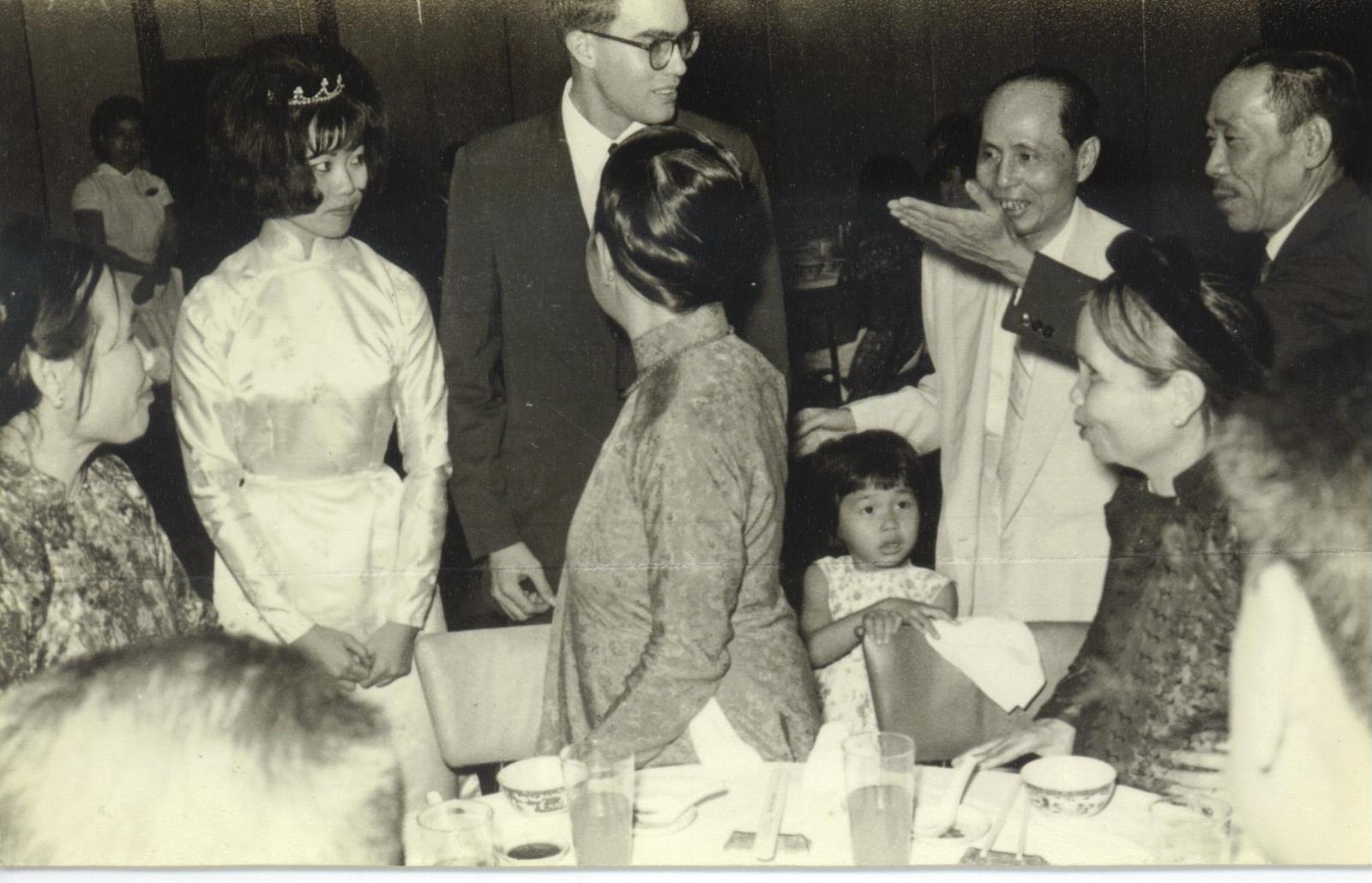
Mai, David, Mai’s Father and clan relatives at wedding reception 1964.
After I had informed the 3rd RRU of my plans, I was in limbo for over a month. The 3rd RRU shopped me around to various US military units but, astoundingly, no one seemed to have any use for a soldier fluent in the Vietnamese language. Perhaps this was an early indicator of the scant regard the US government had for equipping itself to hear and understand the Vietnamese point of view. I moved from Davis Station to a downtown hotel to await further assignment. The Metropole Hotel was conveniently located, but given the number of transient soldiers who kept odd and irregular hours the shades in the rooms were always closed. The frigid air conditioning was an initial relief, but eventually combined with the dark gloom to provide an environment that was totally isolated from its surroundings – which further contributed to my sense of isolation as I awaited a determination about my future. The centrality of the Metropole also made it an attractive target for terrorist attack. In December 1965 a truck bomb exploded outside the hotel, killing 175 people, including 72 Americans. By that time, fortunately, I had moved out. I was also gone from the 3rd RRU by the time two of its members were killed by a bomb at a nearby field while playing softball.13
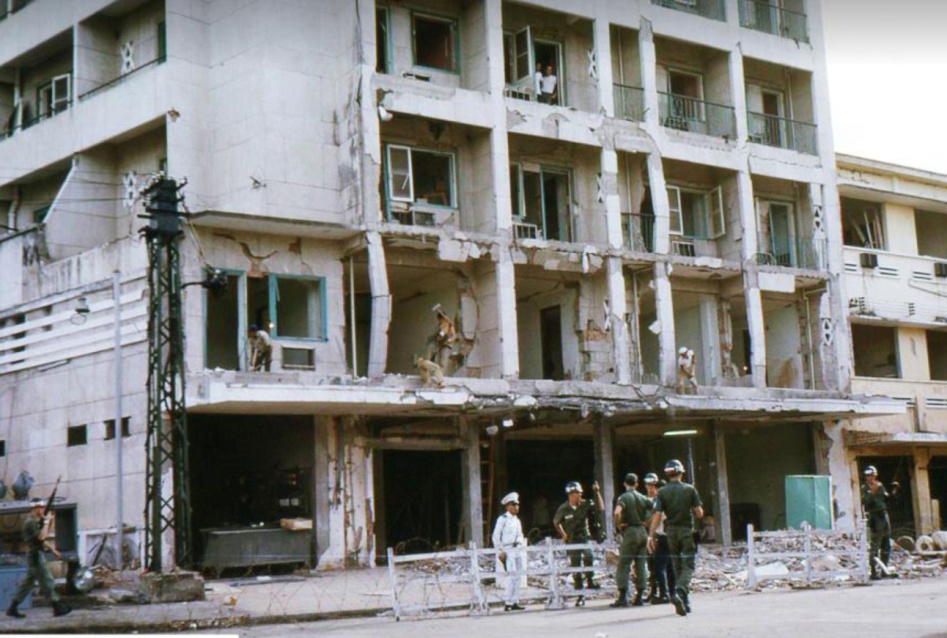
Bomb damage at Metropole Hotel, December 4, 1965.
If you were to try to find the traces of the Metropole today, this is what you would see.

Hotel Pullman, Saigon, 2016
Saigon in 1964 and 1965 was the target of a number of terrorist bombings of buildings. One of the first was in February 1964, when a massive explosion demolished large parts of the Kinh Đô movie theater. Three Americans were killed and 34 wounded. Jim Potratz, who would soon be my boss in the MACV Translation Section was there with his young son. Jim recalls that “I went with my oldest son then 4 years old. I sat way in front with him on my lap when I heard the three or four shots, turned around and the doors blew in. After a few minutes we exited by the side doors. Two weeks later, the MR-4 [Viet Cong Military Region 4, which included Saigon] staff assistant was captured carrying the after action report on the Kinh Đô — it described how they came (taxi controlled by them), one guy got out, shot the MP (kid from Milwaukee), and put the package (10 kilos?) inside the door and fled. Explosion killed 4-5 and wounded more than 50 (almost all from the air cons tacked up under the balcony).”14
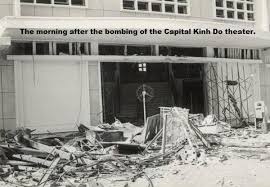
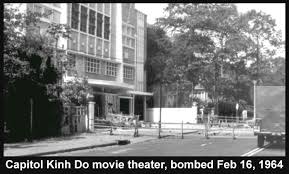
I was soon to meet Jim Potratz, who had fortunately survived the Kinh Đô bombing and would be my new boss. Finally, the 3rd RRU negotiated my transfer to the Translation Section of J-2 MACV, the military intelligence branch of the Military Assistance Command Vietnam (MACV) which had been established in February 1962 as part of the Kennedy escalation of American military involvement in Vietnam. We moved into a small second floor apartment rented from a Chinese-Vietnamese landlord, not far from the Tân Định market on Hai Bà Trưng street.
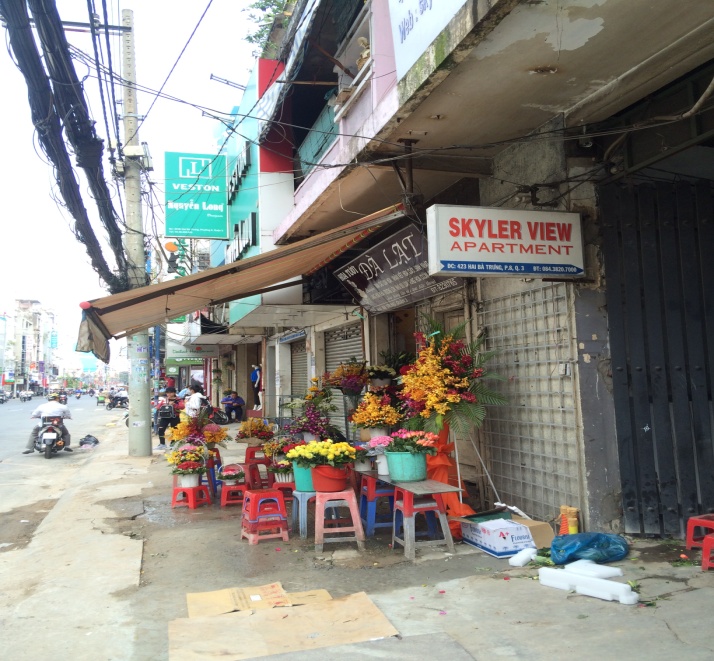
Apartment complex at 423 Hai Bà Trưng 2016. This was our first “home” in 1964. Our apartment is on the second story above the awning.
The one bedroom apartment on the second floor had only enough room for a small table, and a kitchen which overlooked the back alley. It was Spartan living, but it was our first home.
We didn’t expect to receive any visitors in our cramped apartment in a run-down section of Saigon, but one day I heard a knock at the door. When I opened it I saw two striking young Vietnamese women, about Mai’s age, in glamorous ao dais. One of them introduced herself as Đặng Tuyết Mai. She wanted to see Mai she said. When Mai appeared to invite her in, she immediately recognized the future Mrs. Nguyen Cao Ky, well known in Saigon as a great beauty, who was regarded as a trend-setter in her upscale – as it was then regarded – job as an Air Vietnam Hôtesse de l’air or flight attendant.
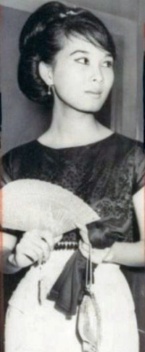
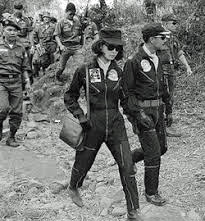
Đặng Tuyết Mai, soon to be Mrs. Nguyen Cao Ky, invited Mai to join her in a Saigon fashion show. 15 On right is a photo of Mr. Mrs. Ky ca 1966
Tuyết Mai and her friend said they had heard that Mai was one of the great beauties of Saigon, and invited her to join them in an upcoming fashion show. Mai was flattered by the recognition but, to her everlasting regret, turned them down.
Our second floor apartment, it turned out, was easy pickings for Saigon’s highly skilled “second story men.” One night Mai awoke from a deep sleep with the odd feeling that there was something amiss. There was a Saigon urban legend that burglars often used “knock-out medicine” ( thuốc mê ) – whether in powder form or as some kind of spray is not clear – in order to essentially anesthetize their victims so they can work undetected. I doubt this was the case – Mai had been awakened by mosquitoes who had come in through the screen door which she noticed was open. As we got up to investigate, a shadowy figure bolted across the room, through the screen door to the rear balcony and, in a flash, lowered himself down to the back courtyard of the apartment complex on the drain pipe he had used to climb up – obviously someone who knew the neighborhood well. I immediately discovered that he had rifled through my pants and fled with the pants and my wallet. I rushed to the window and yelled down at the fleeing figure “trộm!” [burgler]. There was, however, no one around to hear, let along do anything, and after he had run a safe distance, he paused. I still remember his silhouette backlit by a lone street light as he momentarily froze in a scarecrow-in-the-field posture while he contemplated his next move before disappearing down an alley. Mai later found my pants and wallet on the street (minus the small amount of cash taken by the burglar).
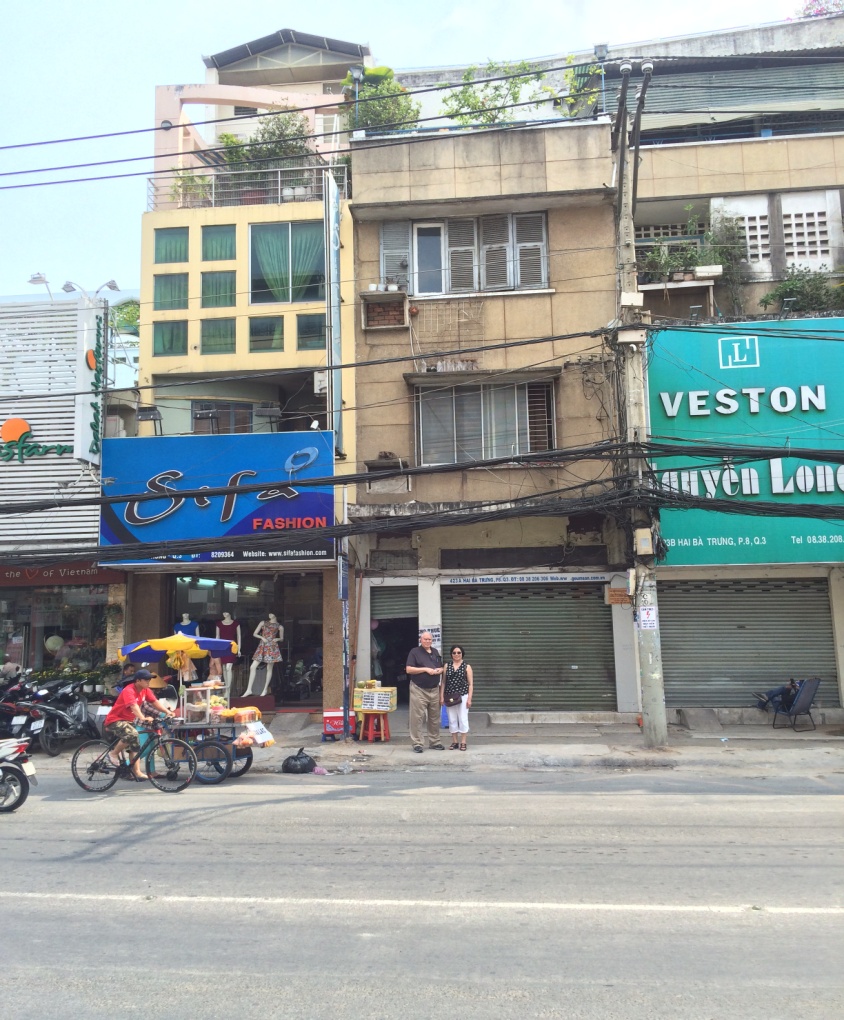
Our second floor apartment, 423 Hai Ba Trung in 1964
The only other time in Vietnam I was the victim of petty crime was around this time. As I was walking along the sidewalk on a block of Le Loi street where a string of used bookstores were set up side by side, covered by awnings that created a kind of long tunnel. Jammed in among a tightly-packed crowd, I felt a tug at my shirt pocket, and saw that someone had grabbed my case with prescription sun-glasses and was trying to flee through the crowd. Amazingly, he did not get far. A small group of students who were outraged by the spectacle of bad behavior and the shame they felt about the bad image of Vietnamese this act of thievery would create, grabbed the thief, confiscated his loot, and returned it to me without comment, after giving the thief a sharp reprimand. I thanked them profusely but they unsmilingly waved it off and went on their way. They were doing it to uphold their own standards of acceptable behavior, was the message, and not to please an American. I understood the sentiment but at this period of widespread anti-Americanism, especially among students, I was surprised and touched at their intervention. They could have simply let it go and taken satisfaction that the American got what he deserved, which is what the Vietnamese cop described below would have done.
I eventually bought a Honda motorcycle to commute to the Tax Building in central Saigon, where I had taken up my new job at the Translation Section of J-2 MACV.
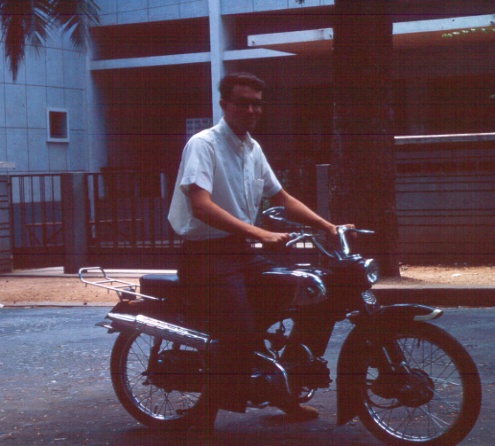
I had learned through the grapevine that a Military Policeman about to rotate back to the US wanted to sell his Honda 90 motorbike. So I took a blue and white cab five kilometers across town to the MP barracks in Cholon and purchased the bike. This was in an era when Hondas were an extreme rarity. People visiting Vietnam today experiencing the wall-to-wall motorbikes throughout the country might be astonished to know that there were, at most, a few hundred Hondas in Saigon in 1964, most owned by Americans, since Vietnamese were forbidden to buy them to conserve scarce foreign exchange, and had to be content with the motorized bicycle (moped or “mobylette”) which was the high status vehicle at the time. I would guess that there were no more than 100 such Hondas in Saigon when I purchased mine.
After a cursory five minutes of instructions on the gearshift, I wobbled off on my ride back across town. I had never ridden a motorcycle before and the challenge of coordinating balance with shifting gears and handling the brakes while negotiating chaotic Saigon traffic was formidable. Nevertheless, I made shaky progress until I reached the Scylla and Charybdis of Saigon traffic, the feared Ngã Sáu intersection through which most cross-town traffic had to pass. The following video clip provides a rough approximation of mad chaos that prevailed at this roundabout into which six of the major streets in Saigon fed. https://www.youtube.com/watch?v=mr5Gssaxl6g It was a roundabout that seemed to be designed by the Three Stooges for comedic effect. There were no right of way rules and every vehicle seemed to be headed across the flow of traffic (such as it was) at different angles.
After I had managed to enter the Ngã Sáu and had traveled about a quarter of the circumference, I had to escape the circular flow to make a turn, exiting the roundabout onto Hồng Thập Tự (the current Xô Việt Nghệ Tĩnh) I saw a young man slowly and unsteadily coming toward me an a bicycle, carrying an elderly man – probably his father – on the handlebars. He was unable either to stop or, evidently, to avoid me and ran into my rear tire, toppling to the ground in the process. I managed to remain upright and stopped my Honda right in the middle of the sea of swirling traffic.
Despite the traffic, a crowd quickly formed around the accident scene comprised mostly of people who were themselves on bicycles. The young man on the bicycle was loudly proclaiming that he had been grievously injured despite the fact that he and his father were unscathed because they were almost at a standstill when they ran into me. The crowd came to his support, but I said (in Vietnamese) “if you and your father are seriously injured we must get you to a hospital right away.” This gave the young man pause. He didn’t want (or need) to go to a hospital. He wanted a cash settlement from me. The Greek chorus of a crowd however, had muttered its collective approval. “Yes, get them to a hospital quickly.” The situation, which had been heading south for me, briefly froze as a result of my offer to take them to a hospital.
This incident happened at a time of great political tension and rising anti-Americanism. Moreover, the Honda itself was an emblem of American treaty-port privilege, since Vietnamese could not buy them. The fact that I was dealing with the situation in Vietnamese bought some time for what might have escalated into an ugly confrontation. Soon a “white mouse” policeman (e.g. an ordinary cop on the beat, known for their white uniforms) appeared on the scene. After some conversation, punctuated by the “victim’s” demand for compensation, it became clear that I was the one who had been run into, rather than the reverse. What followed was my first introduction to the counterpart of “situational ethics” – “situational law enforcement.” The cop acknowledged that I was the one who had been run into, but said (I can no longer remember the exact words) “Come on – you’re a rich American. Just give them some money and we’ll call it square.” Which is what happened. I am sure in advising me to pay up and get on with it, the cop used what became my favorite Vietnamese phrase “làm cho xong chuyện” – just do it to get it over with. I appeared at the police station the following day and handed over a small (“solatium” or consolation) payment and we all went our respective ways. I guess I was fortunate to avoid an ugly mob scene in this time of rising anti-foreignism, and to make it safely the rest of the way home on my prized Honda. Needless to say I did not risk riding it to the police station the next day, and took a cab instead.
New Assignment – the MACV Translation Section
By this time I had emerged from limbo and had taken on a new assignment at the Translation Section of J-2 MACV. MACV was a proto-command headquarters, whose very existence implied that American combat units would eventually follow and which would supersede and subsume the modest Military Advisory and Assistance Group (MAAG). Unlike MAAG, MACV was a command headquarters which would be capable of directing American combat troops, should they be sent to Vietnam. Its establishment was a critical step in the escalation toward direct military involvement in the conflict. This was the primary reason that the Soviet Union and China, who had been uninterested in Vietnam until early 1962 when MACV was established, and they suddenly turned their attention to what had been, until then, a side-show of the Cold War.
MACV’s first headquarters didn’t have the appearance of a military command. It was on a leafy street in a residential area of Saigon.
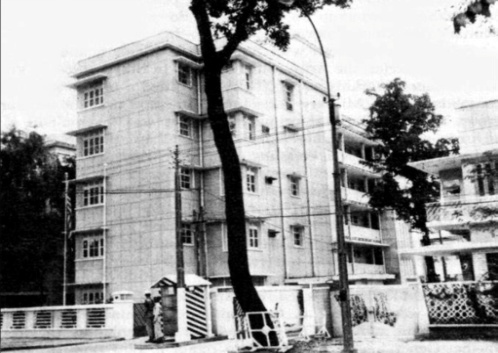
MACV Headquarters 147 Pasteur Street, circa 1963.
Because the entire command headquarters had to be housed in a converted residential villa, space was at a premium. So the Translation Section which belonged to MACV J-2 (“J” indicates a command branch – operations, intelligence, logistics etc. above division level and “2” was the traditional designation of the intelligence branch) was established on the top floor of the Tax Building, a commercial arcade in the center of downtown Saigon.
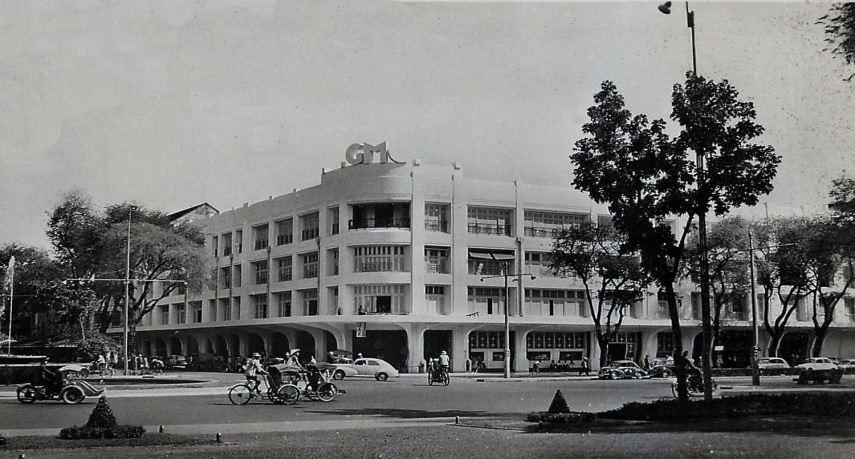
Tax Building, corner of Le Loi and Nguyen Hue, 195os.
When I arrived there in early 1964, the operation of translating captured Viet Cong documents was housed in a complex of two large rooms in the back part of the top floor of the commercial arcade known as the Tax Building. Jim Potratz, who as an E-6 or sergeant on his second tour of duty in the Army was in charge, and the only other American there.
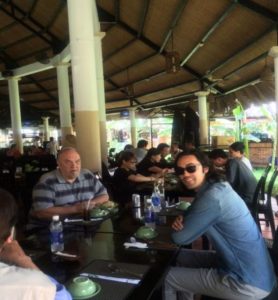
Jim Potratz and Bryan Elliott in My Tho restaurant 2018. When we met for the first time in over 50 years, Jim looked at Bryan and said “I recognize this guy, but not you,” referring to the fact that in 1965 I had my son’s silhouette but had gained nearly a hundred pounds in the interval.
In a 2016 email Jim provided some recollections of the early years of the translation section. “MACV was formed in Jan 1962. I presume the translation section was created months later. As far as I know the first chief was an Army captain who graduated from ALS (Army Language School) a couple of classes before me (circa March 1962), and left the translation section in February-March-April 1963. He didn’t want the job but was forced into it. I think Tax building was the first location. A couple of other oddball MACV sections were there with us but left. … It was formed with a local staff of six translators and two typists. The US side had an O-3 slot for chief plus one enlisted slot. Later additions like you and [Gale Halvorsen] were not in slots.” So, in a sense, I was still a transient without an official slot in the Army’s TOE [ The Table of Organization and Equipment]. The TOE is a document that prescribes the wartime mission, capabilities, organizational structure, and mission essential personnel and equipment requirements for military units.
In the chaotic transition year of 1964, however, the lack of a formal position for me was overlooked because J-2 was desperate to find people who could help the overstretched Translation Section function. At a time when the Army had few independent intelligence sources (apart from the signals intelligence of the Army Security Agency and its own modest network of military advisors reporting on what was happening in their areas) captured documents provided a valuable and unique insight into Viet Cong operations and intentions. But in order to make them useful for intelligence analysis, they had to be translated. My job was to help Jim Potratz oversee and edit the translations for accuracy and readability.
In this sense, the Translation Section constituted a bottle neck constricting the flow of vital intelligence from the field to the headquarters analysts at J-2 MACV. The original six translators and two typists simply couldn’t keep up with the rapidly escalating demands for analyzable documents. Thus there was pressure for some modest growth in numbers, but by the end of 1964 the number of Vietnamese translators never exceeded a dozen, and the number of Americans overseeing the translations was never greater than three – all enlisted men.
Naturally the direct American intervention caused a dramatic expansion of the Translation Section, which moved to a new building near the airport in October 1966 to house the dozens of Vietnamese translators. Rather than a backwater overseen by a lowly E-6, By this time it was commanded by a Lt. Col., processing millions of documents a year.
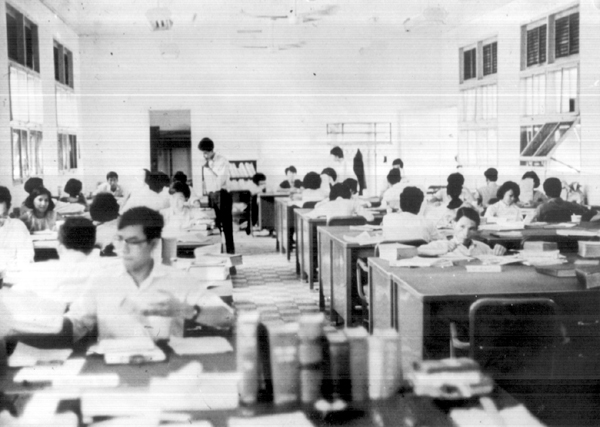
Vietnamese translators in their new office near Tan Son Nhut, J-2 MACV, circa 1966 http://webdoc.sub.gwdg.de/ebook/p/2005/CMH_2/www.army.mil/cmh-pg/books/vietnam/mi/ch02.htm
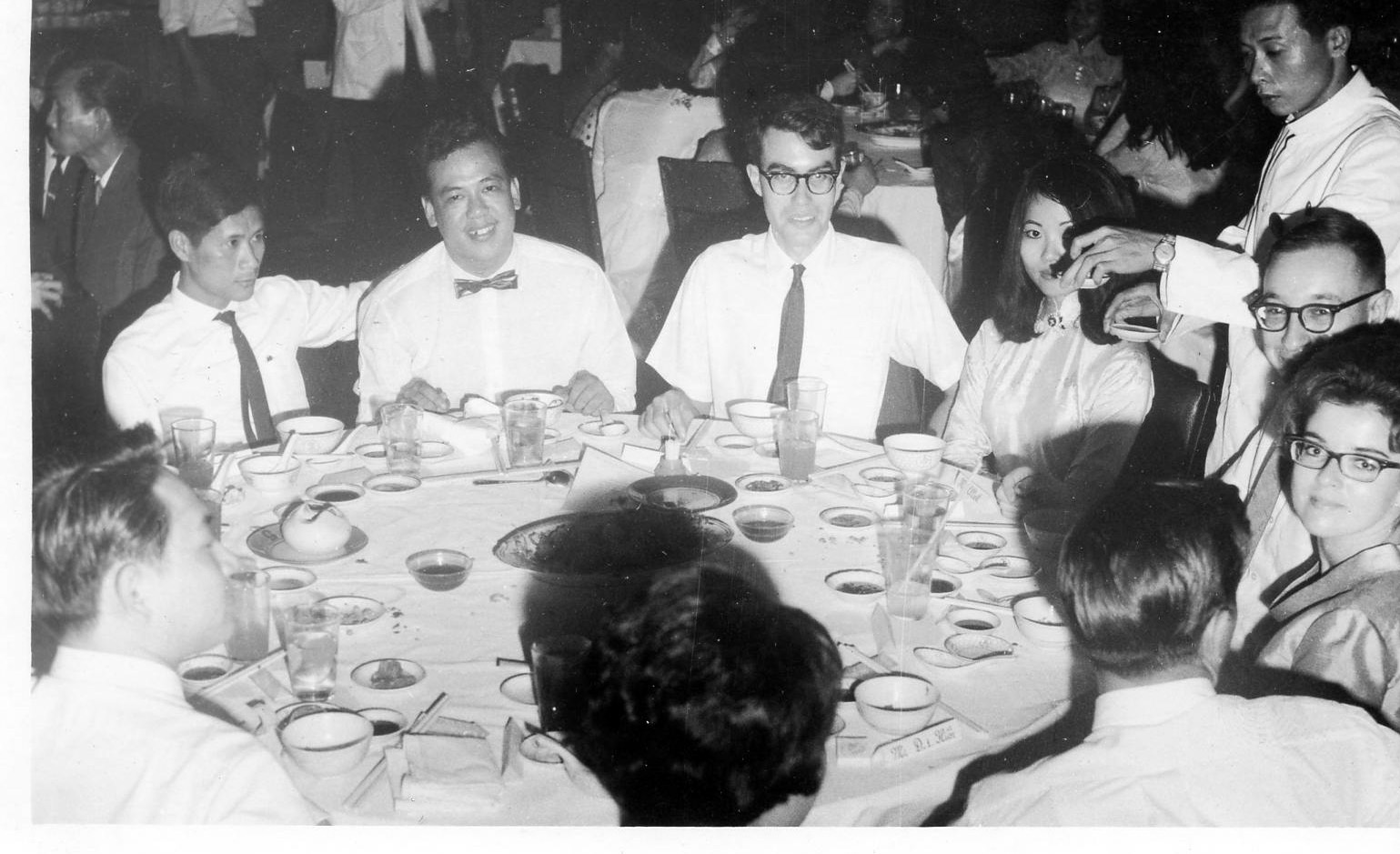
Translation section employees give a farewell dinner for Mai and me. Trần Văn Nhơn is to my right. The Morells are to Mai’s left
During most of 1964, however, we were largely left to our own devices, because our nominal superiors realized that they knew nothing about how to run a translation operation, and were satisfied to leave us alone as long as we produced. In fact, they further recognized that trying to impose standard army discipline on us would probably reduce our effort to a lowest common denominator of military mediocrity and throttle the flow of documents to them. Not being in a regular military unit, we were spared much of the scut work of enlisted military life – KP, inspections, etc. Our only duty along these lines was periodically bagging up the classified trash generated by our very substantial volume of translated and mimeographed documents, and taking it to a nearby ARVN base to burn – a task that, like overseeing Vietnamese painters at the 3rd RRU, could not be delegated to anyone without a high security clearance.
The overall commander of the Translation Section was the head of the Collections Branch of J-2, the inimitable Col. Jack T. Young, one of the most arresting personalities I have encountered in my eighty years. At the time Col. Young was reputed to be the highest ranking Asian-American officer in the Army. His military background was remarkable and unconventional. Born in Hawaii and a fluent English speaker, he also retained his fluency in Mandarin Chinese, as we sometimes had occasion to witness. In his youth, Jack Young had returned to China to take part in the exciting and turbulent events of the 1930s.
Like his brother Quentin, Jack was a professional guide and explorer. Quentin secured the first panda to be brought to the United States for society grand dame Ruth Harkness. Jack led a mountaineering expedition which scaled Minya Konka, and accompanied Kermit Roosevelt on his adventures in China.
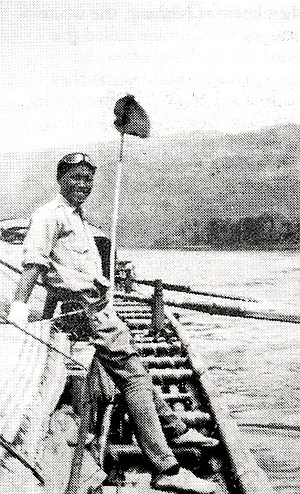
Jack Young in 1935
A 1990 article on the two Young brothers wrote: “Though [Quentin] Young was 22 at the time, he and his brother Jack, then 26, were among the more experienced naturalists in China, and they traveled through time and cultures. They were college educated ethnic Chinese, but their family had spent two generations in America — Jack was born in Hawaii — so they were neither Americans nor Chinese, yet both at once, ‘people adrift,’ as Jack says.”16
“Following the practical habit of the day, they chose English names to ease communication with English-speaking imperialists, who could not or would not deal with their Chinese names. Tai Jack became Jack Theodore and Ti-Lin became Quentin, both out of admiration for the Roosevelt family, whom Jack knew well. Their grandfather changed the spelling of the family name Yang to Young; coming from English lips, it was closer to the Chinese pronunciation and less grating to Chinese ears.”
“The brothers were dashingly handsome in their youth, a head taller than their Chinese contemporaries, wearing generous black pompadours combed straight back and well-tailored, modern suits over athletic bodies. Though they were sophisticated men living in Shanghai and New York, they moved easily into the Dark Ages of rural China of the 1930s. The sepia-tinged snapshots in Quentin’s photo albums depict village magistrates, warlords in full costume, a princess from a tiny kingdom called Kantze Sikong, vultures tearing apart human corpses in Tibetan funeral pyres, half-naked Lolo slave girls assigned to serve them, bandits he and Jack captured and delivered in chains to local authorities.”
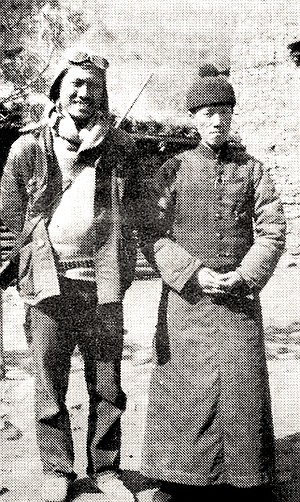
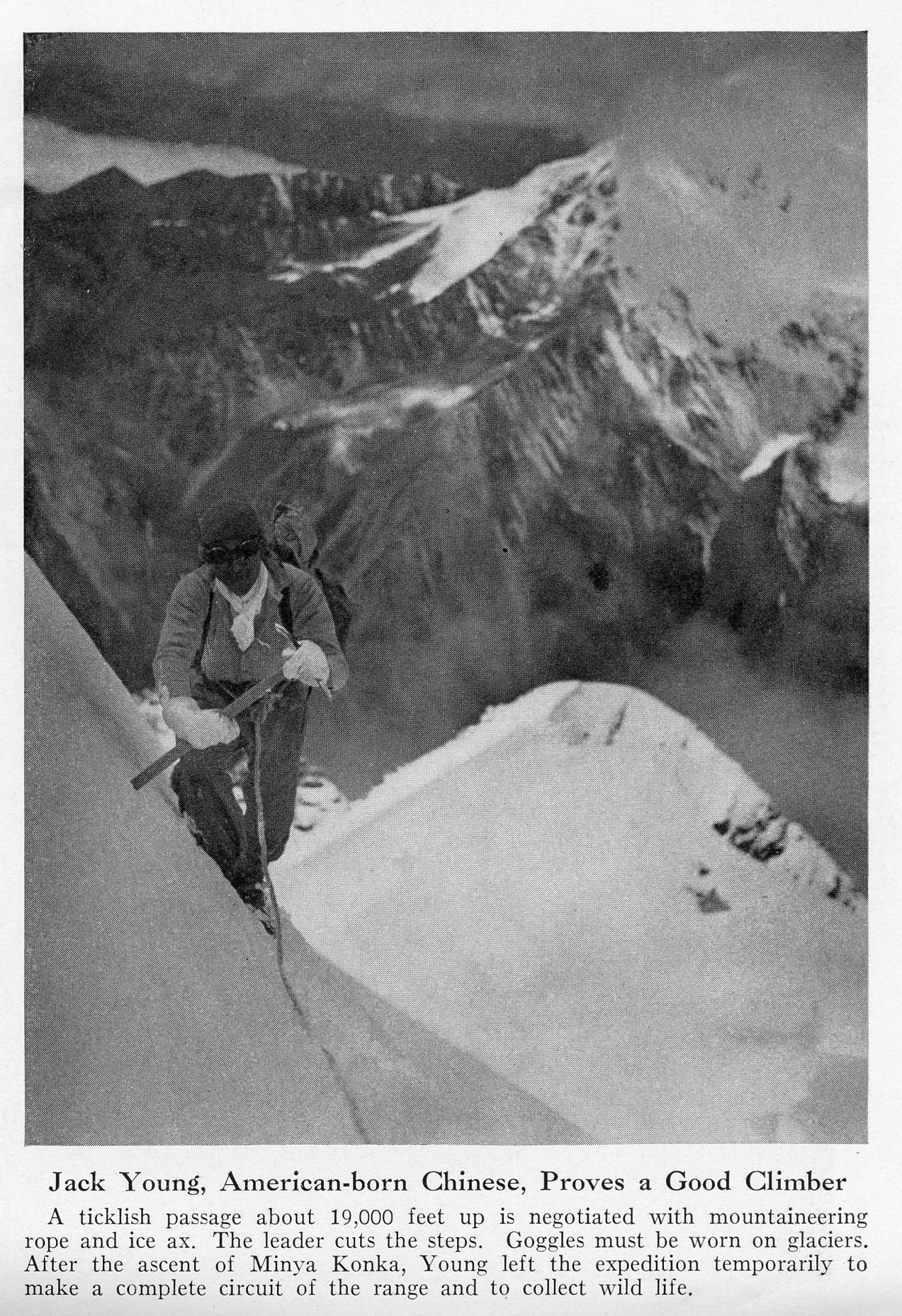
Jack with magistrate in Sikong, 1935 on right National Geographic May 1943
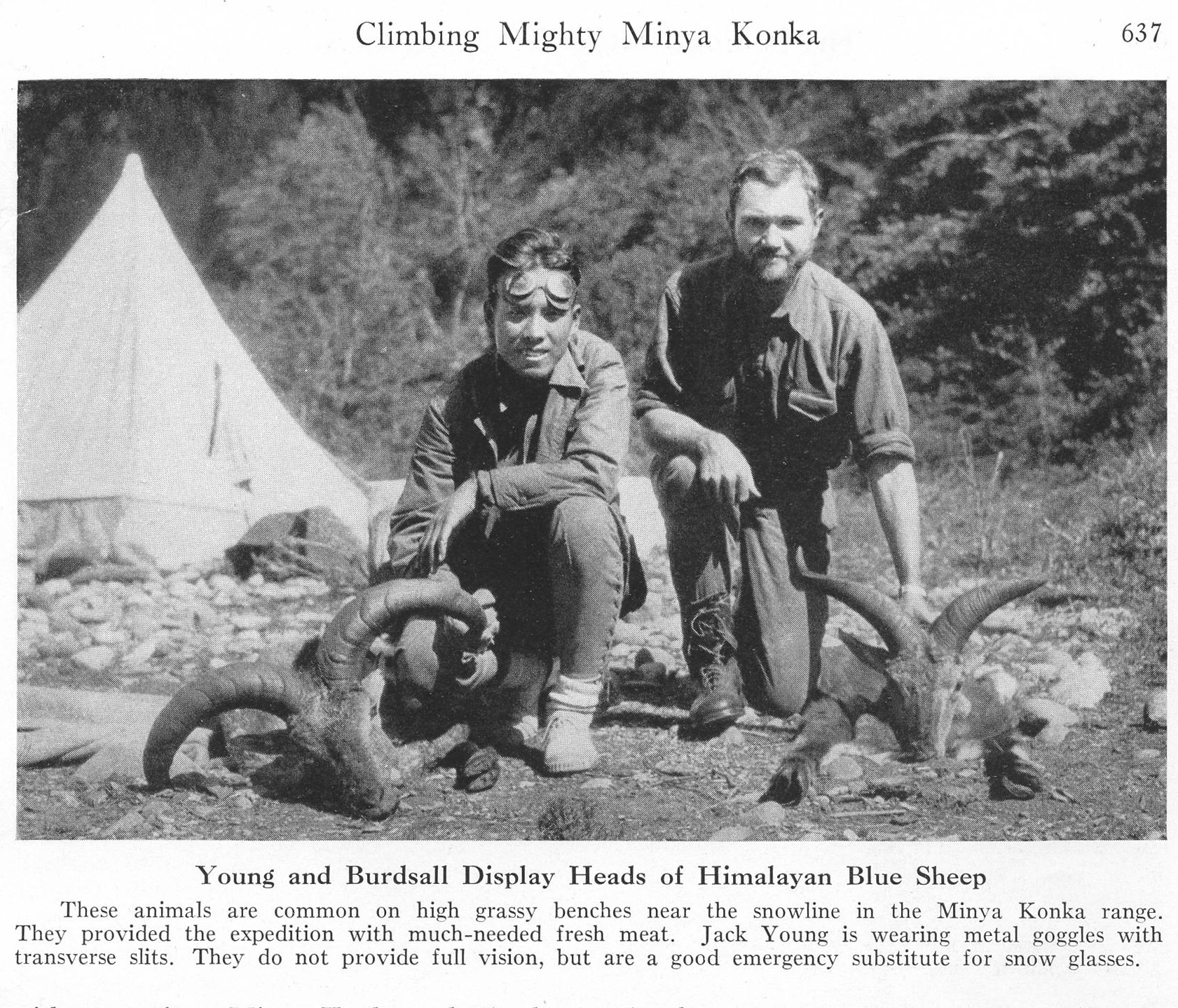
National Geographic, May 1943, p. 637.
“The Youngs were an enigma to the Tibetans and Lolo tribesmen who, as a matter of pride and profession, took advantage of foreigners and ‘downriver’ Chinese. ‘They didn’t know what to do with us,’ says Quentin. ‘We didn’t look like Americans, but we knew the ‘foreign devils’ language. We ate what the foreigners ate, but what they did too — rice, salt fish, tofu.’ Uncertain and intimidated, the locals helped them collect, shoot, or capture giant pandas, golden monkeys, takin, rare Chinese pheasants, and Tibetan flora for American museums or private collectors.”17
Jack’s resourcefulness and quick wit saved the expedition to Minya Konka, a 23,000 foot high mountain on the border between China and Tibet, when they were initially blocked by locals from their endeavor on the grounds that a previous explorer had brought bad luck. The leader of the expedition recalled, “Jack Young’s diplomacy now stood us in good stead. He told them that we had crossed the great water and made a pilgrimage of a whole year to visit this object of our veneration. With this plea and small contributions for prayers and the burning of incense, he finally reconciled them to our going>”18….Today, despite their age — Quentin is 76 and Jack is 80 [in 1990]— they are still big and little brother, much to their frustration, still as hotheaded as in their youth. In 1934, while crossing a high Tibetan mountain pass in a blizzard, they argued so bitterly that they pulled guns on each other and would have shot if Jack’s first wife, Su Lin, for whom the panda was later named, hadn’t thrown herself between them.”19
A lengthy 1990 profile of Jack Young and his brother Quentin in the San Diego Reader recounts Jack’s remarkable life as a game hunter and adventurer. “….Quentin Young ceased to be an explorer and naturalist when the Japanese invaded China a few months after Harkness’s departure, and he reluctantly followed his older brother Jack into a career of espionage. And so in the end, the story ceased to be a fairy tale and turned modern, more like a tragic, improbable television miniseries script, full of spies and bandits and historical figures.”20
In view of the clear exaggerations of his role in Vietnam, one must be somewhat cautious in taking all of this oral history at face value – though the China and Korea parts can be independently confirmed.21 The article continues “In 1953, Jack Young was stationed with the U.S. Military Advisory Group to Chiang Kai-shek, and it was the first the brothers had seen each other since the late 1930s. Quentin has a photo that marks the occasion, Jack in his major’s uniform, Quentin smartly turned out in a sport coat and trousers, astride a see-saw in a playground.”
“Jack had risen to the rank of major general in the Chinese Army but was drafted into the U.S. Army after Pearl Harbor and made a second lieutenant. He claims that he served briefly as an aide to General Joseph Stilwell, who headed the American military presence in the China Theater. (Barbara Tuchman in her biography of Stilwell mentions a young captain named Dick Young, a Hawaiian-born Chinese in Stilwell’s office, perhaps a mistaken reference to Jack.) He asked to be transferred because of Stilwell’s racism. One day in Jack’s presence, Stilwell muttered how ‘these Chinamen can’t do anything right.’ Suddenly realizing Jack was there, he said, ‘Oh, but you’re different.’ Jack replied, ‘No, I just speak English.’ So Jack went behind Japanese lines as an intelligence officer, establishing safe houses and planning escape routes for downed Allied pilots. His wife claims to have heard him mentioned in a radio broadcast by Tokyo Rose — journalists came to interview her as ‘the girl left behind.’”
“During the Communist Revolution in China, he worked as an aide and interpreter to General George Marshall and also as go-between for Chou Enlai and Mao Zedong, Marshall, and Chiang, which required him to live with Mao and Chou in a cave in ‘Yenan. Jack also befriended Yeh Chien-ying, a principal Communist Army general. Yeh turned to Jack for help when his daughter was arrested by Chiang’s police. Jack intervened with Marshall and had an American plane pick her up and spirit her away.”
The connection with Yeh Chien-ying (Ye Jianying) can be verified by my personal observation. Col. Young rarely came to our offices in the Tax Building, but one day he swept in unannounced. He cut a commanding figure in his tropical dress shorts and dramatic presence. Jim and I leaped to attention, and Col. Young proceeded to inspect the work of the office. Coming to the desk of one translator, it turned out he was working on a report from Hanoi about the visit of Ye Jianying – an important indicator of Chinese support for North Vietnam. The translator was stumped about how to render the Vietnamese rendition of his name (Đào Diệp Anh) into the then-standard Wade-Giles English phonetics. Without skipping a beat, Col. Young whipped out his wallet and extracted a photo which had a Chinese inscription (verified by the translator who could read Chinese – no doubt the characters were Col. Young’s Chinese name 楊帝澤) “Best Wishes to my good friend Jack Young.” I was floored at this connection between Col. Young and one of Mao Zedong’s closest associates and, of course, had no idea what the background of this remarkable photo was until much later. Of course this dramatic display of the photograph was of little help to the translator trying to find the right Wade-Giles transliteration, but it made a deep impression on all of us.
The San Diego newspaper profile continues: “In Korea, Jack led an unconventional warfare force with a division of Rangers, South Koreans, and turncoat North Koreans. He trained his troops in unconventional warware.

MAJ Jack T. Young, 2nd ID Ivanhoe Security Force commander, demonstrates silent kill, close combat techniques to ROKA students. 1st Ranger Company SGT Robert W. Morgan (tee shirt) is behind Young. https://arsof-history.org/articles/v9n1_culture_language_page_1.html
Jack led the first US recon unit into Pyongyang

Major Jack Young https://arsof-history.org/articles/v9n1_culture_language_page_1.html
Jack’s ingenuity and language skills in the Korean War are vividly described by Charles H. Briscoe https://arsof-history.org/articles/v9n1_culture_language_page_1.html[2]
His presence in Korea did not go unnoticed by the Communist Chinese, who arrested his parents, then broadcast an open radio message to Jack, stating they would be released if Jack defected to the Communist side. Jack’s mother wrote to him, describing how his father hid behind a trap door in the attic but surrendered to the police when they started to beat her. They took him away with a rope around his neck. Anticipating her own arrest, she signed the letter “your mother’s last command written under the light of the candle.” Jack keeps the letter framed on the wall of his study. On the facing wall is a framed letter from Mao, its characters big and messy in comparison with his mother’s fine and orderly hand.”
“Jack attempted to exchange the Communist officers for his parents, though he had no authority to do so. ‘I had lots of prisoners I didn’t even turn in,’ he says with a toss of the hand. ‘Don’t forget, I am an unconventional force, not bound by rules.’ But the deal did not go through, nor did a personal appeal to his friend General Yeh. Jack and Quentin’s parents starved to death in prison in 1952.”
“Jack met his current wife June, a Pentagon military historian, in 1954 in Quemoy; they were married in 1956. In the early 1960s, Jack went to Vietnam for two years as an intelligence officer, still operating behind lines. (‘I had a hell of a time convincing them that I am no gook,’ he says of that duty.) He retired from the Army as a full colonel in 1971. He had earned two Silver Stars, three Bronze Stars, and three Legion of Merit medals. He pondered returning to Vietnam to earn his general’s star, but Quentin talked him out of it. “You are getting old,” he told him, “and things are not good over there. Is it worth it if all that returns with a general’s rank is your name?”
The canard about “operating behind enemy lines” makes one wonder how much credit to give the rest of the life story of this flamboyant man although, as we have seen, most of it can be independently verified. Jack rarely left his MACV office except to go to Cholon to mine his Chinese contacts there for tidbits of information in order to reinforce the story he told his superiors that he was the best positioned to understand the Chinese role in Vietnam.
I made my bones with Col. Young when he called me in one day to solve a problem that required local knowledge. He had a dinner appointment in Cholon that evening at a restaurant-night club. He could not recall anything more than that it had an exotic non-Vietnamese name. Given Col. Young’s extreme sensitivity to one-upmanship, it would have been an unacceptable loss of face to have to go back to his host with the admission that he had forgotten the venue. Fortunately, I was somewhat familiar with the nightclub circuit, thanks to Mai, and I immediately guessed, correctly, that it was the Arc-en-ciel. This put me in his good graces for the rest of my tour.
Jack Young’s stories about Chinese in Vietnam no doubt met a receptive audience, since it was an article of faith among the American military that it was the Chinese who were behind the Viet Cong and their allies in Hanoi. In fact he would occasionally create a stir, as I witnessed once on a visit to MACV headquarters by reporting that his Chinese sources had a confirmed sighting of a People’s Liberation Army officer taking an active role in the insurgency in Central Vietnam. Of course, nothing ever came of it.
I witnessed one of his staged performances collecting intelligence on China’s role. One day he told me to stick around the Translation Section office after everyone else was gone. I was on tap for a job which he thought might require my undeserved reputation as an expert on Saigon as a result of the Arc-en-ciel episode. He would require my language skills to verify any Vietnamese personal or place names which might crop up in conversation with the Chinese informant from Cholon who he was going to meet, using the Tax Building office as a safe house for the rendez-vous. So I stationed myself in the darkened inner room and waited for the informant to arrive. When he did, I could not see the interaction, but I could hear the transformation of Jack Young from an imperious American colonel barking out crisp orders, to something which was almost a caricature of the devious Oriental, with a hissing intake of breath preceding every menacing sentence he directed at his interlocutor. It was great theater, but I doubt if anything came of it. My presence, in any event, proved superfluous.
Despite his tendency to exaggerate his own exploits there is plentiful documentation for his extraordinary career as an explorer and adventurer in China, as a wartime liaison between the Communist Chinese leaders and the United States and his later liaison role with the Chiang Kai Shek forces after they fled to Taiwan. Equally remarkable was his career as leader of a commando reconnaissance force in Pyongyang during the Korean War. He had a swashbuckling aura that made every encounter with him memorable.
His subordinate officers, who were the intermediate link between Jim Potratz and myself in the Translation Section, also worked in his offices in MACV headquarters were somewhat lower-key. Capt. Charles (Chuck) Cattenach was an even-keeled officer, who did not attempt to fabricate a “command presence” and interacted with his subordinates with casual ease. This adversely affected his career prospects. He remained in the grade of captain for many years and eventually was forced to retire at that grade. Chuck Cattenach eventually ended up in Orange County, running a restaurant with his much younger Thai wife.
At the bottom of the pecking order, but most essential to the effective functioning of the Collection Branch, was the most un-military officer in the entire MACV headquarters, Second Lt. David Morell. He was a Princeton Ph.d who had received a direct commission to discharge his military obligation. David became a life-long friend. In later life he became a noted expert on Thai politics, with total fluency in the language, and after that a world class environmental analyst. Needless to say he had analytic and writing skills that made him indispensable to the J-2 MACV Collection Branch. He was a quick study who intuitively grasped how to put together a compelling report, and which tabs and appendices should go where to be most persuasive. I doubt that Col. Young expected much spit and polish from David, and was grateful for his skill in keeping the bureaucratic wheels turning.
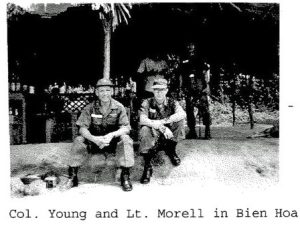
There was a term dating from the late 1950s used to indicate a highly polished and well-oiled military unit, with tight organization and supreme discipline; STRAC derived from “strategic command,” whose units were the best trained and most polished in the army. “Wiktionary’s glossary of military slang suggests an overlap, saying STRAC is US Army slang for: “a well organized, well turned-out soldier, (pressed uniform, polished brass and shined boots).” A proud, competent trooper who can be depended on for good performance in any circumstance. …“STRAC.” Originally an [sic] 1950s acronym for Strategic Army Corps, a group of four elite divisions maintained at a high readiness for overseas deployment. It began to be used as an adjective, to be “STRAC” was to be prepared.”22 I guess one could say that the Collection Branch of J-2 was effective with limited resources, but certainly not “strac.”
Actually the person designated as the direct commander of the Translation Section was Captain Orr, who was a genial figure, but rarely had any direct contact with the section, which was not high on his list of critical assignments and seemed to be running itself quite well. Jim Potratz had a good sense of what needed to be done and how to do it. This was later reinforced by the subsequent arrival of an Army Security Agency analyst and former graduate of Monterey, Gale Halvorsen. “Hal” was a very tightly-wound and ascetic product of North Dakota. He had evidently been pushed out of his position as a civilian analyst at the 3rd RRU because of personality conflicts with his co-workers and superiors. One linguist who worked closely with him for a period of time called him “a prick.” Halvorsen certainly had an abrasive personality, and his great strength, his single minded focus to the exclusion of everything and everybody else, was also his greatest weakness. He ended up at the Translation Section because his superiors wanted to get him out of the way at Davis Station.
Hal was fanatically devoted to the task of unraveling the mysteries of the Viet Cong command structure, and the communications system which held it together. He did not suffer fools easily, and often confronted people whose commitment to the task at hand was lukewarm (by his exacting standards.) He thought they were obstacles to reaching the Holy Grail of mapping the entire Viet Cong communications system. He himself had some intriguing and plausible theories on this, based on his insight that in guerrilla war, a far flung and dispersed organization could only be held together by a communication system that, while elaborate, was organized by a few fundamental principles which all its members intuitively understood, and which could ensure the functioning of the system despite the many changes in designation that it required to maintain secrecy.
The specifics of his theory are too complex to go into here. Suffice it to say that the simple organizing principle which remained constant while the actual unit designations frequently changed was based on traditional Chinese numerology. This “nine” was Heaven and “five” was the Emperor. For example “Chín Năm’ (9-5) was the designator for the Viet Cong command headquarters (COSVN or Central Office for South Vietnam of the Central Committee based in Hanoi). It was “5” or the Emperor to Hanoi’s “9” (Heaven).23 Hal thought he had discovered a similar logic in the numbering of the administrative zones devised by Hanoi (Military Regions 1-9), which reflected the hierarchies of the command structures. Among his other insights was how to develop a common template which would integrate intelligence information from all sources but primarily signals intelligence, and file it by geographical grid coordinate. This would integrate intelligence which had been “stove piped” in different channels. It would serve as a mechanism for displaying and analyzing patterns of insurgent activity which, when plotted over time, showed tendencies that were often repeated, and highlighted specific geographical locations were central nodes in the Viet Cong communication system. I subsequently learned from one of my students who had served in Afghanistan that a very similar system had been implemented there, taking advantage of ubiquity of small computers, which proved quite effective. At the time Halvorsen proposed this, of course, there were no personal computers, and the US military was taken in by the myth the guerrilla was “everywhere and nowhere.” Thus the military usually ignored the complex territorial system the Viet Cong had developed for communications, transportation and liaison which, if examined closely enough could be plotted on a map that was as clear as the U.S. highway system. I later attempted to illustrate some of these patterns in my book on Revolution and Social Change in the Mekong Delta.
Halvorsen’s arrival had an immediate impact on the Translation Section. He began to insist on a level of commitment by the Vietnamese employees to the task at hand which would meet his own standards. Jim and I often worked 12 hour days, but it seemed that Hal lived in the Tax Building office and worked around the clock. He was very harsh and confrontational with the Vietnamese. On the one hand they didn’t mind the considerable escalation of salary that derived from all the overtime that they accrued under the new dispensation, but on the other hand it interfered with their normal lives.
Hal engineered a sort of coup d’etat which alerted me to the extent to which Jim and I had simply accepted the existing hierarchies within the office. Although Jim was nominally in charge, there was an elderly Vietnamese man who was in effect the office manager. In order to make himself indispensable, he made all the assignments to individual translators and typists, and played a central role in their bureaucratic advancement. After some observation, Hal concluded that this led to an unacceptably leisurely pace of production.
The crisis came when a truckload of documents related to COSVN came in from Tay Ninh. Hal immediately grasped his chance. Instead of turning over the allocation of assignments to our mandarinal office manager, Hal had selected one of the youngest and most dynamic of the translators to take charge of this project. Trần Văn Nhơn was equal to the challenge. Adapting a Viet Cong style slogan, he decreed “Everything for Pham Ha” (tất cả cho Phạm Hà the courier who had been carrying the COSVN documents). The office shifted into high gear and processed a remarkable amount of translations in a very short period of time.
The impact on the mandarinal regime of Mr. X was immediate. He lost his middle-man function and his authority over the rest of the Vietnamese. The crowning blow was when Hal, along with Jim, bulldozed through a first-ever dictionary of Viet Cong terms, which gave every individual translator their own keys to the kingdom. It had the same impact as the introduction of the vernacular bible. Until then, whenever a translator encountered a novel or difficult Viet Cong term, they would have to go to Mr. X, who had through long experience stockpiled an internal dictionary of esoteric terms and could resolve their problem. It was like the old literati of Vietnam among which the highest prestige went to the person who could memorize the most characters rather than the ones who relied on a dictionary. Now every translator had the means to resolve their translation problems on their own, and the last edifice of Mr. X’s power over them crumbled. Humiliated, he soon quit the office and took a much more modest position elsewhere.
The incident was, in a way, a symptom of the stepped up pace and sense of urgency coming from the American side, as McNamara and the Johnson side looked for answers to their spiraling problems. The Vietnamese translators performed heroically. There was, first of all, Trần Văn Nhơn who had taken over the Pham Ha project. Nhon was from central Vietnam, a highly energetic and resourceful person. I recall him telling me that his first job as an interpreter for the Americans had come when he was attached to a Special Forces unit in 1962. One day he found himself lost in the jungle in the middle of nowhere with a U.S. Special Forces officer, and was stunned to see this paragon of military macho completely break down in panic and despair. He finally simply sat down with his head between his hands in helpless frustration. Nhon kept his cool and they eventually found their way out. I was not surprised to learn from a 2008 obituary of Nhon that he had been adventurous and enterprising to the end, operating a shrimp boat in Havana and working in a Las Vegas casino. His main job for most of his post-1975 American stay, though, was as a translator, often for visiting dignitaries from Vietnam. When one angered anti-Communist Vietnamese refugee continually interrupted Nhon’s translation of a visitor from Hanoi speaking to a university audience by shouting “the speaker is a Communist and the interpreter is a Vietnamese traitor!” Nhon’s response was characteristic: “Sir, could you shout your reproaches in shorter and clearer sentences so that we can translate them. And he interpreted, ‘This gentleman says that the speaker is a Vietnamese communist and that the interpreter, me, is a Vietnamese traitor.”24
Nguyễn Thế Sức, a Northerner, was a friendly, sincere, and helpful presence in the office, and I learned a great deal from him. Sức was a Northern Catholic who had been captured by the Viet Minh at Dien Bien Phu, but survived the ordeal. Jim Potratz had an inspiration that later resulted in the most useful product of the Translation Section, a Viet Cong Terminology dictionary. Jim was frustrated with the difficulty of finding standard translations for the esoteric terms used by the Viet Cong, and wanted not only to have a translation, but a compilation of the various contexts in which a term was used, in order to improve the quality of the translation. He entrusted Suc with the task of compiling a record of problematic terms, which later expanded into a very substantial and essential Dictionary of Viet Cong Terms, that became an essential reference for translators.
Nguyễn Văn Trí was called jokingly “Brother 13” by Jim Potratz, because he was at the tail end of a large number of siblings in Go Cong province in the Mekong Delta. I remember Tri teaching me some hyper-ornate phrases in Vietnamese, such as, when inviting someone to your house, “please move your ivory heels to my humble abode” (xin dời gót ngọc đến tệ xá.)
It was our good fortune to add to the growing ranks of translators someone who was clearly overqualified for the job, but glad to have a job under his current circumstances. His name was Kỳ Quang Liêm a Catholic from Thanh Hoa in Central Vietnam, who had been a die-hard Diem supporter, and was imprisoned for this for several months after the coup. He was a Lt. Col. in the ARVN but had been cashiered after the coup. Liem had been considered as a coddled favorite of Diem (con cưng của Cụ), and was thus a special target after Diem’s overthrow.25 His patronage from Diem stemmed from his role in putting down the November 1960 coup attempt against Diem while he was Deputy Commander of the Civil Guard.26 He was soon released from jail, but as an unregenerate Diemist was considered unemployable by most people with political connections, despite a reputation for integrity and competence.27
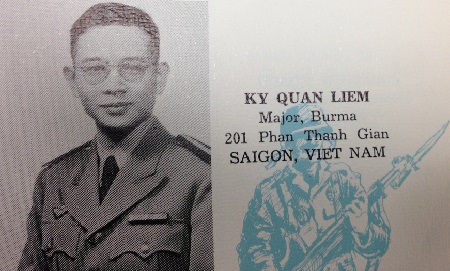
http://www.generalhieu.com/cgs_kyquangliem.jpg Liem photo from Leavenworth Command And General Staff College, misspelling his middle name and mistakenly identifying him as coming from Burma, despite the Saigon address.
It was from Liem that I heard a story about U.S.-Vietnamese relations which seemed to me to be a perfect encapsulation of why things had gone wrong. In 1960 he was the deputy commander of the Civil Guard, the territorial forces that were organized in conventional military units, but usually operated in small units no larger than company size and were less well equipped than the ARVN and under the command of the province chiefs. The Civil Guard were the essential middle ground between ARVN, whose cumbersome battalion sized operations usually were known to the Viet Cong in advance and, instead of “search and destroy” became “search and avoid,” and the village militia.
One problem faced by the Civil Guard was mobility – they did not have enough vehicles to transport them quickly and efficiently around the province to which they were assigned. In a typically clueless response to the problem, the U.S. Military Assistance and Advisory Group (MAAG) came to Liem to announce, without consultation, that it had decided to equip each Civil Guard company with GMC two-and-a-half ton trucks. Liem responded “I studied at Fort Leavenworth Command and General Staff College” and I know very well what the result will be. US doctrine will require that these trucks be stationed in a motor pool in the province capital for convenience in maintenance and control. Thus they will be far away from where they will likely be needed when the time comes. In addition, they are too big to travel on the narrow dirt paths that connect the villages, and too cumbersome for small unit operations.”
Moreover, the Civil Guard troops would also be pulled out of the countryside to be stationed in the province capital in order to be near the trucks, thus creating a security void at a critical time. In this stage of the guerrilla war, Liem argued, it was essential to have maximum flexibility and rapid response. “Don’t give us the trucks, he pleaded. Give us three-wheeled Lambretta’s which are already in use in the countryside and which can be maintained by any village mechanic. They are small and durable enough to travel on village roads with a full squad of troops, and can be dispersed throughout the province so they can be immediately available when needed.”
Needless to say, the American proposal was forced on Liem. He didn’t get the Lambrettas, and the trucks, as he predicted, ended up sitting in the motor pool in the province capital. When I heard this story, I concluded that it would be difficult to find a better example of the counter-productive nature of the American advisory effort. Instead of investigating Vietnam’s needs and responding to them, MAAG set about trying to shape even Vietnam’s territorial forces in the image of the U.S. regular army, equipped and trained for conventional war as it was. For me, this was another early indication that the war would not turn out well either for us or the Vietnamese we were supporting.
During his short stint at the translation section, before he moved on to a much better paying job and one which more suited his considerable talents with Esso oil company (the earlier incarnation of Exxon) Liem became inadvertently peripherally involved in one the few cloak and dagger projects that came to the Translation section, at my request. Sometime in late 1964, I was given a letter by MACV which I was told to treat as highly confidential. It turned out that they letter was from one of Vietnam’s most inveterate coup-plotters, Phạm Ngọc Thảo, who had by then fallen out with the generals he had induced to overthrow Diem and was in temporary exile in the United States.
The FBI and or the CIA had evidently had him under surveillance and had surreptitiously copied a letter he had sent to another Vietnamese. Thảo was one of the most complex of the many complicated figures of the Vietnam War. He had been a former Viet Minh who had ostensibly switched sides though his brother remained a top official of the Hanoi regime. Because he was a Catholic and because his defection seemed genuine, he became one of President Diem’s favorites. Diem appointed him as province chief in the Viet Cong stronghold of Ben Tre, and he developed a reputation for effective counterinsurgency methods. Diem trusted him so much he appointed Thảo to go on a nationwide inspection tour of the progress in building Strategic Hamlets.
Diem evidently had not totally trusted Thảo, however, and sent someone who later became one of my closest Vietnamese friends, working with me for RAND, to keep an eye on him, Lt. Col. Nguyễn Huữ Phước.
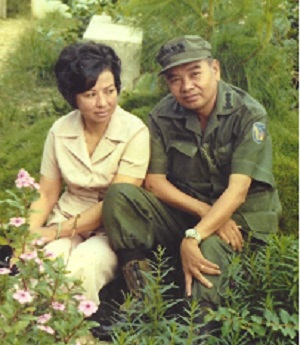
Col. Nguyễn Huữ Phước and Mrs. Phước
At the time of the November 1963 coup Phước was the deputy mayor of Saigon for Security. Diem and Nhu had managed to escape the forces encircling the Gia Long palace through an unattended gate without attracting attention. Phuoc met Diem and Nhu at the former Grande Monde complex, which had been converted to the headquarters of the Republican Youth, of which Phuoc was a key official. This was one of the last groups that Diem could count on for support. Phuoc took charge of Diem’s small convoy and drove them to the house of a wealthy Chinese businessman in Cholon. Nhu asked if Phuoc would be able to drive them to Dalat, and Phuoc assured him that this could be done. Diem however, angrily rejected fleeing from Saigon, and arranged a surrender to the coup generals. Phuoc handed Diem and Nhu off to someone else who drove Diem and Nhu to a Catholic Church in Cholon to surrender to the coup forces. He was one of the last people to see them alive.28
Phước, who was later introduced to me by Liem, observed that Thảo would repeatedly urge province chiefs to step up the Strategic Hamlet program in the most counterproductive way possible, usually by urging them to mobilize large contingents of corvée labor to build them just as the harvest season was coming on. From his close observation, Phước concluded that Thao was working for the Viet Cong and trying to sabotage the GVN programs and stir up political resentment, but his indirect hints to Diem along this line were brushed aside.29 Later, it turned out that the suspicion was well founded and that Thao was, in fact, a double agent.
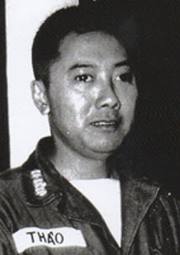
Col. Phạm Ngọc Thảo
I’m not sure why Thao’s intercepted letter came to the Translation Section rather than being handled by the CIA. I can’t remember the contents of the letter, but if there was any plotting involved it was certainly well disguised. There was, however, one ambiguous and enigmatic phrase, whose meaning I could not decipher. With some hesitation, I showed only this phrase to Liem, who helped me figure it out – though it did not add anything to my conclusion that the letter was innocuous. Nevertheless it was handled with great secrecy (other than my showing part of it to Liem as a last resort).
General Khanh ordered Thao to return to Vietnam in early 1965, possibly planning to assassinate him at the airport on arrival. Thao foiled this by using other means to get back to Vietnam. Following his return he instigated the abortive February 1965 coup, by persuading some generals that Khanh was about to sign off on an American bombing campaign against the North. Following the military takeover by Generals Nguyen Van Thieu and Nguyen Cao Ky in June 1965, a substantial reward was put on Thao’s head, and he went into hiding. After becoming Premier of the Socialist Republic of Vietnam, Vo Van Kiet, who in 1965 was in charge of revolutionary operations in the Saigon area, confirmed that he had tried to persuade Thao to escape to the Viet Cong controlled areas, but Thao refused on the grounds that he felt more valuable in fomenting coups and creating instability in Saigon at this critical time. Eventually he was caught and executed in July 1965 after being tortured.30
Liem introduced me to several of Diem’s most loyal aides, like Col. Phuoc, including one who, on Liem’s recommendation we brought into the Translation Section. I came to admire and respect them for their loyalty to an ideal, commitment to service, intelligence and resourcefulness. The loss of these men to the non-communist cause was truly a tragedy. Over time I arrived at the conclusion that despite Diem’s positive aspects, outlined in Ed Miller’s exceptional book Misalliance, that the war could not have been won with him in power. But I also concluded that the major U.S. mistake in the war was contributing to Diem’s overthrow without asking whether or not there was a better non-communist force available, and that we could not have won with Diem, but also could not have won without him and the people like Liem and Phuoc who served him capably.
Like Liem Col. Trần Thanh Chiêu was out of a job. Unlike Liem, he had already been in trouble in the last days of Diem, not for suspected disloyalty but for an excess of zeal. Chieu was from Quang Ngai province.31 His heavily accented words came tumbling out of his mouth in rapid succession as he tried to keep pace in speech with the rapid flow of ideas in his mind. He was a man of total loyalty to his faith and his leader, and a man of impulsive enthusiasms. He had been fast-tracked for promotion by Diem and attended the prestigious Command and General Staff College in Ft. Leavenworth, as had Liem. But Chieu’s career was blemished by failure to prepare a key outpost for a surprise attack in one of the first major Viet Cong military successes of the war, the overrunning of the ARVN base at Tua Hai (Tower Two) near Tay Ninh in September 1959, the first large scale attack of the war, the so called Trảng Sụp incident. For this he was relieved of his command of the ARVN 22nd Division and told that he would never command a unit for as long as he remained in the army.
Chieu again got into trouble by organizing an anti-Buddhist demonstration of wounded ARVN veterans in Saigon on July 23, 1963. A Buddhist newsletter claims that “Thus [Ngo Dinh] Nhu and [Tran] Le Xuan continued to use Can Lao [Diem’s political party] cadres and other outside organizations like the Republican Youth, and the Republican Women. Because of excessive zeal to serve his leaders and to redeem his defeat at Tua Hai (Tay Ninh) more than three years earlier, On Sunday, July 23, Lt. Colonel Tran Thanh Chieu, Director of the Self Defense Corps Inspectorate, assembled around 100 SDC, families of fallen soldiers, and wounded veterans in front of the Xa Loi Pagoda, and demanded that ‘you should go back to being monks and stop continuing to sow chaos, which only benefits the Communists.”32 Chieu himself later asserted that it was General Ton That Đính who ordered him to organize the demonstration, but when it badly backfired, denied it to Nhu, and put the blame on Chieu, who became the scapegoat.33
Even Diem and Nhu felt that this demonstration was, at the least, inopportune, and Diem ordered that Chieu be stripped of his post and incarcerated for forty days. A Buddhist leader wrote Diem, cleverly trying to pin this anti-Buddhist act on Diem himself. He urged clemency for Chieu on the grounds that he would never openly defy a Diem order unless some “outside force” had been involved, that is, that it was U.S. that had pushed Diem into condoning the demonstration.34 So Chieu was still incarcerated at the time of the coup.
Chieu threw himself into his job at the translation section with gusto, eager to get his hands on the documents that would help him understand what the communists were up to, and to learn the secrets of their success. Like a number of anti-Communist Vietnamese (and some Americans) Chieu was convinced that the communists’ success was due to clever propaganda and appealing slogans, along with ingenious organizational techniques. Reading one document he came across a typical slogan intended as a memory device or checklist for cadres that summarized their most important tasks. I remember Chieu leaping up from his desk holding a document and shouting “thất khâu ngũ bộ [the seven stitches and five steps]!” He was exultant because he felt he had penetrated the interior world of the communists, and had discovered the secret to how they mobilized their cadres into effective action. (In his 1999 oral interview he cited the “four quicks and one slow” as an example of clever communist tactics).35 Soon, however, it became apparent that his interest was not in translating but in studying the communists organizational tricks both to combat them and to copy them, and that his English language skills were rudimentary. Ultimately Chieu and the Translation Section parted ways.
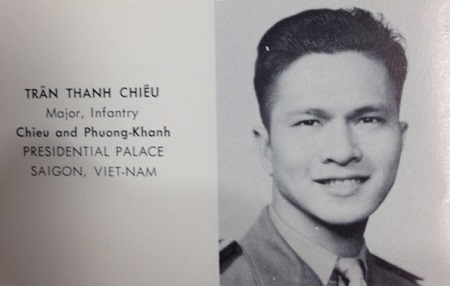
Đại Tá Trần Thanh Chiêu http://www.generalhieu.com/cgs_tranthanhchieu.jpg
Despite occasional diversions, like the Thao letter, the Translation Section maintained its steady routine. Gale Halvorsen continued to throw his weight around, and one evening when we were all working late on a rush project, inexplicably began to heap abuse on Long, a Vietnamese translator, for being lazy and uncommitted to the task at hand.
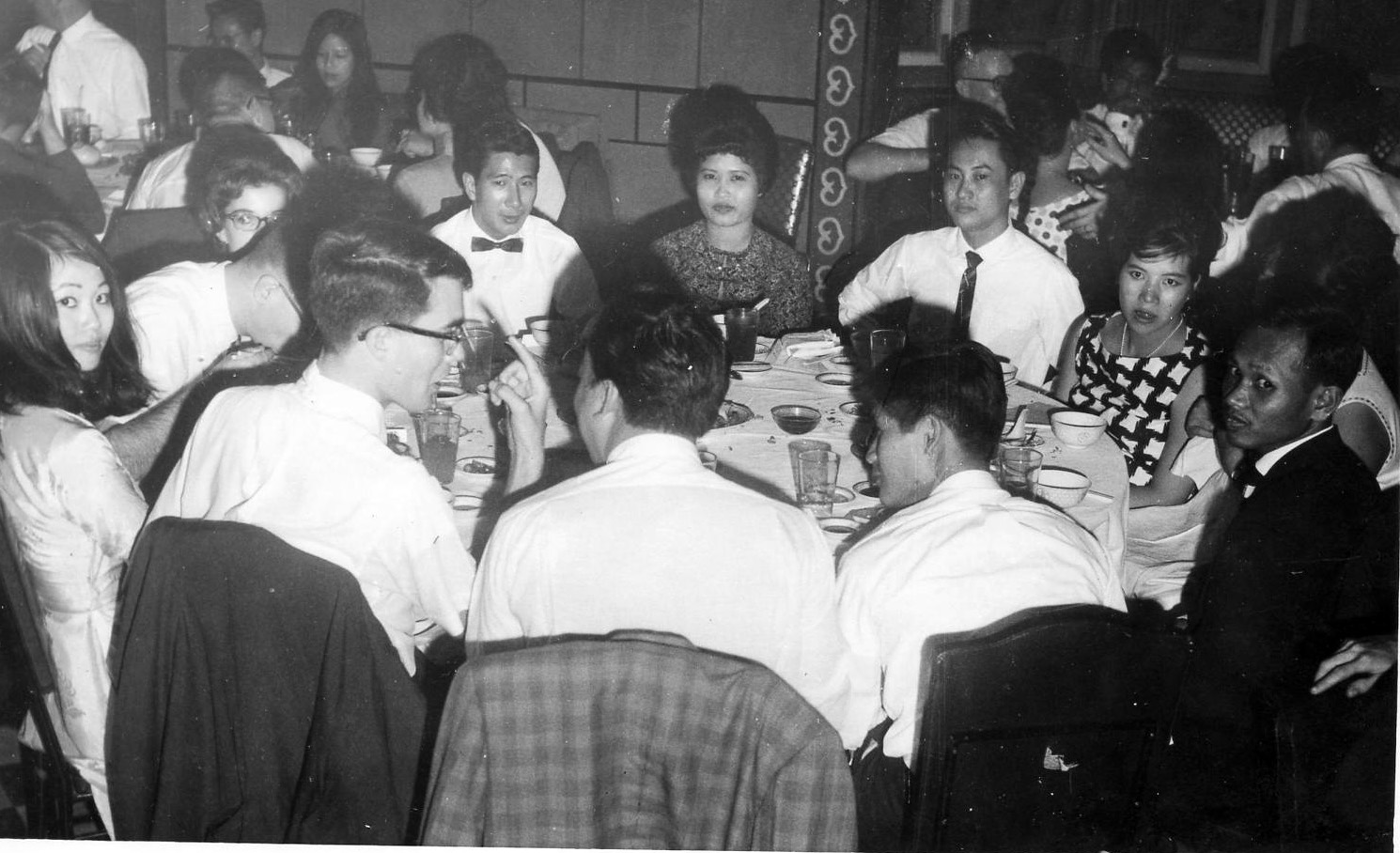
Long is the person wearing a tie in the right center of this photo
There was an uncomfortable silence in the office as Hal’s tongue lashing started to become intolerably abusive. He sounded like a colonial overseer tongue-lashing an underperforming native worker. Hal ignored my feeble attempts to get him to desist and continued his tirade for over an hour. It could be that he suspected that Long was a VC mole. I heard vague rumors to that effect later on, and while many of the Vietnamese translators fled to the US in 1975, he remained in Vietnam. I had a brief chance encounter with Long in my first trip back to Vietnam in 1982, as I was standing on the corner of ex-Tu Do street by the Caravelle hotel and Long passed by me on his Honda, on which he had sometimes taken me home from work. Our eyes met briefly, but I couldn’t read anything in his expression.
I can’t remember whether this was what caused Hal’s eventual departure from the Translation Section, but at any rate he left. Jim Potratz also rotated to a new assignment toward the end of my tour with the Translation Section, which was briefly taken over by a sergeant from the tank corps, who spoke minimal Vietnamese and had the continual jitters from too much coffee and too many hours in a rattling tank. This was only temporary, however, and as I was leaving in the Spring of 1965 the military escalation dramatically transformed the size and importance of them Translation Section, until it was taken over by a Lt. Col and moved to a large new headquarters near Tan Son Nhut airbase.
Our work was intense, sitting in the upstairs offices of the Tax Building in nearly complete silence, as everyone focused on their task at hand; the translators translated, the editors edited, and the typists typed. No schmoozing or small talk – especially after Hal’s arrival on the scene. But the background music to our work was the opposite of this oppressive atmosphere. There was a record shop on the ground floor of the Tax Building. The Beatles had taken Vietnam by storm in 1964, and the record shop blared the latest hits around the clock – I Wanna Hold Your Hand, A Hard Day’s Night, Eight Days of the Week, etc. The Hard Day’s Night album was pounded into our brains from morning until night, to the exclusion of any other sounds which might normally have been the background audio track of a large commercial mart like the Tax Building. Every American in Vietnam had his own sound track of the war. This was mine. The irony is that I would probably ignored Beatlemania if I had been in the United States. It took travel to distant Vietnam to bring me in tune with the rest of the world.
David Morell and his wife Susan lived in a two story villa right around the corner from MACV headquarters on Phan Thanh Gian street. When he completed his tour of duty in early 1965 and they returned to the United States, Mai and I inherited their house, which was a considerable step up from the shabby apartment on Hai Ba Trung. Normally a centrally located villa like this would have been well beyond the reach of a specialist fourth class, but after Johnson ordered the bombing of North Vietnam following the February 1965 attack on the Pleiku airfield, all American dependents were ordered to leave Vietnam in order to “clear the decks”36 or, in Godfather terms, “go to the mattresses,” and the Saigon rental market briefly tanked. Mai, as a Vietnamese citizen, was not subject to this evacuation order.
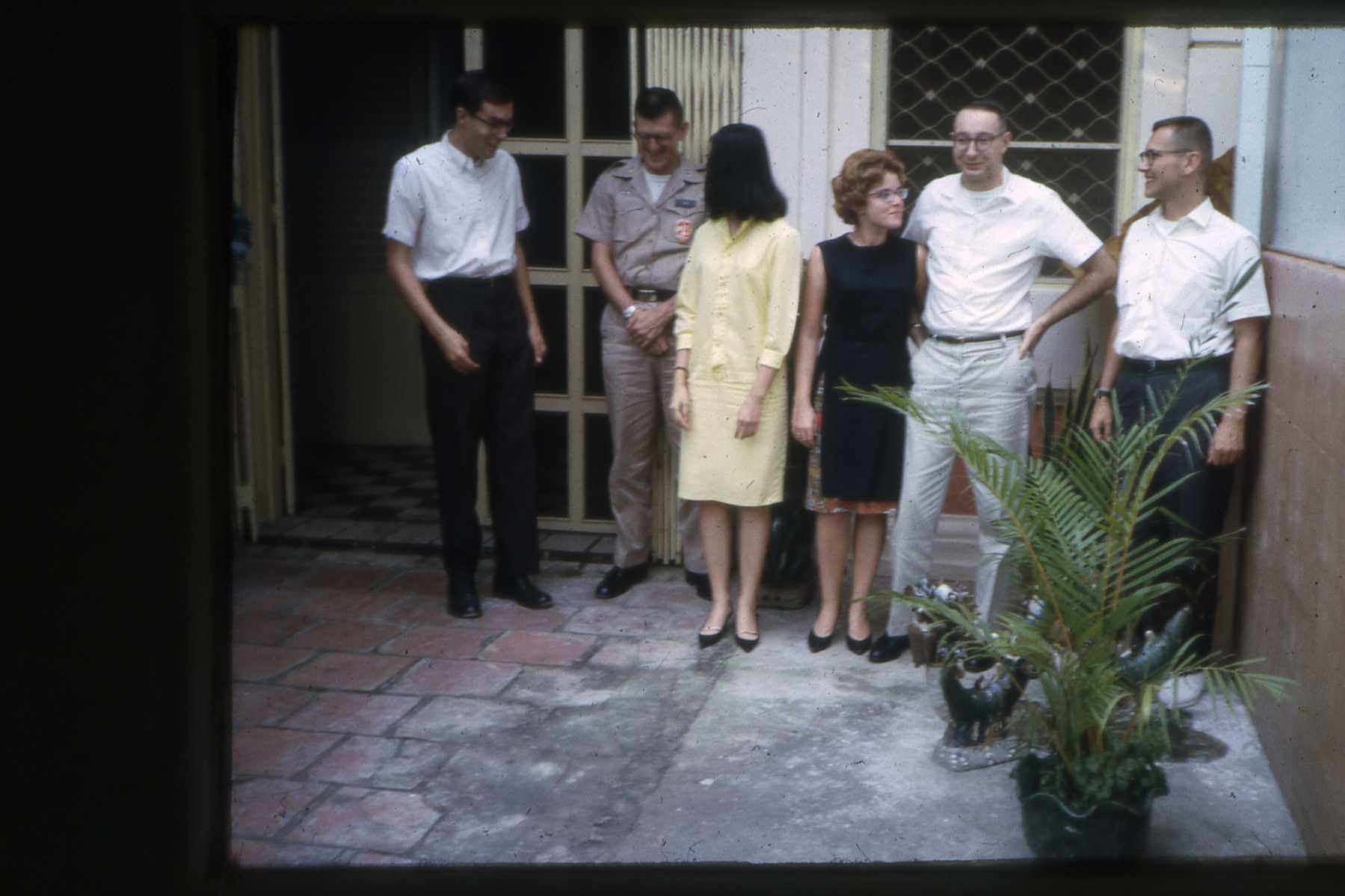
Courtyard of villa at 223 Phan Thanh Gian Street. DE on left, Captain Orr, Mai, Susan Morell, David Morell and unidentified MACV officer circa early 1965.
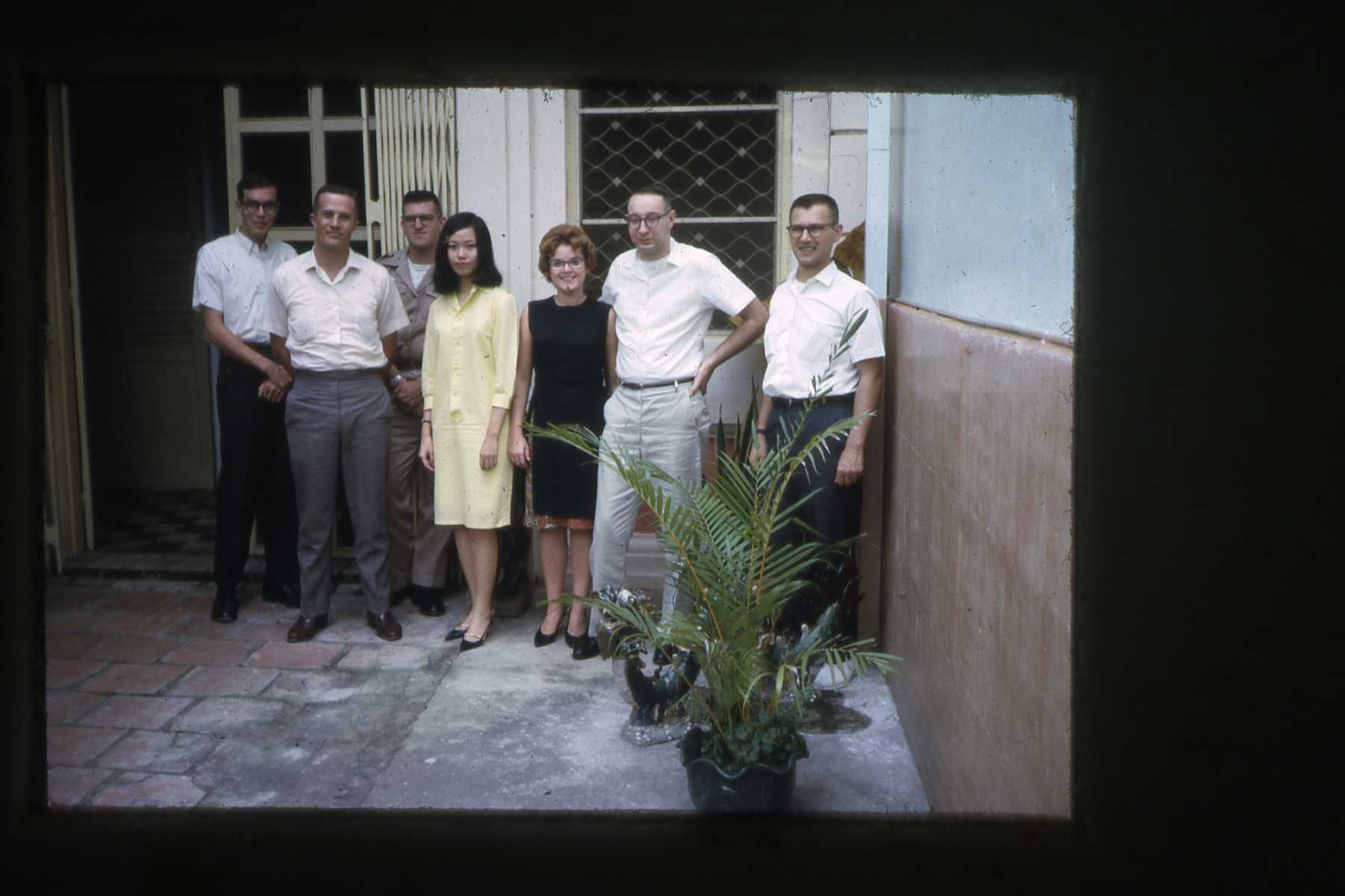
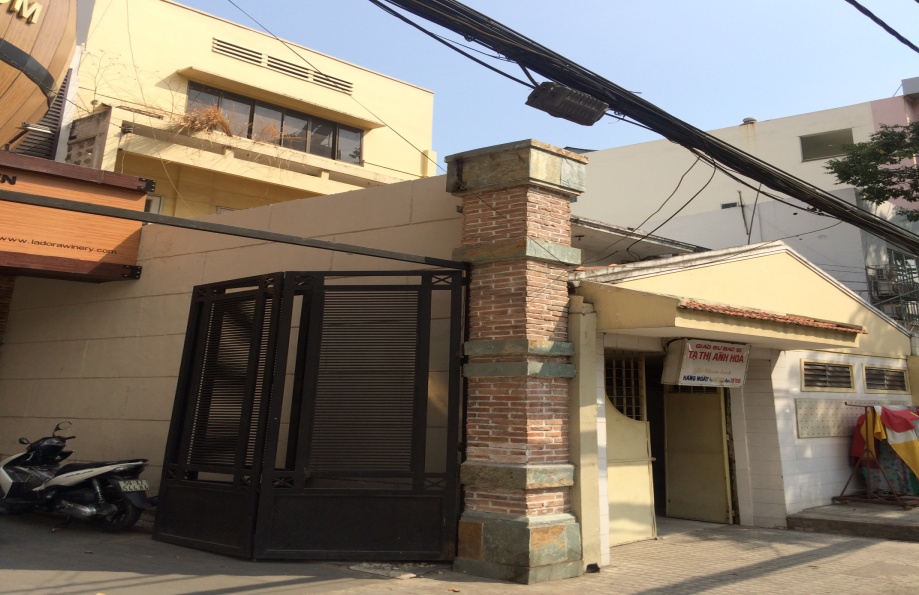
The former 223 Phan Thanh Gian villa, by 2016it was a doctor’s office and had been extensively remodeled. The street has been renamed Điện Biên Phủ
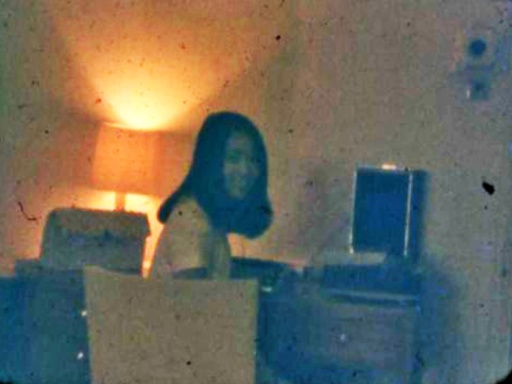
Mai in the living room of 223 Phan Thanh Gian
We inherited a husband and wife cook-custodian team, who took on the daily routine of the house, while both Mai and I were at work. Despite her training at the Georgetown School of Foreign Service (and despite the fact that Mai’s Georgetown roommate was the daughter of the Minister of Foreign Affairs) Mai had been unable to find a job at the Vietnamese Ministry of Foreign Affairs, so she took a job at the British-run Chartered Bank translating documents. Subsequently she did an English-language news show at the Vietnamese Government’s Radio Saigon, a target of coup plotters and protesters throughout the turbulent year of 1964, as she vividly describes in her memoir.
At the time the total of my possessions could be fit in a single duffle bag – my military uniforms and a few civilian pants and shirts. Carried away by being in our own personal space, I got a sudden urge to normalize life a bit. GI’s later identified two unconnected spheres of human existence; Vietnam and “the World” – to which they someday hoped to return. I too felt a bit cut off and wanted to connect with a sphere larger than our apartment and MACV. So I went to the PX and bought a Zenith transoceanic short-wave radio.
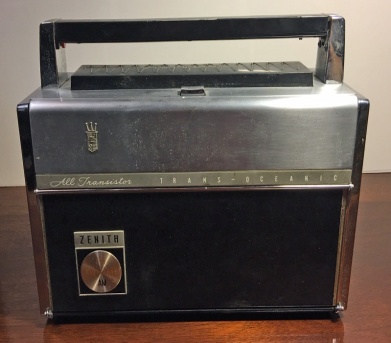
It cost over $150 which was a major chunk of my monthly paycheck. Actually, although I was only a lowly cai (Vietnamese for corporal in the French colonial period) I was making about $500 dollars a month, with my meager base pay augmented by a slew of salary augmentations for overseas duty, serving in a combat zone, dependent supplement, and the like. It was the equivalent of a GVN cabinet minister’s salary. Nevertheless, Mai was appalled by this extravagance. But it was my prized possession, I own it to this day. After that, our spending was tightly controlled. Truth be told, except for the occasional foray to a nightclub to hear the latest Vietnamese singers in vogue, (Minh Hiếu and Thaí Thanh, among others) there was not much to spend money on in those austere days before the Americans flooded the city. The Zenith was worth every penny – and compensated for the antique opium pipe which Mai’s mother told her not to let me buy for fear I would follow the many French who sank into immobilizing opium addiction. As it transpired I was never attracted to drugs of any kind even when they became widely available following the American influx, because I had just quit my three-pack a day cigarette habit. I found that excessive smoking dragged me down and made it even more difficult to cope with Saigon’s heat and humidity. (The Surgeon General’s Report on the hazards of smoking had just come and was also an important factor). I spent most of the next year trying to suppress my nicotine craving, and did not want to become addicted to something even more debilitating.
Not long after we moved in to 423 Hai Ba Trung, I suddenly came down with an acute intestinal disorder after lunch. It turned out that the probable cause was an earlier meal at the restaurant Hai Con Cua [The Two Crabs]. It was the best chả giò restaurant in town, but I unwisely ate the lettuce in which it was wrapped, and subsequently came down with amoebic dysentery. Seeing that I was violently ill, Mai went for help, She knocked on the door of the first-floor apartment of Paul Steer who had once been in the 3rd RRU and through whom I found the apartment. Paul had married a Chinese and, like me, was booted out of the 3rd RRU and had to seek outside quarters. Mai discovered that she had come at a very inopportune moment, as Paul groggily came to the door with a scowl on his face. But, to our eternal gratitude, he took me to the Naval Dispensary on Tran Hung Dao street, where I was hospitalized for two weeks. Although I received excellent medical care, my debilitated state made Mai’s daily visits a great consolation.
After working for the British owned Chartered Bank as a translator, Mai took a job as the English language news reader of Radio Saigon. Her nominal boss was Paul Vogle, a former Monterey linguist who had completed his military service and was staying on in Vietnam leading a hand to mouth existence with part time jobs like the one at Radio Saigon. His level of fluency in Vietnamese was phenomenal and it always seemed to me a shame that he didn’t put it to better use. I remember reading an article on Paul in a Vietnamese newspaper around this time, which perfectly captures his fluency in the language. The reporter engaged Paul in a discussion about how Vietnamese bar girls seemed so much better endowed than the average Vietnamese woman. Paul replied with a native fluency that I could never hope to aspire to; “they pad themselves with a bunch of stuff below, which shoves everything up, and gives it that appearance [of being well-endowed].” [Độn cả đống ờ dưới, dồn hết cả lên trên, cho nên nó mới hoá ra thế đi chớ.]” We were never taught anything like this at Monterey, and only a foreigner with total immersion in Vietnamese society would be able to formulate what seems to be a very simple thought with absolutely colloquial fluency. Later Paul put his language skills to more consequential use when he interviewed relatives of the people massacred by the Viet Cong during the Tet Offensive for journalist Don Oberdorfer as Don prepared his definitive book on the pivotal event of the Vietnam War.
Even Paul Vogle could not, however, match the astounding fluency of one of the overlooked figures of the French colonial period Jean Cousseau[3] – although, it must be said the French Vietnamese experts had a much longer time to immerse themselves in the language and culture than the American linguists who came later. My close colleague in the My Tho project with RAND Vuong Bach (the brother of the anti-Diem coup leader Vuong Van Dong) told me a story about his encounter with Cousseau who was the “inspecteur politique” of the French regime when it regained control in Vietnam after the Japanese defeat in 1945. He was in charge of manipulating Vietnamese politicians to deflect challenges to the colonial regime. Bach and a number of his nationalist political friends went to Cousseau with a proposal to install them in power in order to undercut the communist Viet Minh because the Vietnamese collaborators working for the French had no credibility. Bach’s group felt that given the tenuous French hold on power, they would be forced to rely on the anti-communists, even though they were also opponents of French rule.
The “old fox” (Cáo già) Cousseau made it clear that it was the French that had the upper hand and told them “lòng tôi như kéo ông lang, tôi bốc mùi vị nào mát thì nó mát, tôi bốc mùi vị nào đắng thì nó đắng. Xin các ông vui lòng hiểu như vậy.” The difficulty of translating this is a gauge of how deeply immersed Cousseau was in Vietnamese culture – I have never come across a non-native Vietnamese speaker who would be capable of formulating this message in such quintessentially Vietnamese terms. A literal translation is “my feelings are like those of an Oriental medicine man; if I extract a soothing herb from my medicine chest, it will sooth. If I extract a bitter herb, it will be bitter. Would you gentlemen be so kind as to understand that that’s the way it is.” In short, Cousseau was telling Bach and his friends that he would call the shots, not they.
Another former Monterey product with extraordinary fluency in Vietnamese was Bill Hutchinson who had graduated many classes before me. I can’t remember what his military affiliation was but he was, in 1964, essentially working on his own. He dressed in civilian clothes, and his assigned mission gave him license to do whatever he wanted to do, whenever he wanted to do it. Operation Hợp Tác was a pacification program that had been promoted by Ambassador Henry Cabot Lodge. As one study of the period describes it, this was a new incarnation of the pacification program. It replaced the Diem-era Strategic Hamlet program, which had totally collapsed after the overthrow of Diem. During the Khanh period “There was … a new effort to assign geographical priorities, and in mid-1964 the GVN [Government of Vietnam] and the U.S. Mission assigned the highest priority to the provinces around Saigon. Labeled Operation Hop Tac (cooperation in Vietnamese) pacification activity in these provinces was designed to apply the so-called oil-spot principle of expansion from a secure base, beginning with Saigon-Cholon and the urban part of surrounding Gia Dinh Province.37
“Hutch” was given the assignment of simply traveling on his motor scooter around the Hop Tac area, the provinces adjacent to Saigon, to get an informal first hand view of what was happening and feel the pulse of popular attitudes toward the GVN, the US and the war in general. Hutch was well over six feet tall and heavy, so it was unlikely he would be an unobtrusive presence in the countryside. By the very nature of his assignment he had to assess the security status of these areas by finding out where it was safe for an unarmed American in civilian clothes to travel.
I don’t recall who Hutch reported to or if his findings made any impact. In a way it was similar to the random excursions of Charlie Benoit and Bing West of the RAND Corporation to monitor popular attitudes in the wake of the Tet Offensive of 1968.38 But unlike the RAND project, I doubt if Hutch ever did a systematic compilation of his findings or left a formal report. This unconventional, even bizarre, assignment is a measure of the desperation to pursue any scheme or idea (like the Oplan 34A raids) that gave the impression of doing something, rather than nothing. Hutch’s ambition was to translate the Vietnamese epic poem The Tale of Kieu, the Mt. Everest of Vietnamese literature, into English. This task came to be a kind of Holy Grail for some Americans who knew Vietnamese, who saw it as the supreme challenge to their language skills (Charlie Benoit wrote his Harvard PhD on the Chinese origins of the Tale of Kieu). I lost track of Bill Hutchison but it seems he did not achieve this ambition. At any rate, the Hop Tac program collapsed as security throughout Vietnam deteriorated precipitously in 1964, and the U.S. plunged toward direct intervention in the conflict.
Miscellaneous Military Duties
Much of my routine during my stay at the Translation Section from early 1964 until I was demobilized from the Army in May 1965 was humdrum, editing the translations done by the Vietnamese in our office. I dressed in civilian clothes, and commuted on my Honda 90 motorbike to downtown and back. There were, however, occasional breaks from the routine.
One day I got an urgent call from Collection Branch at Pasteur. My services as an interpreter were urgently required by the commanding general of J-1 MACV. I was told that this was an extremely important assignment. The general in charge of J-2 MACV wanted to prove the value of his resources to his bureaucratic rival, the head of J-1, and do a favor which might one day be repaid. Put on your dress uniform, I was told, shine your shoes and polish your brass. Make a good impression. If I had been in a conventional military unit, there would have numerous Vietnamese workers routinely doing this task for the pampered G.I.s, but I was on my own to do this mundane task. I dutifully showed up at the private residence of the commander of J-1 in my polished shoes and shined brass, wondering what important Vietnamese he wanted me to translate for.
He told me to go upstairs, and I followed him into the upstairs bathroom where a maid was patiently waiting. He said in his thick Southern accent, accenting the wrong word and upending the accents that the Vietnamese would have expected: “Tell “CHEE high” [chị Hai or “sister two”, a term use by both Vietnamese and foreigners to address servants] here that when she scrubs the bathtub, I want her to use Clorox.” My mission was accomplished in a few sentences. I left regretting the time I had wasted on polishing my brass, which I never did again for the remainder of my army tour.
As we started work on compiling a dictionary of Viet Cong terminology in order to standardize the translation of the esoteric terminology they used, I was assigned to go down to a compound along the Saigon river to the newly built National Interrogation Center (NIC) to talk with Viet Cong prisoners in order to clarify the sometimes obscure terms that we encountered in document translation. I was introduced to the CIA advisor to the NIC, Fred von der Muhl, who assisted me in selecting prisoners to interview. Von der Muhl was a very sharp but understated person, who you wouldn’t look at twice walking down the street. He had long experience in interrogations and was a firm believer in non-coercive methods, believing that brutality would render it impossible to get the strategic level information that NIC was designed to seek. (I discovered to my surprise much later that von der Muhl had become our neighbor in rural Virginia, and blended in as just another faceless retired Washington bureaucrat. No one suspected that he had led an adventurous life in various Cold War enterprises like the NIC).
My most memorable interview was with Sr. Captain Nguyen Do, who had returned from regroupment in North Vietnam to join the rising insurgency in the South. Like Mai, who would soon begin her career with RAND doing similar interviews in the NIC and its military counterpart the Military Interrogation Center (MIC) – which did resort to the rough stuff, as she discovered in talking to prisoners who had been subjected to torture – I was deeply impressed by Nguyễn Độ. He was the first Viet Cong I had met in the flesh. He was not the grizzled warrior I had expected, but a quiet, dignified and composed person, evidently unmarked by the ordeals he had experienced, including his confinement in NIC although he was officially listed as a voluntary defector. He apparently felt that the questioning about terminology was technical and innocuous and we had a fruitful and relaxed conversation.
In a plain room with no windows, walls padded and covered with white canvas (presumably for sound proofing rather than to cushion prisoners been tossed against them), and a single table and two chairs – something which resembled the “snow white cell” which Frank Snepp and others made famous later on as the place where high level prisoners were kept by the CIA – I talked with Nguyễn Độ for several hours about a wide range of topics, including terminology. Until that moment my impression of “the Viet Cong” was entirely shaped by encountering them only through the documents we translated. To me they were faceless cogs in an organizational machine. This was the first time I had seen the human face of “the enemy,” and I found it hard to see Nguyễn Độ as anything more than a decent human being, deeply committed to his cause – an image far removed from the maniacal terrorist caricature which was the image many of us initially were exposed to.
I did several more interviews, which served as a preview to my future work at RAND interviewing Viet Cong prisoners and defectors. One that I remember was with Đào Kiến Lập, a Southern regroupee who had returned to the South to help run the clandestine Viet Cong radio station. He was profiled in the State Department White Paper, Aggression From the North, a dossier of evidence intended to show that the revolution in the South was a wholly-owned subsidiary of Hanoi, and had no indigenous roots.
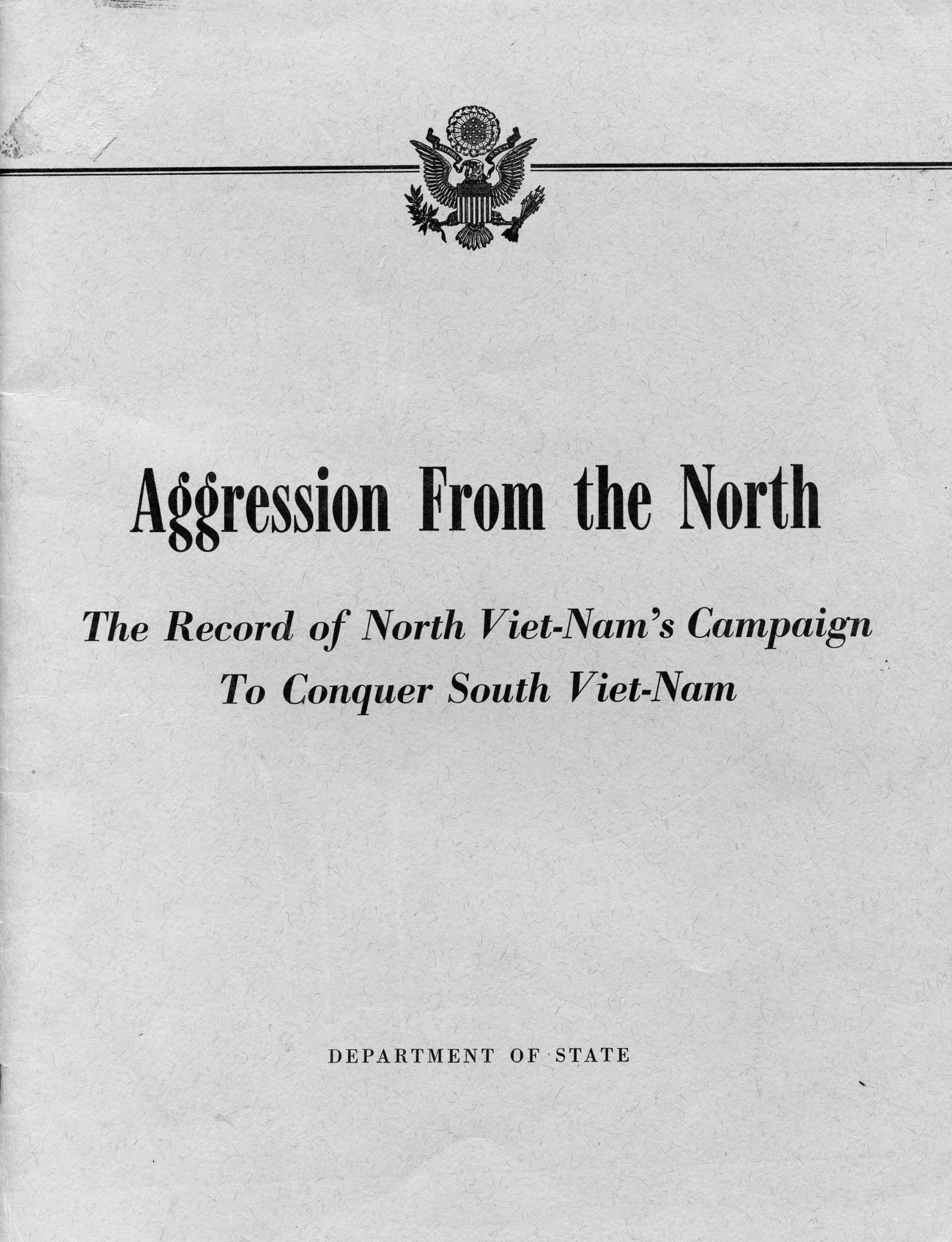
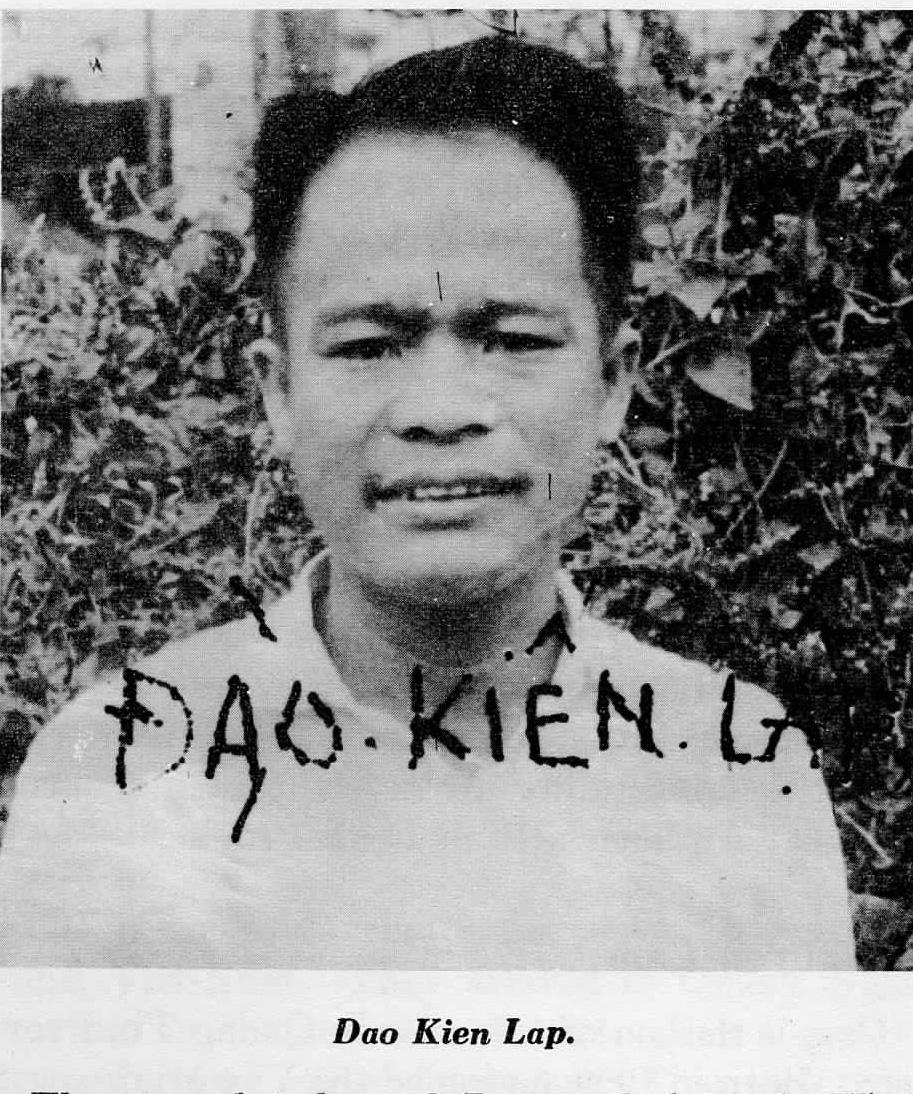
Senior Captain Nguyen Do was also featured in Aggression From the North.
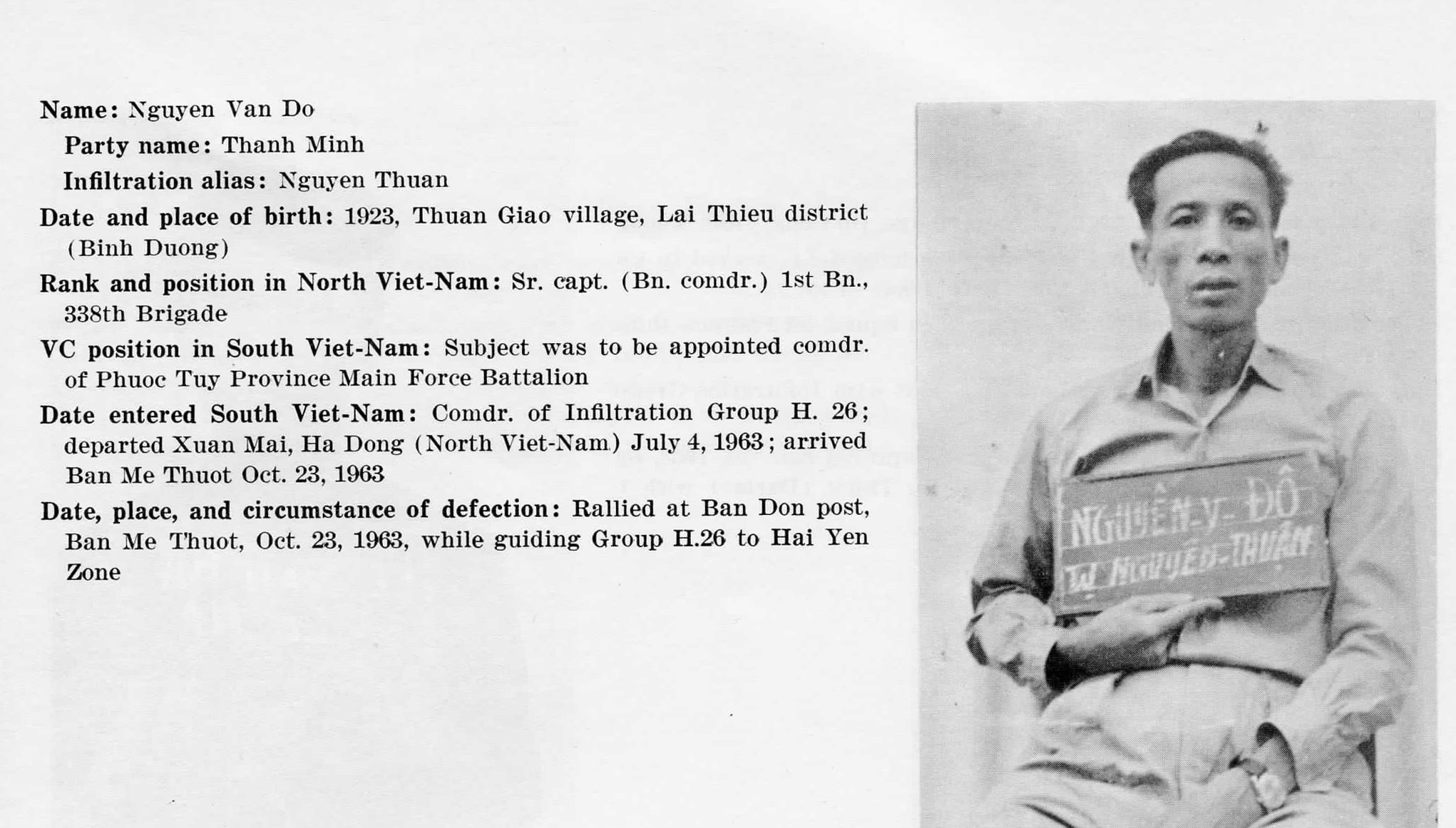
One of the Americans who assisted me in setting these interviews at the National Interrogation Center up was Captain Shipman, who was himself transitioning to a career in the CIA, having reached the plateau of his military career at the grade of Captain. I got the impression that, unlike von der Muhl, who was a highly motivated and dedicated intelligence professional, Captain Shipman was more attracted to the job security and absence of heavy lifting, as he freely confided to me, recommending that I follow his footsteps after I left the military. He was happy to be the beneficiary of the American buildup of 1964 which offered a new lease on life for thousands of military officers and NCOs who had reached the end of road in their military careers.
I also did less exotic linguistic tasks, like an occasional ad hoc translation involving one or another of the fast breaking developments of the 1964 buildup that overflowed the banks of the existing bureaucratic structures and required an ad hoc resort to assembling whatever resources were at hand for things like translation and interpretation. My appearance on this occasion was a good illustration of how much of American policy and actions were improvised or simply reactive in the chaotic expansion of American involvement during this period. One such occasion was a meeting of MACV brass and some Embassy officials to discuss a document sent them in Vietnamese by the Vietnamese government. It contained a response to the U.S. proposal for funding some aspect of an anticipated buildup of ARVN forces (I can no longer remember the details).
I was brought into a room full of the assembled U.S. brass and presented with a document. There was no explanation concerning what it was about, or what they wanted to know. And, of course, I had no time to read it over before attempting an on-the-spot translation. “Just tell us what it says,” I was told. I struggled through the unfamiliar bureaucratic and financial terminology, which was far afield from anything I had learned at Monterey or at the Translation Section which dealt exclusively with Viet Cong documents. I had to give a running translation as I read through a document I had never seen before. I suddenly encountered a term which an ordinary Vietnamese might encounter once in a lifetime, if that. The new funds for the South Vietnamese government would be delivered “in kind and in specie” ( trong hiện vật và hiện kim). By freak happenstance, I had recently encountered this term – I can no longer remember how or why – and out of curiosity had looked it up. I proudly and apparently casually translated the term “in kind and in specie” to the audience that sat there impassive and uncurious as to how a spec 5 with no training in the specialized terminology of finance could have effortlessly tossed off this translation. In addition, I had no idea what it meant or how it related to the bigger picture of the document’s contents, but I was not asked to clarify. I was given no thanks for my work, but sent back to the Translation Section to get on with my real job.
Occasionally, I would go into the field either to collect documents captured by ARVN forces on a recent operation and bring them back, or as linguistic backup to a Collection Branch officer on one assignment or another. I would go the MACV headquarters to pick up the Colt 45 which was mandated for couriers who transported classified material. The following day I would don my fatigue uniform, strap on my Colt, and head off for “the field” and, trying to look like a real soldier, would repeat to Mai the lines of a then-popular song “I’m off to the battlefront, you hold down the rear,” (Anh ra chiến trường, em ở lại hậu phương). This was a familiar trope in Vietnamese literature, as in the famous Chinh Phụ Ngâm or “Lament of the Soldier’s Wife”.39 The general concept was also immortalized in a famous Vietnamese song Chiều Mưa Biên Giới [Autumn Rain at the Border], current in 1964 after having been banned by Madame Nhu for its allegedly defeatist sentimentality: “Người đi khu chiến thương người hậu phương” [the person who is off to the battlefront thinks fondly of the person who remains in the rear]. Mai did not find it amusing. She had better things to do than mope around the house waiting for my return.
Once I was sent to ARVN Fifth Division headquarters in Thủ Dầu Một where the ARVN has just completed a rare (for 1964) successful operation against the Viet Cong and had captured a trove of documents, which I was to screen and bring back to Saigon. As I approached the division’s headquarters in the evening walking through a section of town with many tall, leafy trees, I could hear the crackle of bullets hitting the high branches. I had no idea where they were coming from or who was shooting, but it did give me the impression that even a nominally secure GVN controlled town was not safe in 1964.
When I reached Fifth Division headquarters I was surprised to encounter one of the most prominent coup generals, Tôn Thất Đính who, as Fifth Division commander had been the key to the coup strategy and was now the commander of Military Region III which included the Fifth Division. Đính was one of Diem’s favorite and most trusted generals, but threw in his lot with the plotters and was crucial to their plans. Diem had been totally confident that Đính would never betray him and that was his fatal mistake. Đính was considered egocentric and unstable, and from a distance of a few feet I thought he had a slightly crazed and vacant look about him.
.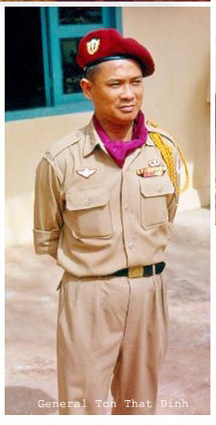
I wondered how I could have ever thought that a group comprised of people like this could have been an improvement over Diem. It must have been sometime in December 1963 or January 1964, because after the “purge” (cuộc chỉnh lý) of the main coup plotters by General Nguyễn Khánh on January 20, 1964, Đính was stripped of his power. Khánh manged to hang on despite the political chaos swirling around him for much of the remainder of 1964.
Soon after the purge I was assigned by MACV headquarters to go the press conference at which General Nguyễn Khánh introduced himself. I had to wear my uniform advertising my lowly rank of specialist fourth class in order to get in. I stopped off at Mai’s house on my way to the event. It was probably the only time her family had ever seen me in uniform, with my ‘spec 4” insignia designating my humble rank of corporal. There is a great corpus of folklore from the French colonial period of a local village belle marrying the corporal (cai) or sergeant (đội) who commanded the village militia post, and taking on hilarious airs as the wife of this “big man.” Fortunately Mai’s family learned to regard my insignificant military rank – I wasn’t even a đội at the time – as a temporary diversion from what would hopefully be a more prestigious profession. The press conference gave me my first in person look at this roly-poly man with the incipient goatee.
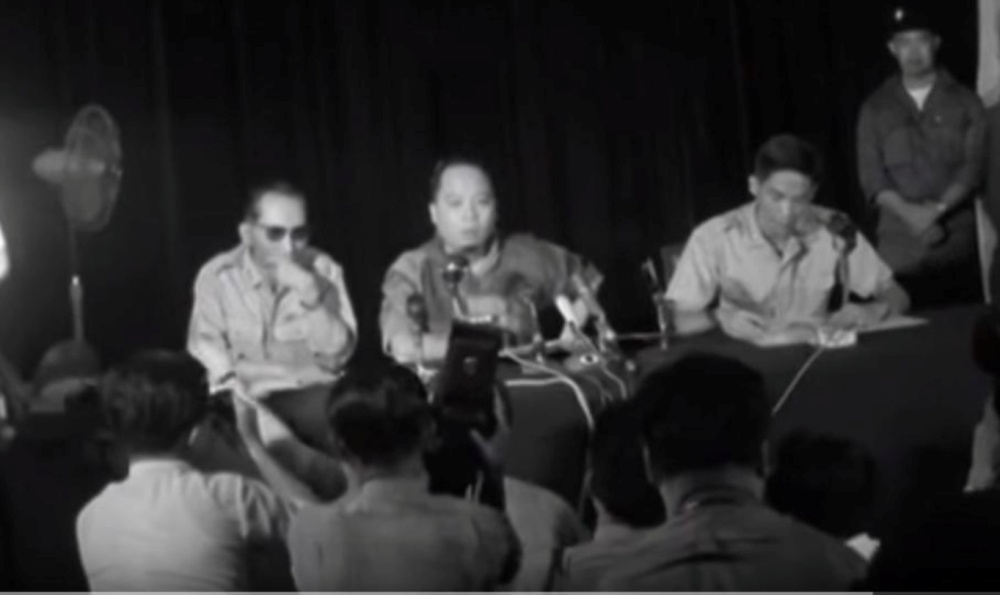
Saigon: Khanh Press Conference January 1964 https://www.youtube.com/watch?v=jXsk6s4drz0 Nguyen Khanh in center, Nguyen Ngoc Linh on his left interpreting
I was not much more impressed than I had been with General Đính. Even the presence of the slick and polished young interpreter Nguyễn Ngọc Linh, just returned from his studies in the United States, could not burnish the image of this improbable leader, whom many Vietnamese regarded as a buffoon. It did not augur well for the future survival of the non-communist forces in Vietnam.
Another miscellaneous task was the assignment to go to the Armed Forces Radio Station and get them to produce a tape of the radio broadcasts done at the time of the Diem coup, with a narration by one of the AFRS announcers. The final product was given to Col. Farrier, outgoing head of J-2 MACV as a memento of his time in Vietnam. I worked with the predecessor of Adrien Cronauer whose highly fictionalized tour of duty at the Armed Forces Radio Station circa 1965 was immortalized in the movie Good Morning Vietnam. As Cronauer said in an interview, if he’d actually done any of the zany things that his screen character did, he would have ended up in Leavenworth. Actually it was Cronauer’s predecessor with whom I was working, whose name I can no longer remember, that devised the sing song “Good Morning Vietnam” sign-on. Instead of Robin Williams’ punchy, staccato “GOOD-MOR-NING-VIET-NAM” the authentic original, more or less adopted by Cronauer was a drawn out crescendo which peaked in volume in the middle: “goooooooood MOR-NING VIET-nam.”
I hope Col. Farrier enjoyed his memento, and even learned something from it. My impression is that he was not a particularly competent or perceptive overlord of the military’s intelligence at a time when competence was sorely needed, and brilliance would have been better. The same could be said about General Westmoreland’s predecessor General Paul Harkins, under whom I served until Westmoreland replaced him in June 1964.
Even at my lowly grade and physical distance from MACV headquarters, I was well aware, as was everyone at MACV – especially in the J-2 intelligence section – that Harkins was only interested in good news. His prowess as a military strategist can be gauged by the looney “spasm” plan he concocted as a win-the-war strategy. The idea was a massive country-wide concerted attack on all Viet Cong forces everywhere at one time – an ironic prefiguration of the communist Tet Offensive of 1968.
Harkins complacency and incompetence were extensively documented by Neil Sheehan in his monumental study of John Paul Vann, A Bright Shining Lie. At the beginning of his Vietnam career, the legendary Vann was the advisor to the ARVN Seventh Division, headquartered in My Tho in the Mekong Delta. Vann’s insistence on accurately reporting the extent of deterioration in the security situation in his area greatly irritated Harkins. Major James Drummond, Vann’s deputy in charge of intelligence was personally highly dedicated to understanding the Viet Cong in his area of responsibility, and knew that this was a prerequisite for devising any effective countermeasures. In this effort, he was greatly assisted by Captain Lê Nguyên Bình, one of the many unsung heroes of the ARVN who was in charge of intelligence for the ARVN Seventh Division, and an exceptionally conscientious and intelligent officer.
Sheehan recounts that “Each month Drummond sent a report to Harkins’s headquarters on the competing degrees of control exercised within the division zone by the Viet Cong and the Saigon regime. The report consisted of two parts: a colored tracing-paper overlay for the map accompanied by a written description that went into such details as which roads were safe or unsafe at what hours. The overlay was colored in blue for Saigon-controlled areas and in red for those controlled by the guerrillas. Drummond sent up the January report at the beginning of February. A couple of days later a major on Harkins’s intelligence staff called and said that Drummond had too much red on his map overlay. Other information available to the headquarters, the major said, claimed that a number of the areas Drummond had colored in red were still controlled by the Saigon authorities. The major told Drummond to review his information and submit a new report.”
“Drummond knew right away what the rub was. He had been having trouble with these reports since Cao began to fake operations in October and the guerrillas started to recover. Harkins did not want to admit to Washington that his intelligence information showed a deterioration in the regime’s position in the northern half of the Delta. The complaint was always the same, that Drummond had too much red on his map overlay. On the previous occasion he had asked the major to identify some of the areas that were supposed to be under Saigon’s control. Drummond had checked and found out that Dam and the province chiefs would not go into them with less than a battalion. To be able to say he had looked himself, Drummond reconnoitered in a spotter plane. He returned with bullet holes in the plane. He informed Harkins’s headquarters that they were listing these areas as secure for the wrong people, but he doubted that his information had changed any listing. A couple of his acquaintances on Harkins’s staff let slip that because he had refused to dilute this previous report, it had been suppressed. The overlay forwarded to Washington had reflected a far greater degree of Saigon control. Drummond was determined not to back down on the report for January, because it recorded the most serious deterioration yet. The Viet Cong had become bolder and more active and were doing things in the daytime, such as harassing outposts.”
One person who appears fleetingly in Sheehan’s massive work is Lê Nguyên Bình, Drummond’s ARVN counterpart and the head of G-2 intelligence of the Seventh Division.
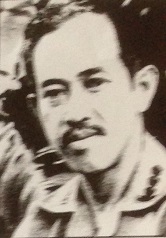
Lê Nguyên Bình http://www.generalhieu.com/dt_lenguyenbinh.htm
I met Binh several times during 1964 in the course of my Viet Cong captured document collection excursions and was deeply impressed. He was a modest, conscientious and capable officer, who was totally committed to doing his job. It was his intelligence which led to the first major set piece of the Vietnam war, the January 1963 battle of Ấp Bắc. It wasn’t his fault that the ARVN combat commanders made a hash of this, marking one of the major turning points in the war, as the Viet Cong realized they could beat the ARVN forces even with the high tech equipment being supplied by the US. His quiet competence also meant that, unlike many ARVN officers, he had no complexes in dealing with Americans, and even generously shared the documents captured by the Seventh Division with me, a lowly specialist, because he wanted to ensure that the U.S. fully understood the gravity of the situation. This, in his view, might lead to more informed and effective assistance to the ARVN. Although we met only a few times, he remembered me ten years later when we ran across each other in a chance encounter at the Prenn waterfall near Dalat, and had a cordial reunion. When I reflect on the many tragedies of Vietnam, my thoughts often turn to Binh as an example of one the precious assets of the Saigon government that were neutralized by corruption and incompetence at the top.
Sheehan writes, “Drummond discovered that his counterpart, Capt. Lê Nguyên Bình, a Catholic from North Vietnam who had fled south after the French collapse in 1954, was a conscientious officer whose performance had been underestimated by Cao and the Americans. He was friendly and eager to share his information. One reason Binh had been so little heeded in the past was that there had been no professional intelligence officer on the American side to work with him, even if Cao had permitted cooperation. No one whose expertise Cao could recognize had told him of Binh’s worth.”
It thus wasn’t only his Vietnamese superiors who negated Binh’s value to the war effort, but also the Americans – at least those who worked closely with him. Binh was responsible for the honest reporting of the “red” on the map that reflected rapidly growing Viet Cong control in 1963-64. Harkins unforgivably not only ignored this vital information but suppressed it because he felt it might make him look bad to admit that the war was not only not going well, but was in a tailspin. His successor, General Westmoreland, also had a penchant for favoring good news, but his flaw did not come close to matching Harkin’s self delusion. Even at this early period of the war in 1964 when I was in total support of American war aims, I knew enough to consider Harkins guilty of criminal malfeasance.
While there was bungling at the top of the U.S. command, those at the lower levels were learning about the situation at first hand. There was, of course, the legendary John Paul Vann and the Seventh Division advisory team. Less noticed, at the time, was one of the remarkable characters in the Vietnam war drama, Jean Sauvageot, who was not a member of the Seventh Division advisory team stationed at the Seminary (the main headquarters of Vann), but was head of a so-called “sub-sector” or district level advisory detachment in Ben Tranh district, the northernmost subdivision of Dinh Tuong province, along the road from the Mekong Delta to Saigon.
Perhaps Sauvageot tired of being called “Gene” by his military colleagues who could not manage the French pronunciation of “Jean” and he later went by his middle name André, which is how most people now know him. In the later years of war he was involved in a number of activities which took advantage of his fluency in Vietnamese, advisor to the pacification cadre training center in Vung Tau, and interpreter for prisoner exchanges with the Viet Cong. The spectacle of this wiry hyper-charged American officer speaking fluent Vietnamese never failed to make an impression.
He made an impression on me when I first encountered him. Unfortunately, I can no longer even remember why I was in Ben Tranh district in 1964, though it was probably on a document collection mission. I vividly remember walking down a small secondary road and spotting a lone figure coming toward me from the other direction dressed in black pajama’s – the characteristic peasant garb that came to be associated with the Viet Cong. He was about 5’ 10’’ and at a distance looked like a Vietnamese. On closer inspection, I noted that there seemed to be a discrepancy in his outfit. It then dawned on me that he was wearing U.S. Army combat boots. This was my introduction to André Sauvageot. I was even more amazed to find that he spoke Vietnamese, which was very unusual for an American officer at that time. (I think the surprise was mutual, he obviously had not anticipated encountering a Vietnamese-speaking American on this remote road in Ben Tranh).
André’s district job was the result of a DOD decision in mid-1964 to extend the advisory effort below the province (sector) level down to the district. He had tried to get language training at Monterey, but was rejected, and sent to Vietnam with no language training at all, not even the shortened three month course which advisors usually were offered.40 André was one of the few Americans fluent in Vietnamese who was entirely self-taught. His main language informant was his interpreter, a Northerner, but he also spent many evenings in conversations with local Vietnamese in the town of Ben Tranh – one of the few Americans to reach out into the larger society in which he was operating. Perhaps this is why André eventually became critical of the war in its later years, and regarded it as a mistake (as one might infer from the hat he is wearing in this 1999 photo at the home of Mike Eiland, then attached to the U.S. Embassy in Hanoi). Nayan Chanda, who wrote the definitive book on Vietnam’s post-1975 problems (Brother Enemy) is between Sauvageot and Eiland). Perhaps it is not accidental that many linguists became disenchanted with the war, in part to their closer proximity to the Vietnamese who bore the heaviest burden of America’s miscalculations.
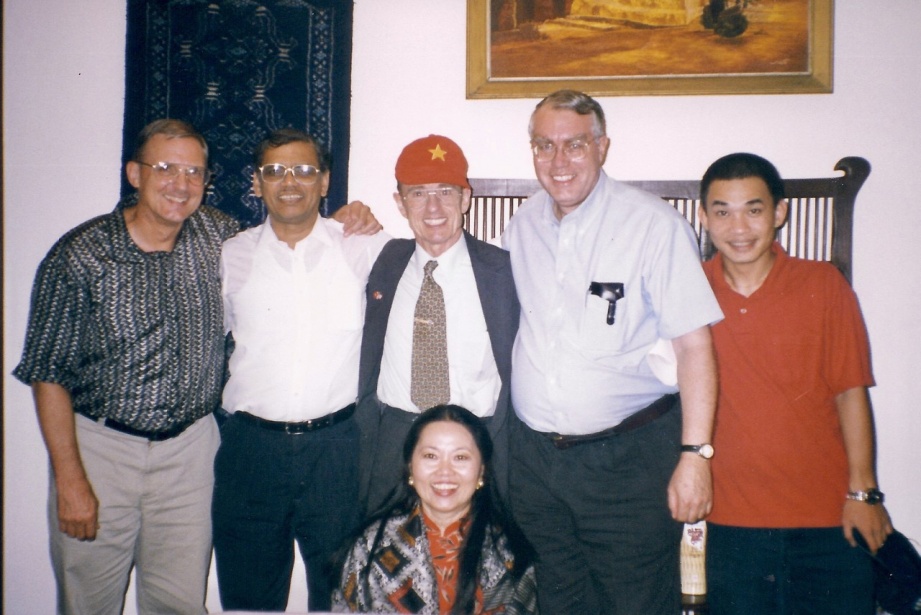
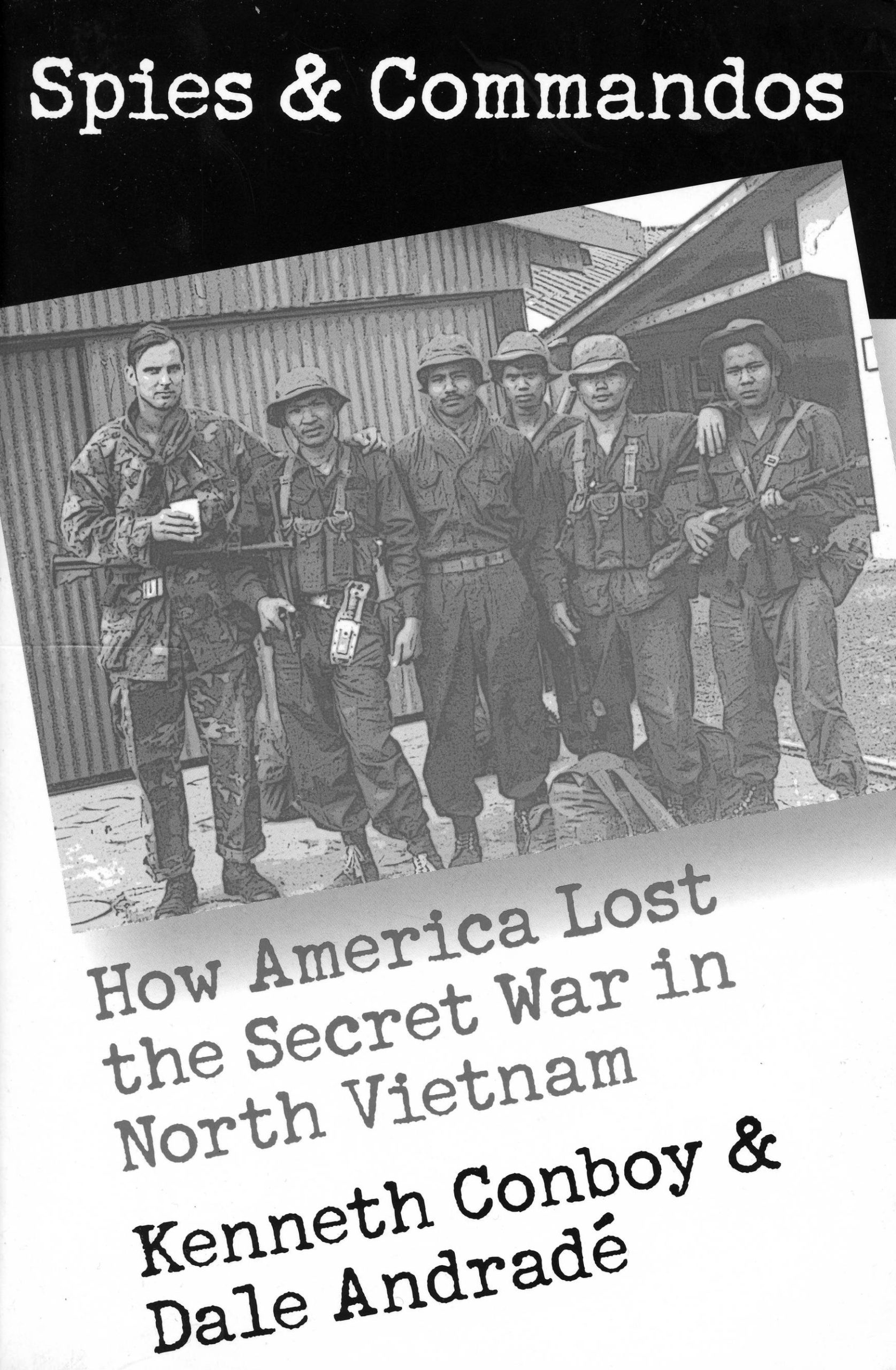
Mike Eiland was at one time in charge of Operation Daniel Boone which was responsible for reconnaissance for the American bombings in Cambodia in 1969 and 1970. He is on the left with ethnic Cambodian commandos in this cover photo of the book, which briefly mentions my adventure on Tiger Island.
As the American involvement in the war escalated in 1964, MACV began to take a more direct and hands-on look at the situation. Sometime in early 1965 I accompanied Captain Carpenter from MACV headquarters to a hamlet close to the village of Bến Sức on the outskirts of the Iron Triangle northwest of Saigon. Bến Sức itself became famous as the site of a later evacuation and subsequent leveling by B-52’s in 1967, chronicled memorably by the New Yorker journalist Jonathan Schell. We witnessed the start of a forced evacuation of the entire hamlet, livestock and all. I didn’t understand as I watched the exodus of families with all their worldly goods in an oxcart, headed for a squalid refugee camp somewhere, that I was witnessing an early example of pacification by depopulation, with which I became painfully familiar some years later. Once depopulated the hamlet near Bến Sức was leveled by B-52s, a preview of the later fate of Bến Sức .
Sometime after that, the entire area was firebombed in a novel, but unsuccessful attempt to create a firestorm of such intensity that it would produce a thermal inversion that would incinerate the entire jungle around Ben Suc. The project was advised by the Advanced Projects Research Agency (ARPA) which would supervise the RAND project I was involved in after leaving the military, and the US Forest Service, on the grounds that since it knew how to put out forest fires, it must know how to start them.
The firestorm experiments started in 1965. “… [T]he first burning, Operation. Sherwood Forest, was tried early in 1965.” A U.S. officer described it as “a massive attempt to burn out a defoliated section of the Boiloi Woods in the hopes of denying the enemy an extremely vital base camp area.” “For the next year,” the officer said, “several fire storm projects similar to the Boiloi Woods effort were made in conjunction with the Vietnamese Air Force. While the attempts to ignite the defoliated area met with limited success, the effect of the defoliant itself significantly improved visibility for observation.” While the attempts to ignite the defoliated area met with limited success, the effect of the defoliant itself significantly improved visibility for observation.”41 At the time I accepted the obliteration of an entire jungle and displacement of a hamlet population as a necessary military measure, but as the war dragged on inconclusively the justification of expediency wore increasingly thin for me. Moreover, expediency assumes that the controversial measures taken will be effective and the benefits would exceed the costs. In this, as in most cases in Vietnam, they were not and did not.
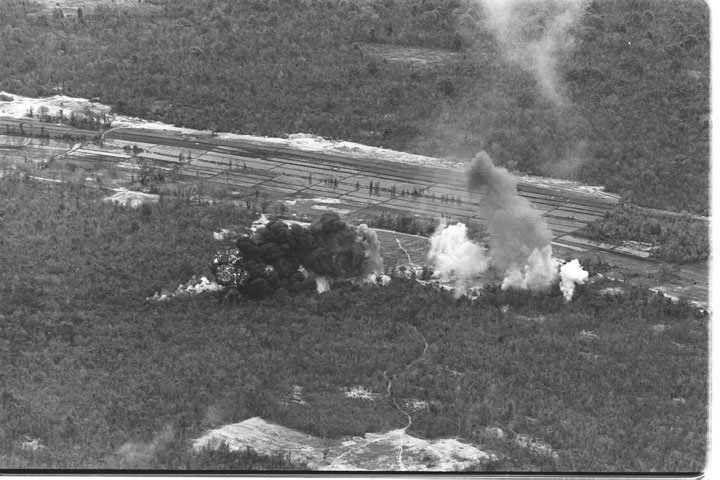
Vietnam: A Television History; The airstrike against Boi Loi Woods. Part of The Vietnam Collection. http://openvault.wgbh.org/catalog/I_1504D27985CC4BBBBE7132651FB9E764
Because the operation I witnessed with Captain Carpenter was a precursor the later notorious story of Bến Sức it is worth quoting Schell at some length.“For the Americans, the entire Saigon River area around Ben Suc, including particularly a notorious forty-square-mile stretch of jungle known as the Iron Triangle, had been a source of nagging setbacks. Small operations there were defeated; large operations conducted there turned up nothing. The big guns shelled and bombed around the clock but produced no tangible results. The enemy “body count” was very low, and the count of “pacified” villages stood at zero.”42 Schell did note that a number of villages in the area had, in fact, been brought under government control by Diem’s Operation Sunrise in 1962, but most of these had been retaken by the Viet Cong by the time of our visit in early 1965 the small remaining island of GVN control was considered unsustainable and the evacuation was an acknowledgement of this.
Schell then described Operation Cedar Falls, which led to the obliteration of Bến Sức in early 1967. It “involved thirty thousand men, including logistical support, and it was planned and executed entirely by the Americans, without the advance knowledge of a single Vietnamese in the province. … A plan was made to attack Ben Suc, but Ben Suc was regarded as an objective quite separate from the operation’s principal target—the Iron Triangle. The Iron Triangle is a patch of jungle bounded on the west, for about thirteen miles, by the Saigon River; on the east, also for about thirteen miles, by National Route No. 13; and on the north, for six miles, by a nameless smaller road. Ben Suc lay just beyond the northwest corner of the Triangle.”43
“Until the Cedar Falls operation, the Triangle long had a reputation as an enemy stronghold impenetrable to government troops, and had been said to shelter a full division of enemy troops and also a vast system of bunkers and tunnels used by the Front as headquarters for its Military Region IV, which surrounds the city of Saigon. American intelligence had also received reports of a twelve-mile tunnel running the length of the Triangle from north to south. The operation was the first move in a newly devised long-term war strategy in which large American forces would aim primarily at engaging the main forces of the enemy and destroying their jungle bases one by one, while arvn troops would aim primarily at providing security for the villages thus freed from Front control.”
“… After the jungle had been heavily shelled and bombed, the 1st Division troops were to flatten the jungle in fifty-yard swaths on both sides of the road, using sixty bulldozers airlifted in by the huge, two-rotor Chinook helicopters. Then they were simultaneously to destroy the villages of Rach Bap, Bung Cong, and Rach Kien, evacuate the villagers, and start cutting broad avenues in the jungle with special sixty-ton bulldozers nicknamed hogjaws. These drives would be supported by air strikes and artillery barrages against the jungle. American troops would enter the Triangle behind the bulldozers, in an attempt to engage the enemy division that was rumored to be there and destroy the enemy headquarters.”
As for the village of Ben Suc, Schell was told “We’ve run several operations in this area before with arvn, but it’s always been hit and run—you go in there, leave the same day, and the V.C. is back that night. Now, we realize that you can’t go in and then just abandon the people to the V.C. This time we’re really going to do a thorough job of it: we’re going to clean out the place completely. The people are all going to be resettled in a temporary camp near Phu Cuong, the provincial capital down the river, and then we’re going to move everything out—livestock, furniture, and all of their possessions.” This is what Captain Carpenter and I witnessed in the hamlet adjacent to Ben Suc in early 1965.
“The purpose here is to deprive the V.C. of this area for good. The people are going to Phu Cuong by barge and by truck, and when they get there the provincial government takes over—it has its own Revolutionary Development people to handle that, and U.S. aid is going to help.” A reporter asked what would happen to the evacuated village. “Well, we don’t have a certain decision or information on that at this date, but the village may be leveled,” Major Dixon answered.”44
The Corporal and the Ambassadors
I met both Ambassador Henry Cabot Lodge and his successor Maxwell Taylor in the 1964-1965 period. I can’t remember exactly when, but Lodge’s tenure ended when he was replaced by Taylor in June 1964. Taylor served as Ambassador for a year. In both cases the reason was simple; both men knew my father well. He was a prominent figure in Washington’s national security circles as well as a Harvard professor and had had extensive dealings with both men, so they were simply doing him a courtesy by meeting me. In part this was prompted by my deficiencies as a letter writer, and it was my father’s way of trying to find out what I was up to and how I was doing, though keeping tabs on a corporal was not usually the portfolio of an ambassador.
My superiors at MACV headquarters were astonished when they received a call from the U.S. Embassy to send me over to see the Ambassador at a time they had designated. Even the top officers at MACV rarely saw the Ambassador, let alone a lowly specialist in a menial job. They had no idea what this was about, but followed orders and sent me on my way. I had never been inside the Embassy, an antiquated building that was the target of a devastating bombing the following year and, of course, had never met Lodge.
I cooled my heels in his waiting room. His staff assistant, Tony Lake, then a very junior foreign service officer and later Bill Clinton’s National Security Advisor, introduced himself. He didn’t have any idea what this was about either. I observed Lake in action with interest. He looked nervous and tentative as he frequently opened Lodge’s door a crack and peeked in to see if the great man was ready to receive his next appointment. My earlier aspiration to be a foreign service officer dissipated as I watched Lake, obviously at the top of his cohort of foreign service officers to even be in this job, reduced to the role of a mere factotum, fearful of being too intrusive a presence in the great man’s orbit. It is certainly unfair to judge Tony in this way, since that was his job, but if that was the price one had to pay to become a diplomat – hovering obsequiously, awaiting the pleasure of the big man, it didn’t appeal to me.
Evidently it didn’t bother Tony Lake. A later profile of Lake wrote: “In Vietnam, as he would throughout his career, Lake caught the eye of an important man, serving as a staff assistant to Ambassador Henry Cabot Lodge. Writing later in the New York Times Magazine, Lake described “the exhilaration of being present at great events, watching men make decisions that were reported in the newspapers, or more glamorous still, that were hidden carefully from reporters.”45 And who could gainsay this view?
A 2019 biography of Richard Holbrooke compared the career paths of Lake and Holbrooke, underlining the fact that Lake’s ostensible diffidence masked an underlying drive to succeed. He was, says George Packer “so competitive that he knew winning required detachment. Focus hard but don’t care so much that you can’t bear to lose, because then you will lose. Years later, when his students at Georgetown would ask him how to become secretary of state, he would answer: ‘If you eat turds for the rest of your life to become someone, either 1) you’ll achieve it and discover you’re not happy, or 2) because you’re eating turds and your ambition is so obvious, you won’t get it.’ Maybe he had Holbrooke in mind. Lake kept his ambition more tightly wrapped, his relation to it was more ambivalent, but you would have been badly mistaken to believe him when he sometimes denied it was there at all, and the mistake would end with you losing to him.”46 Tony went on to a successful academic career, and also made it to the top of the foreign policy food chain, where he too, no doubt, had minions scurrying around to keep the boss happy. When, as Clinton’s national security advisor he was in line for the job of negotiating an end to the tragedy in Bosnia, he deferred to Holbrooke, who characteristically seized the opportunity to present himself as the successor to Henry Kissinger. Holbrooke’s biographer writes, “In truth [Lake] wanted the job for himself… yet Lake saw himself as a dutiful civil servant who avoided the limelight, the powerful figure just outside the picture frame.”47 Based on my brief encounters with both men in 1964-65, as well as sporadic encounters later (a 1980 meeting with Holbrooke, then Assistant Secretary of State for Asia, prior to embarking on a two month Fulbright trip to various ASEAN countries, and several extended conferences which included Tony Lake organized by former Senator Dick Clark to discuss normalization of relations with Vietnam in the late 1980s and early 1990s) I could have predicted this outcome.
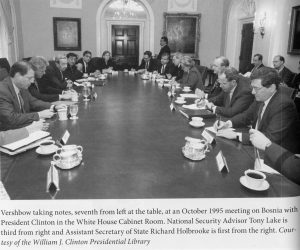
The meeting with Lodge was cordial but pro-forma. He expressed his admiration for my father, and told me that my father had been concerned that he had not heard from me for a while and had written to find out what was going on. This was true, but of course my father, having just retired from both his teaching position at Harvard and his position as a consultant to Dean Rusk in the State Department, was using my presence in Vietnam to keep the lines of communication to Lodge open and remind Lodge he was still on the scene and following events. I assured Lodge that I would do my filial duty and write more often. This was followed by a brief discussion about my work at J-2 MACV. Tony Lake ushered me out when the interview was over.
Lake’s successor as assistant to the Ambassador was Richard Holbrooke, served the same function under Lodge’s replacement General Maxwell Taylor, although with more panache and self-promotion – qualities which later brought him a reputation as the leading star in the American foreign policy firmament. A profile after Holbrooke’s death wrote “Next to Holbrooke’s desk in his office, on the first floor of the State Department, hangs a black-and-white photograph of him as a young man, walking in the sun-saturated Mekong Delta next to Ambassador Maxwell Taylor and several Vietnamese officials. Although Holbrooke made his international reputation by negotiating peace in Bosnia, his professional life was shaped in Vietnam. ‘I lived, ate, and slept Vietnam,’ Holbrooke wrote in an unpublished 1992 essay. ‘At times, I thought I knew more about it than almost anyone else—certainly more than anyone higher-ranking than me in the U.S. government.’ Holbrooke’s experience with Vietnam foreshadowed, in uncanny ways, his latest and, he insists, final mission.”48 Although the remark was obviously self-serving, Holbrooke’s comment that there was an inverse correlation between high rank and understanding of the situation, and that this understanding was greater the closer you got to the bottom levels of the American hierarchy, was largely true.
My meeting with Taylor went much the same way as the encounter with Lodge. Holbrooke was not satisfied with being a mere observer of the power game, and used his modest gate-keeper position as a way to insert himself into policy discussions that were well above his pay grade as a junior foreign service officer. He described how this was facilitated by a lack of senior experts on Vietnam, which left a vacuum for his (and my) age cohort to fill. Before his death, he engaged in the following exchanges on the PBS program Frontline: Asked what brought him to Vietnam in the first place, Holbrooke replied “I graduated from Brown in 1962, at the high moment of American idealism. I was in college, a sophomore, when President Kennedy delivered his inaugural. And I can remember watching [in] the student lounge at Brown. And the electricity when we heard, for the first time, “Ask not what your country can do for you, ask what you can do for your country.” Now it’s a cliché that you see on MTV. But then it was electrifying. People joined the Peace Corps, people went on freedom fighter rides down through the south to integrate drugstores and soda fountains. And some of us went into the government.”
Asked what his job was during his first years in Vietnam, Holbrooke’s answer was: “Well, I had two different jobs. The first half of my three and a half years in Vietnam, I was in the Mekong Delta, living with the military, as a civilian, carrying out the so-called Pacification Program; dispensing cement, and barbed wire, and so on, through a disbursement system to the Vietnamese authorities, who were supposed to build schools and ditches, and defend themselves. So it was a shambles of a program, and it didn’t really work. I was twenty-two, and I didn’t know what I was doing.”
“Did you know that it wasn’t working?,” Holbrooke was asked. He replied “I knew that areas we were reporting to Washington were under government control were not. And by the simplest of methods. I would say to the province chief, ‘Let’s drive out to this hamlet, or this village.’ And he’d say, ‘Well, I can’t do that until I get a company, or a battalion of troops to escort you.’ I’d say, ‘Well, then, it isn’t very safe, is it?’ And yet we were reporting it as under government control. And it was dangerous. I mean, you got shot at. …But then, the second half of my tour was entirely different. I was in the embassy as a staff assistant to the ambassador. First Maxwell Taylor, and then Henry Cabot Lodge.”
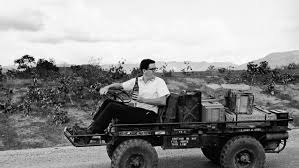
Richard Holbrooke as province AID official in Vietnam
The Frontline interviewer asked Holbrooke to describe the evolution of his thinking about the Vietnam War. He replied “It’s impossible for me to reconstruct now the stages of my evolution and my thinking about Vietnam. … I can remember when the bombing started. …And I remember thinking how inconceivable it was that we were going to be bombing North Vietnam. But when we started bombing North Vietnam, we got ourselves caught immediately in a trap. And here is where the hawks and the doves, the liberals and the conservatives, can both agree: the policy that was followed, primarily the policy calibrated by the Secretary of Defense, Robert McNamara, was a disaster. It simply doesn’t matter whether you were a hawk, or a dove. The calibrated bombing was wrong. It was a flawed policy. There’s no question about it. Whether one was a hawk or a dove, this policy was a mess. … I was given a very privileged position, as were some of my colleagues. As very junior officers, we were given access to the highest level policy-makers, because the normal accumulation of professional expertise was non existent for Vietnam. A lot of it, there just weren’t any Vietnam experts in the government. The China hands had been pretty well either been cleaned out during the McCarthy period, or else they’d gone underground. They didn’t want to repeat the whole drama in Vietnam. So a lot of the junior officers–Frank Wisner , Peter Tarnoff, Les Aspin, Tony Lake, John Negroponte, a lot of others–all of whom rose to very senior positions in the government in the last decade, all were given a chance to talk directly to senior policy-makers. And we spoke up. … I told people what I thought. … I was not questioning the objectives in Vietnam at the time, I was questioning the method. The objective was to save the southern part of Vietnam from a communist subversion aggression. That was a legitimate objective to us, when we went over in the early ’60s. Then it turned out that the situation was not as portrayed. That is, we weren’t doing as well as we said we were, to ourselves and to the public. That led to the famous credibility gap.”
“Then it turned out that no matter how much we tried, we couldn’t stop the Viet Cong and the North Vietnamese, and that our South Vietnamese allies were not organized enough to do the job, and they were too corrupt. But the North Vietnamese were just going to keep on coming. And that led, inevitably, to the sequence that unfolded between 1965 and 1973, with the bombing of the North, the negotiations, more bombing, more negotiations; and, finally, the Nixon/Kissinger agreement of 1973, which inevitably led to the loss of South Vietnam. There was no question that that agreement was the end of South Vietnam.”49
While Lake was content with “being present at great events, watching men make decisions that were reported in the newspapers,” Holbrooke wanted to be part of the action. He relished being “given a chance to talk directly to senior policy-makers. And we spoke up. … I told people what I thought.” Of course in the end, as Holbrooke recognized, whether as an observer or a participant, the end result was dismal. Perhaps the people who learned the most from this tragedy were those who were closest to where the rubber met the road, rather than those who sat at the right hand of power.
Excursions Outside Saigon
Sometime in 1964 I was ordered to accompany a newly arrived major to the air base in Biên Hoà. The Biên Hoà highway was a twenty mile stretch of highway recently built with U.S. aid. It looked like a California freeway, but was nearly empty of traffic. Mai and I used to go on weekend drives on this highway in the big American car of Nguyễn Xuân Phong, the boyfriend of Mai’s Georgetown roommate Mỹ Lương because it was the only secure road outside of Saigon which allowed an escape from claustrophobic isolation in a city surrounded by Viet Cong controlled territory.
Phong was an Oxford educated sophisticate who briefly headed the Saigon negotiating team in Paris during the Nixon Period. I always felt inadequate in the presence of Phong’s elegant and polished Oxford English, and suave demeanor but took some consolation from the fact that my Hanoi dialect in Vietnamese was more upscale than his thick Southern Delta Bac Lieu accent.50
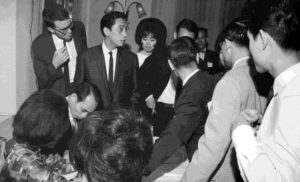
Nguyễn Xuân Phong between DE and Mai at our wedding reception in 1964
Because I regarded the Bien Hoa highway as totally secure, I was mildly amused by the newly-arrived major’s obvious apprehension about the prospects of Viet Cong ambush. Near Biên Hoà our Ford sedan turned off the highway toward the airport on an unimproved dirt road. The major, who was from the Armor Corps, sat in the front passenger seat. Leaving the highway made him even more apprehensive. He looked around uneasily and observed, “This is ideal tank country.” I only later realized that what he meant was that his subliminal wish was that he was inside a tank instead of a Ford sedan while going through what he assumed was dangerous “Indian Country.” At the time I thought it was amusing that he thought tanks would be the answer to the Viet Cong guerrillas. I guess, in a way, he had the last laugh when, in 1975 North Vietnamese tanks rolled through this very area on their way to crush the crumbling resistance of the Saigon forces as they went down in defeat. Still, when our car hit a pot-hole which popped the hood with a bang and forced the car to halt, I thought his reaction (he nearly hit the ceiling from the jolt and in panic, thinking we were under attack) did not bode well for a long tour in Vietnam
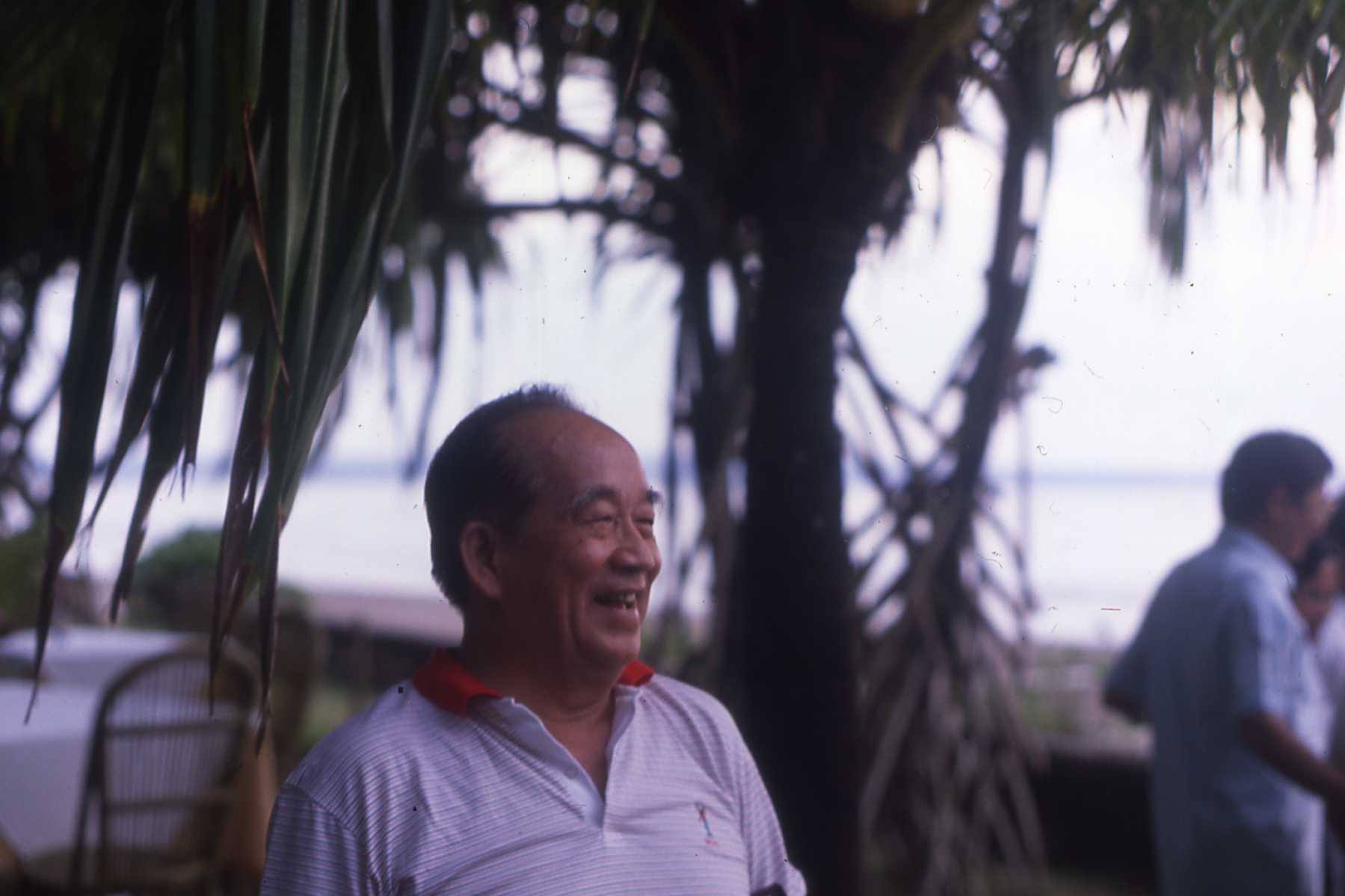
Nguyễn Xuân Oánh at US-Vietnam Dialogue conference in Bali 1990.
I didn’t meet one of Mai’s roommate’s other boyfriends until much later, but Nguyễn Xuân Oánh played a walk-on role in the revolving door politics of South Vietnam in 1964. Oánh had received his Ph.d from Harvard. Subsequently he taught at Trinity College in Hartford. When discussing where he taught, he used the Vietnamese pronunciation of “Hartford” which dropped the “t” and made it sound like “Harvard.” He went to work for the IMF for a while (and thus was considered a great catch for the young Vietnamese college women of Mai’s cohort). After the overthrow of Diem he returned to Vietnam.
He married the film actress Thẩm Thúy Hằng, known as “the beautiful person from Bình Dương province” or, less politely “the grapefruits from Bien Hoa (qủa bưởi Biên Hòa).” “Grapefruits” was a reference to her very un-Vietnamese bust size, and the most famous grapefruits came from Bien Hoa province. He became Vice President of the Republic of South Vietnam in 1964 in order to capitalize on his presumed close connections with the Americans as well as his economic expertise. Americans derisively called him “Jack Owens” – an Americanization of his Vietnamese name – to underline how Americanized he had become. In my estimation “Bien Hoa grapefruits” was a distinct step down from Mai’s petite, graceful and attractive roommate Mỹ Lương, who had been voted “Miss Foreign Service” at Georgetown, and who had stopped John F. Kennedy in his tracks during a crowded White House reception for foreign students. Perhaps his tilt toward “Bien Hoa grapefruits,” who was regarded by many Vietnamese as vulgar rather than glamorous, was another measure of the Americanization of “Jack Owens.”
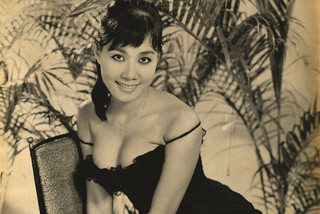
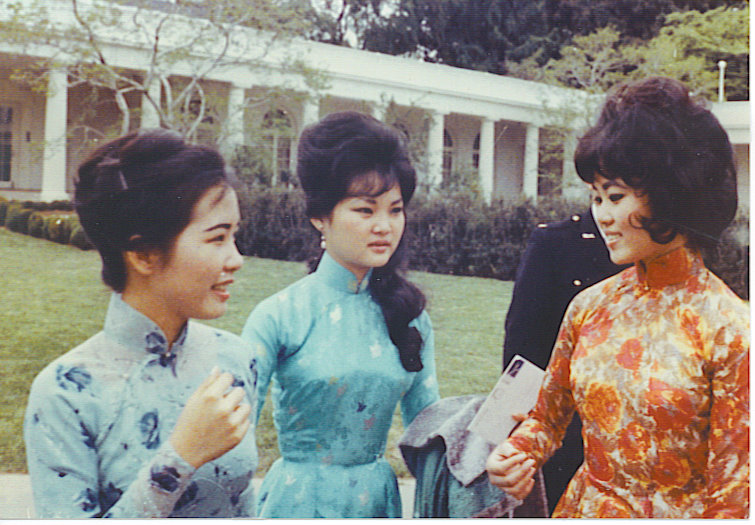
Thẩm Thúy Hằng – Mỹ Lương is on the left in the other photo taken at a White House reception
Oánh was briefly acting Prime Minister of Vietnam during one of the numerous political turnovers of the period. In a television interview conducted in English shortly after he had taken this job, Oánh was asked “who can lead Vietnam to victory?”. His reply was a smilingly frank admission that that it was unlikely that the South Vietnamese leadership would be Churchillian: “Well, I guess you’ve got me there.”[4] It was another indication that the non-communist leadership in Vietnam at this critical juncture would find it difficult to step up to the challenge they faced.
The Gulf of Tonkin
The Gulf of Tonkin incident(s) of August 2 and August 4, 1964 triggered the escalation which led to direct American combat intervention in Vietnam the following year, and all the subsequent fateful consequences of this unwise decision. The origins of this turning point in the Vietnam War were, first, the December 1963 decision by Hanoi to escalate the conflict in an attempt to finish off the South Vietnamese government before it could recover from the chaos and confusion of Diem’s overthrow, and before the United States, still in shock over Kennedy’s death, could effectively respond.
The second major development leading toward the Gulf of Tonkin was Washington’s decision in December 1963 to escalate its own operations against North Vietnam, which led to a series of commando operations and naval operations directed against the North. These operations were part of something called Operations Plan 34A. At the time I was the proverbial frog in the bottom of the well, seeing only a narrow sliver of the total picture. I had no idea about the decisions by Hanoi and Washington at the time.
In the aftermath of the war, I learned that the fatal flaw in the US strategy toward Vietnam from the beginning was that it avoided a realistic appraisal of the chances for success and, even more importantly, avoided any attempt to define what would constitute success and calculate what the necessary costs would be. To the extent that the U.S. had a strategy, it was, as Dan Ellsberg has written, do the minimum necessary to avoid losing. As I learned from Vietnam, an effective foreign policy requires bringing resources into alignment with interests. If the cost of the resources required to succeed exceed the benefits, don’t do it.
In the absence of strategy, the U.S. simply had a policy: do whatever it takes to avoid losing and to present a façade of activism in order to avoid being criticized for defeatism. What “victory” might mean or require was, amazingly, never systematically addressed. This was evident in Oplan 34A. Early on McNamara enthusiastically informed President Johnson that the plan would present “a wide variety of sabotage and psychological operations against North Vietnam from which I believe we should aim to select those that provide maximum pressure with minimum risk.”51 Within months, he concluded that it was a failure but did not call it off. The plan envisaged the transfer of clandestine operations directed against North Vietnam from the CIA to MACV, which is why I eventually became involved.
Even before the plan was implemented its proponents did not believe that Oplan 34A would have a significant impact on Hanoi. One assessment concluded that it was “far from clear whether even the successful conduct of the operations … would induce Hanoi’s leaders to cease and desist.” Even General “Brute” Krulak, a proponent of covert actions, concluded that Hanoi “toughened by long years of struggle” would not easily be persuaded by a punitive program to halt their support of the Viet Cong insurgency unless the damage inflicted on them is of great magnitude.”52 One might say, that to the extent that my analysis of the Oplan 34A as the first stage of a plan to bomb North Vietnam is correct, it might be more plausible that it would inflict substantial pain on Vietnam, but this connection was not made explicit at the time.
As one history of covert operations notes: “On 2 January 1964, the interdepartmental committee reported its analysis of Plan 34A-64 and outlined the approved concept for the four types of forces to employed by MACSOG (MACV Special Operations). The covert operations force under the authority of OPLAN 34A would carry out increasing levels of physical and psychological harassment, to include air strikes against appropriate targets, inside North Vietnam.”53 In short order, it was recognized that small scale covert operations were ineffective and escalation set in. By March 1964, “Washington had changed its views on the assumptions underlying Plan 34A-64, so boldly championed by McNamara the previous December,” and the CINCPAC (Commander in Chief, Pacific) ordered a new Plan 37 to rapidly climb the ladder of escalation to focus more on air strikes, which had “been embodied in Plan 34A as one of the higher notches of escalation.”54 Thus the 34A operations are best understood as the first step in the escalation leading to the bombing of North Vietnam and, ultimately, the commitment of U.S. ground forces. McNamara had been confident that he could control the cat and mouse game of “signaling” in which rational-actor calculations on both sides would keep things from getting out of hand, but he was proven disastrously wrong.
The first maritime operations of Oplan 34A were commando raids against North Vietnamese coastal facilities, all of which were failures. So the US planners turned in a different direction. Dale Andrade and Kenneth Conboy’s book summarizes what happened next in authoritative detail, and I quote it here in extenso.
“Because cross-beach missions had been unsuccessful, the Naval Advisory Detachment planners conjured up an entirely new kind of maritime operation. Code-named LOKI, it involved kidnapping the crews of North Vietnamese fishing junks and spiriting them down to Cu Lao Cham, an island twenty-two kilometers off the coast of Danang. There SOG [MACV’s Special Operations Group) had built a small base in the island’s mountainous interior to serve as the notional headquarters for the SSPL.”55 [The Sacred Sword Patriot’s League was a fictitious group created by the CIA to give the North Vietnamese the impression that they had a genuine resistance group in their midst, force them to divert resources to tracking down this fictitious group, and leave the North Vietnamese population with the impression that there was an alternative to the regime they lived in. It was, of course, a total failure].
“Populated by monkeys and a handful of locals, the site – code-named Paradise Island – was far enough from Danang to let SOG operate in secrecy, yet close enough to land reinforcements if they were needed. On Paradise Island, the SSPL compound was festooned with banners and other propaganda from the notional front. South Vietnamese personnel, all dressed in SSPL ‘uniforms,’ acted as the camp’s cadre. According to plan, captured junk crews would be taken to the island while blindfolded, then marched up to the mountain redoubt. There they would be interrogated by the SSPL for up to two days.”
“The purpose of the interrogation was twofold. First the captives would be milked of low-level intelligence on coastal defense arrangements, the fishing industry and the North Vietnamese economy in general. On a more subtle level, they would be exposed to the fact that a resistance movement was allegedly operating in their midst, information that they would spread among their peers when they were released back north. As a parting gift of good faith, the SSPL would give toys, radios, and other gifts to the returning fishermen.”
“On 27 May [1964] , the first junk capture mission – called LOKI 1 – was launched off the Quang Binh coast near Dong Hoi. Spying a fishing flotilla, the Swift closed in on one medium-sized junk. The crew, ostensibly members of the SSPL, led six fishermen aboard at gunpoint. Behind them a Nasty [a larger, faster boat] moved in and hooked the junk to a towrope. Together, they sped back south. Aboard the Swift, the kidnapped fishermen were blindfolded and huddled in a corner of the patrol boat. As they crossed the seventeenth parallel, the skipper brought the vessel to a stop as the detainees were transferred to a motorized junk for the rest of the voyage to Cu Lao Cham.”
“Sergeant David Elliott, [by this time I had been promoted to the rank of Specialist Fifth Class – a grade so exalted that it no longer exists], a linguist with MACV’s small translation section, was in Saigon when he received an emergency call from Danang. Without going into details, the Naval Advisory Detachment said it needed a translator in a hurry. Flying north, Elliott was picked up by three case officers and taken to a CIA safe house on the waterfront. There he was given a set of black pajamas and a Swedish K submachine gun, and together with the similarly garbed CIA men, went to the Naval Advisory Detachment pier and boarded a Swift bound for Cu Lao Cham.”56
The CIA man in charge of this operation, was in the final months of a transition of Oplan 34A from CIA to MACV control. I learned much later his name was Tucker Gouglemann, a grizzled veteran of America’s wars. I didn’t learn his name or much else about him until long after the war. I later learned had been wounded by the Japanese in the Pacific campaign, which was the reason he still walked with a limp. He had conducted small-boat operations during the Korean War. I still recall him harking back to his Korean War days and telling stories about the under-the floor heating of local houses in the bitterly cold Korean winter while we were chatting to pass the time on the three hour Swift boat ride to Cu Lao Cham.
Tucker Gouglemann introduced himself as “Bill.” Later I discovered that he had returned to Vietnam in the final days of the war in 1975 to bring out some Vietnamese he had adopted. He himself was unable to get out, and died in captivity, apparently under brutal torture. His broken remains (apparently over thirty bones were broken according to the medical examiners), were eventually returned to the US, and he lies in Arlington National Cemetery buried next to Francis Gary Powers of U-2 incident fame. His final days are clouded in uncertainty, but the broad outline is clear: he paid dearly for his service to the United States.
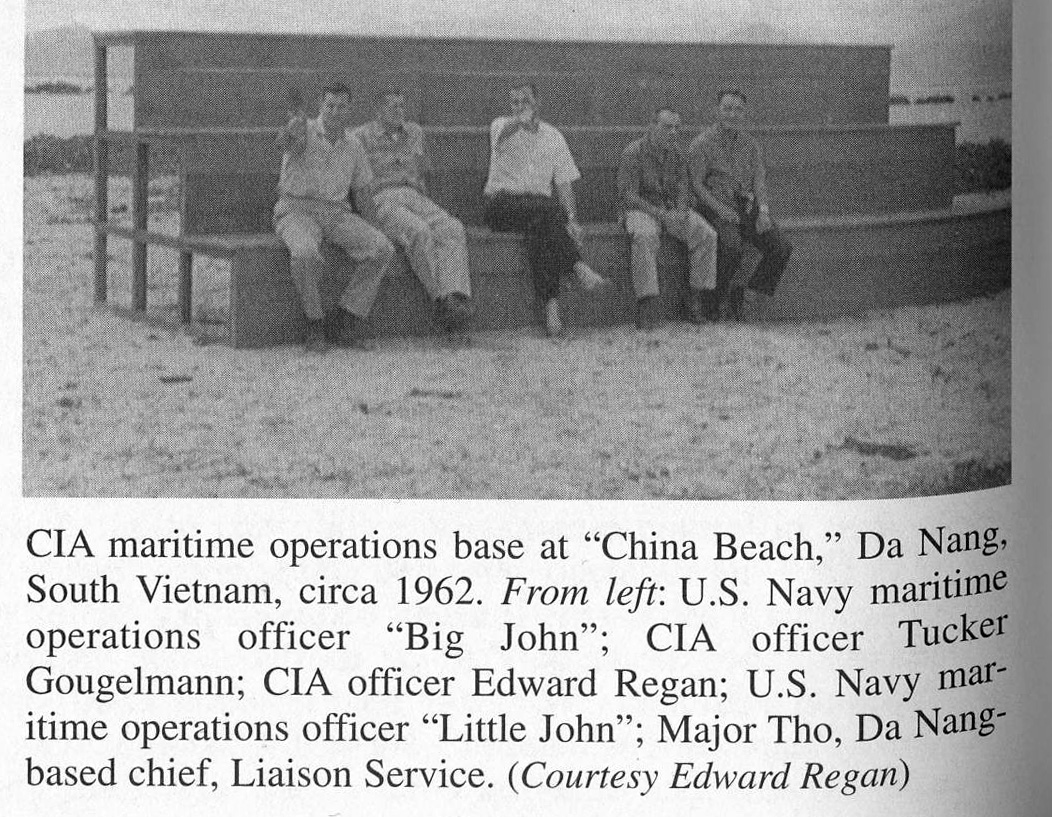
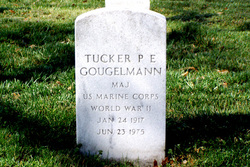
I didn’t doubt “Bill’s” bravery or heroism, but I did have some questions about his tradecraft and common sense. Why, for example, did we put on our black pajamas and pick up our Swedish K’s before we were out of view of prying eyes? We walked in full special operations garb down the main street of Danang in full view of the early morning throng, got into an LST tied to the main dock on the banks of the Han river which flows through the heart of the city. We could easily have changed into operational garb at the US naval base outside of town, where the LST dropped us off in order to transfer us to the Swift Boat that took us to Cu Lao Cham island. I thought that if Americans are going to attempt to do clandestine operations, they might try a little harder to honor the spirit of covert activities. But, of course, I didn’t know then that well before this operation, the Pentagon had largely written off the entire enterprise as futile and possibly counterproductive.
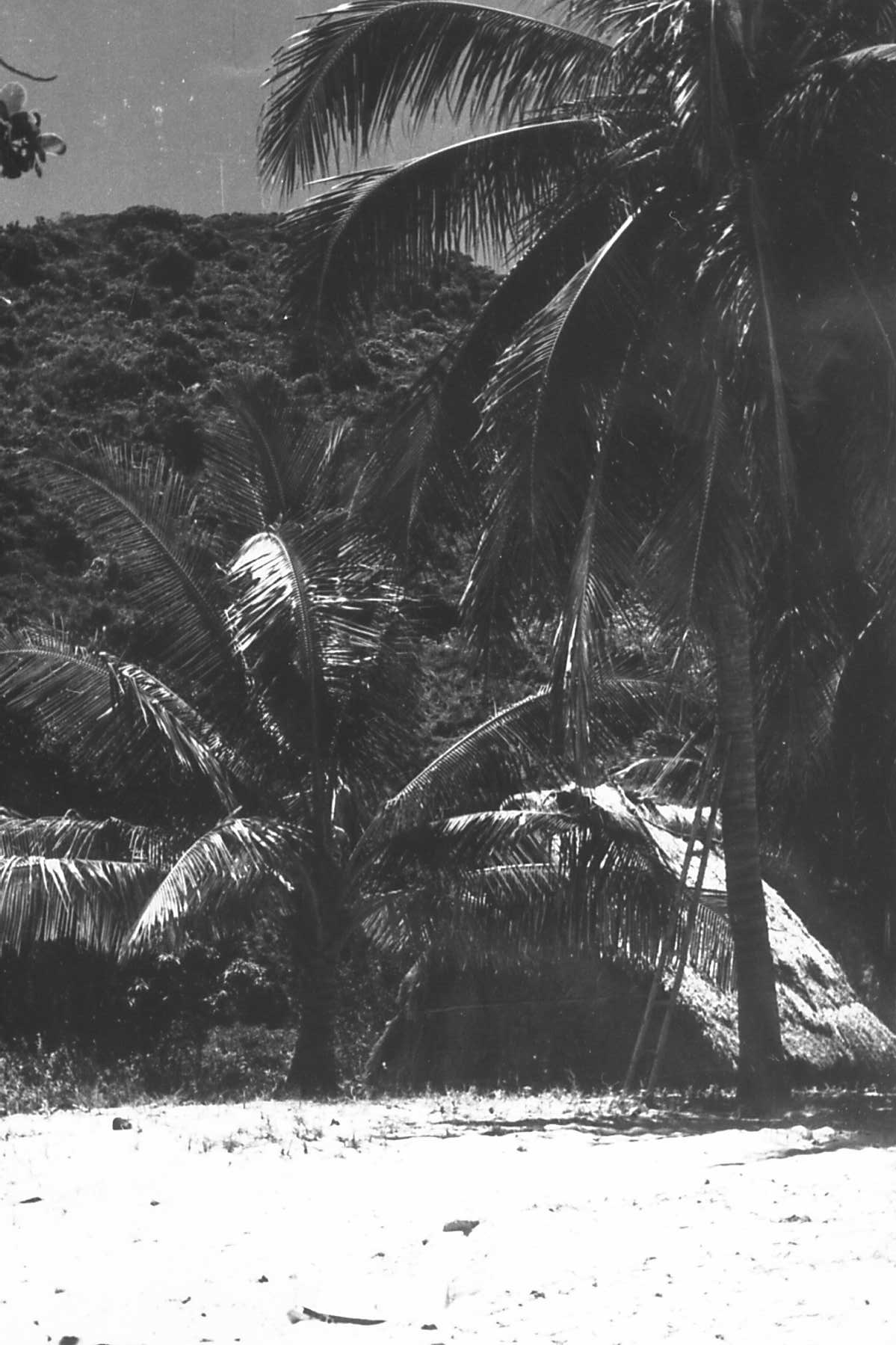
Cu Lao Cham – “Paradise Island” (sometimes called “Tiger Island”) May 1964
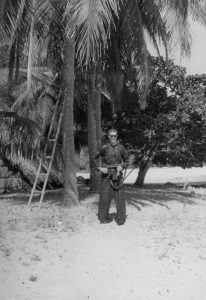
DE in special operations garb, May 1964.
Andrade and Conboy’s narrative of this episode goes on to say: “The island, Elliott found, was a tropical backwater. There were no signs of civilization, only a single tent erected near the beach. Reflecting on the serenity, it made him wonder why they had gone through the charade of dressing in the pajamas.”57
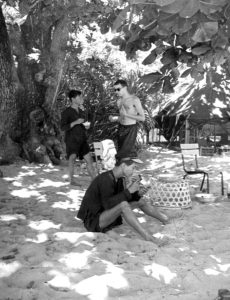
With South Vietnamese Commandos at SOG base, Cu Lao Cham island, May 1964.
The Vietnamese commandos who joined us on this operation were all originally from North Vietnam, most (possible all) Catholics who had fled to the South in 1954. They had been Diem supporters, but they were also the cannon fodder of the South Vietnamese army, and the ones who actually had to do the dangerous and dirty work of counter-insurgency with high risk and minimal rewards, while the better-connected Vietnamese in ARVN were often able to secure rear echelon jobs that kept them out of harm’s way. Andrade and Conboy report that between 1961 and 1967, fifty four teams of South Vietnamese recruited by the CIA were sent to North Vietnam, only to be killed or captured. In 1970 the Defense Department conducted a study of these operations. “Without exception, key SOG figures from the 1964-1968 era expounded on shortcomings of the program. Covert agent operations in North Vietnam, they agreed, had not worked for the CIA, did not work for SOG, and almost certainly would not work in the future. Many concluded that notional operations made up of phony teams to convince Hanoi that agents were penetrating their backyard had a better chance of success without such a high cost in human life.”58
I doubt that “notional operations” such as the one just described had any real effect in North Vietnam, but at least the South Vietnamese involved in this kind of operation (and there was probably overlap of this group and the commandos that were sent into North Vietnam) were luckier than their comrades, in that they were not sent to certain death or capture. The commandos I talked with had served at the same rank, in some cases, for over ten years. I admired their doggedness and was impressed by their cheerful acceptance of their situation, but the unfairness and social injustice reflected in their situation made me wonder about the survival prospects of a regime in which burdens were so unequally distributed.
Indeed, their ill-fated colleagues who had been consigned to inevitable death or capture on operations which the CIA and MACV knew were pointless and futile, were written off as the “collateral damage” of American blunders and illusions. By the time MACSOG had learned that the plan of turning the tables on Hanoi by inserting our own guerrillas in the North was a fantasy, they were left with the problem of cleaning up the mess in a way that left no evidence of the miscalculations that were involved in this misbegotten adventure. In one of the most disgraceful admissions of moral dereliction, among many in the Vietnam War, the MACSOG after action report on its covert operations said “We did commit most of these people without very high expectations at the time they were launched. … we knew they would surrender immediately upon landing, and they did. … The original assets we had in this effort were not capable of going anywhere and we had to get rid of them; at the same time, we couldn’t turn them loose in South Vietnam because they had been briefed and re-briefed on operations in North Vietnam. Our solution was to put them in the North. Many of them were captured…”59
But I did not know any of this at the time. Andrade and Conboy write: “As he [myself] and the case officers relaxed on lounge chairs, a Vietnamese dressed in identical black garb materialized from the jungle. He carried a set of interrogation reports from the fishermen being held at the SSPL compound in the island’s interior. Elliott immediately translated them for the case officers. ‘This continued for about two days,’ Elliott recalled. ‘We slept in the tent near the beach, and the Vietnamese, who was an ARVN captain originally from the North – a Catholic – would bring down the reports and I would translate them. It was mostly questions about [prospective bombing] targets, especially around Dong Hoi [just above the Demilitarized Zone].”
“His mission over, Elliott was taken back to Danang and the on to Saigon. The fishermen, meanwhile, were taken aboard a junk to the seventeenth parallel, then transferred to a Swift and shuttled further up the Quang Binh coast. A Nasty, junk in tow, followed behind. Once near Dong Hoi, the captives, gifts in hand, were given their boat and a fast farewell. With its first success in five tries, the Naval Advisory Detachment could not help but be pleased.”60
However, I have to agree with the conclusion reached by Andrade and Conboy. “In the final analysis, covert operations against the North Vietnamese became an end rather than a means. Throughout the long war, they became a crutch that allowed Washington to put off making hard decisions about expanding the war, thereby diluting the effect that Op 34A might have had on North Vietnam if there had been a clear and pointed purpose. Political constraints and a lack of understanding of the enemy doomed it from the start, but policy makers consistently believed that covert operations – no matter how poorly conceived – were better than nothing. General Westmoreland summed it up best when he observed that ‘in a war that as much as any in history pitted will against will, it was worth a try.’”61
Moreover, these operations had a negative side that went far beyond merely allowing Washington to temporize about hard decisions on escalation. They set the stage for an irreversible momentum toward escalation. My personal connection with the story of the escalation that followed our May 1964 operation is purely “notional” – to use the Oplan 34A terminology. It wasn’t anything that I witnessed or was involved in, but a hypothetical of what might have happened if I had been involved. I must state here that this is a completely imaginative reconstruction of the Tonkin Gulf incident, and most of the “what-if’ or “might-have-beens” in the following fabricated scenario (which I wrote shortly after some of the top secret details of the incident became public in 2004) are not only absurd – I knew that when I wrote it as a joke – but, as I continue to learn, even the fantasy was based on false premises. Still, explaining why my spoof essay is ridiculous does help clarify some important points about how the commando operations of Oplan 34A led inevitably to the Tonkin Gulf. Following is my 2004 essay.
“I coulda been a contender. I coulda been somebody “(Marlon Brando as the washed up boxer in the film On the Waterfront)”
“ How often do you wake up in the morning, open the newspaper, and discover that you could have changed the course of history? That’s what happened to me this week. Turning to the New York Times, I saw an article titled “Doubt Cast on Vietnam Incident, but Secret Study Stays Classified.”62 The relevant context is laid out in the first paragraphs. WASHINGTON, Oct. 28, 2005 – The National Security Agency has kept secret since 2001 a finding by an agency historian that during the Tonkin Gulf episode, which helped precipitate the Vietnam War, N.S.A. officers deliberately distorted critical intelligence to cover up their mistakes, two people familiar with the historian’s work say. The historian’s conclusion is the first serious accusation that communications intercepted by the N.S.A., the secretive eavesdropping and code-breaking agency, were falsified so that they made it look as if North Vietnam had attacked American destroyers on Aug. 4, 1964, two days after a previous clash. President Lyndon B. Johnson cited the supposed attack to persuade Congress to authorize broad military action in Vietnam, but most historians have concluded in recent years that there was no second attack. The N.S.A. historian, Robert J. Hanyok, found a pattern of translation mistakes that went uncorrected, altered intercept times and selective citation of intelligence that persuaded him that midlevel agency officers had deliberately skewed the evidence. Mr. Hanyok concluded that they had done it not out of any political motive but to cover up earlier errors, and that top N.S.A. and defense officials and Johnson neither knew about nor condoned the deception. “Translation mistakes?” Hmm, I said to myself, I used to be a translator in the Army Security Agency (the military arm of the National Security Agency). Wonder what this was all about. And then, for the first time, I learned the specifics of the Gulf of Tonkin deception. “Not all the details of Mr. Hanyok’s analysis, published in N.S.A.’s Cryptologic Quarterly in early 2001, could be learned. But they involved discrepancies between the official N.S.A. version of the events of Aug. 4, 1964, and intercepts from N.S.A. listening posts at Phú Bài in South Vietnam and San Miguel in the Philippines that are in the agency archives. One issue, for example, was the translation of a phrase in an Aug. 4 North Vietnamese transmission. In some documents the phrase, ‘we sacrificed two comrades’ – an apparent reference to casualties during the clash with American ships on Aug. 2 – was incorrectly translated as “we sacrificed two ships.” That phrase was used to suggest that the North Vietnamese were reporting the loss of ships in a new battle Aug. 4, the intelligence official said. The original Vietnamese version of that intercept, unlike many other intercepts from the same period, is missing from the agency’s archives, the official said. The intelligence official said the evidence for deliberate falsification is ‘about as certain as it can be without a smoking gun – you can come to no other conclusion.’”
So the mistake that set the deception in motion was made by a translator in Phú Bài. Phú Bài was a small US base near the city of Hue in central Vietnam. It was considered a hardship post because the small ASA contingent there was confined to base because of the political turmoil involving the Buddhists in Hue and the insecurity of the area around the base. For this reason, the most recently arrived translators were usually shipped out to Phú Bài and the desirable Saigon jobs went to the translators with seniority. I had graduated at the top of my class at the Defense Language Institute, but there were no Saigon slots available when I arrived in Vietnam, so I hung around waiting for an assignment. In early 1964 I got orders to ship out to Phú Bài. Shortly thereafter, I informed my superiors that I intended to marry a foreign national, and was stripped of my cryptographic security clearance and transferred to another unit. If it hadn’t been for Mai, I would have been the translator in Phú Bài – and I can assure you that even then I knew the difference between “two comrades” and “two ships.” A correct translation might have forestalled or avoided the Vietnam War and changed the course of twentieth century history. Ah well. David Elliott”
The semi-humorous fantasy that I might have saved the day with an accurate translation had I taken the assignment in Phú Bài has been quashed by what I have more recently learned of the still not completely solved mystery of the identity of the faulty translator. I did not realize, until recently, that there was also a Marine translation unit attached to Det. J although, later on when I was able to read Hanyok’s full report I noted that he mentioned this]. They were the ones responsible for monitoring North Vietnamese maritime communications, and thus the likely culprit was one or several of the Marine linguists. The Army ASA contingent was charged with monitoring land based signals communications and contacting the South Vietnamese commandos inserted into North Vietnam.
One of the former Monterey linguists was assigned to Phú Bài was engaged in this work. Jeff Sharlet’s brother Rob wrote that Jeff was “sent up to a place called Phú Bài just below the North Vietnamese border. Working side by side with a Marine unit, he translated North Vietnamese Army messages and liaised with commandos being slipped across the border.”63 Jeff became so disturbed by this work that he turned against the war, and started up the first antiwar newspaper directed toward GI’s in 1967, before his tragic early death in 1969.64
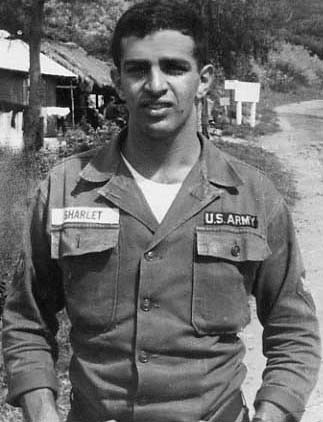
Jeff Sharlet, Det J linguist who founded the first GI antiwar newspaper
John Buquoi was also stationed at Phú Bài at that time and was also disturbed about what he was hearing. “John was at Phú Bài, ASA’s northernmost listening post where the linguists liaised by radio with South Vietnamese commandos infiltrated across the border. Often as not, the commandos were soon killed or captured by the Communist border troops while watchers just as young as they/listen here, close by, listening/listening, listening, waiting/until their faint transmissions end.”65 John wrote in an email on April 4, 2019, “Phú Bài, for me, was not a happy assignment. I ended up working with Ralph Adams as a camp linguist involved in the day to day base operations and nothing ‘mission-related’. Jeff Sharlet, Bill Jernigan and some other linguists from the PI did the monitoring of the commando operations. After 4 months, I threatened the CO, Major Weaver, with a congressional complaint if I didn’t get sent back to TSN; I ended up on the next plane back.” John and I both believe it likely that he was sent to Phu Bai to fill the slot vacated by my transfer to MACV. This raises the possibility that if I had gone to Phú Bài, I might have either been monitoring the doomed commandos operating in North Vietnam like Jeff Sharlet, or doing day to day base operations-related translations like John Buquoi instead of schmoozing with their fellow commandos in the comfort and safety of “Paradise Island.” So much for the “contenda” fantasy.
In a way, though, the May 1964 operation that I participated in did contribute to the Gulf of Tonkin incident. Because it was considered a “success” at the time by some in the military, it gave a boost to Operation 34A, and the suspended commando raids were resumed. By July 1964, however, the North Vietnamese began to respond to the Oplan 34A provocations. On July 23, 1964 as a LOKI kidnapping was returning to the south it was pursued by North Vietnamese Swatow boats. Although the raiding party managed to evade the pursuit and return safely to Danang it was clear that the era uncontested access to the North Vietnamese coast was over. SOG commander Col. Clyde Russell stated that before July “the Vietnamese gave us no trouble with regard to chasing our boats with Swatows. We had access to the entire coast, and could have done anything along that coast that was required.”66
This new North Vietnamese assertiveness probably made the cumbersome fishing boat snatches less feasible, and the quick commando assaults more attractive. Not only this, but the prospects of coordinating commando raids with more sophisticated electronic surveillance of North Vietnamese coastal defenses offered a bigger military payoff, especially as the prospect of American bombing was given increasing attention by the Johnson administration. “SOG was not the only outfit running secret operations in the Tonkin Gulf…For years, special U.S. Navy patrols, code named DESOTO, had been making regular runs off mainland Asia to eavesdrop on shore-based communications in China and North Korea. Typically the missions were carried out by a destroyer fitted out with portable vans welded to the ship’s deck. These vans were manned by communication technicians from the National Security Agency whose job was so sensitive they were kept separate from the crew. Until 1964, DESOTO patrols were authorized no closer than thirty-two kilometers from communist shores, but on 7 January restrictions were eased allowing the destroyers to within less than seven kilometers of the coastline. The following month, the first such close-range DESOTO mission was run along North Vietnam with others scheduled for later in the spring.
To a great extent it was the political unraveling of the Saigon regime and the rapid expansion of insurgent control in the countryside that drove the United States to escalate their military activities against the North to compensate for the losing hand they were playing in the South. This explains the paradox of escalating maritime operations even though they were considered to be ineffective. “Defense Secretary McNamara, when he returned from an inspection trip to South Vietnam in March 1964 described OPLAN 34A as ‘a program so limited that it is unlikely to have any significant effect.’ The operations were described by other officials as ‘pinpricks’ and ‘pretty small potatoes.’”67 As a consequence the Johnson administration sought to devise more forceful measures. This resulted in OPLAN 37-64 of June 1964, which devised three military options; ground assaults on Viet Cong sanctuaries in Laos and Cambodia, increased levels of 34A attacks on North Vietnamese coastal installations, and U.S. bombing of ninety-eight “preselected” targets in North Vietnam – that is, the plan for bombing North Vietnam existed well before the pretext for it occurred in the Gulf of Tonkin incident.
The NSA historian Robert Hanyok asks “If the commando raids had been such failures, why did they continue to be staged?” His answer was that any action, however futile, was preferable in Washington to doing nothing, and that “In spite of Hanoi’s gains for the first six months of 1964, if America’s determination could be communicated to Khanh, then the South Vietnamese might be reassured of the prospects for victory. This was Washington’s policy: to prop up Saigon. Yet this was a structure built on unsupported assertions. The reality for Washington was that the increased tempo of maritime commando raids had only raised Hanoi’s determination to meet them head on. Through June and July 1964, NSA and the navy monitoring site in the Philippines reported that the conflict along the coast of North Vietnam was heating up.”68
The 3rd RRU in Saigon and Det J in Phú Bài appear to have been integrated into the escalating raids on North Vietnam’s coast. “The ASA moved personnel from the Philippines to Phú Bài… [and] A small special SIGINT unit at Tan Son Nhut Airbase [probably co-located with the 3rd RRU] was formed in late February to coordinate… support between the intercept sites and the Studies and Observation Group.” However “It would be the intercept and reporting by the Marine unit at Phú Bài and the navy site in the Philippines which would prove critical to the events in the Gulf of Tonkin.” Nevertheless it was the ASA contingent at Det. J that detected the first communications between North Vietnamese Swatow boats, which were the communications link between the North Vietnamese naval command centers and P-4 torpedo boats which posed a direct threat to the U.S. destroyers about the appearance of the U.S. Destroyer Maddox.69 It was not, apparently the provocative appearance of the Maddox close to North Vietnam’s shores that caused the reaction, but the connection between the Maddox and the 34A commando raids on a nearby island, Hon Me. As Hanyok writes “the Johnson administration had seriously miscalculated the reaction by Hanoi to the OPLAN 34A missions. It had never considered that the communists might correlate the attacks with the presence of the American destroyer. NSA, monitoring the increased aggressiveness of DRV naval communications, had seen the possibility and had warned everyone, except the Maddox.”70
The connection between the DESOTO electronic surveillance mission of the Maddox and the 34A commando raids is confirmed by historian Robert Mann. “”On DeSoto patrol, ships like the Maddox were outfitted with sophisticated equipment designed to collect ‘electronic intelligence’ about North Vietnamese coastal defenses. When supporting the 34-A raids the ship approached offshore islands and skirted the North Vietnamese coast – even crossing the country’s 12-mile territorial limit – with the goal of activating enemy radar. When that occurred, the vessel’s equipment locked onto the radar-emitting device, determined its location, and forwarded the information to the nearby South Vietnamese commandos, who staged an attack.”71 The purpose, then was to provoke the North Vietnamese coastal defenses into revealing their radar frequencies, so that when the anticipated U.S. bombing campaign started, the radar frequencies which would guide the anti-aircraft fire could be jammed.
The details of the confused events of August 2-4, which resulted in Lyndon Johnson persuading Congress to pass the Gulf of Tonkin Resolution, which gave him a blank check to take American to war, have been discussed at length in Ed Moise’s classic account of the incident and by the NSA historian Robert Hanyok, among others. Without going into each twist and turn of this convoluted story, let me simply say for purposes of this account of my brush with Oplan 34, that this was part of a process which led America into an unwise and unjustified war. Despite American claims that a U.S. destroyer had been attacked without provocation as it exercised its international right of freedom of navigation, the actuality was that these ships were in North Vietnamese waters engaged in a military operation aimed at discovering the operating frequencies of North Vietnam’s coastal defenses in anticipation of a bombing campaign against the North, for which planning was already underway. The 34A operations not only provided intelligence on prospective bombing targets (as in the case of some of the documents which I translated related to Dong Hoi, one of the first targets bombed after the Gulf of Tonkin), but the 34A commando raids were tied to the DESOTO operations of the Maddox. It was the purported August 4 attack on Turner Joy, the sister ship of the Maddox, which had come to its aid – an attack which never took place – which was cited by the Johnson administration in its plea to Congress for a blank check for future attacks on North Vietnam.
And, as Hanyok writes “there was something else going on that night of 4/5 August which is seldom mentioned in the public record: a maritime OPLAN-34A mission was, in fact moving northward at the time when the American destroyers were shooting away at those radar returns. The Marolda and Fitzgerald history of the U.S. Navy in Vietnam fails to mention the ongoing 34A mission. In classified hearings in February 1968 Secretary of Defense McNamara never mentioned this mission, claiming that the last one prior to the August attack of 3-4 August. Obviously, if the 34A mission of the night of 4-5 August were known at the time, it would have undercut Washington’s claim that nothing else was happening that night which might have provoked Hanoi.”72
So what had started out as a sideshow which gave me a war story to tell, the 34A operation of May 1964, turned to be part of a larger process that had momentous impact on the escalation of the war – but I couldn’t have known this at the time. And, this momentum certainly would not have been halted by a correct translation of signals intelligence of the Gulf of Tonkin incident. If it had not been this pretext, it would have been another. McGeorge Bundy, national security advisor to LBJ in February 1965 was asked by the press why he recommended a sharp escalation on retaliation (Operation Rolling Thunder, the systematic bombing of the North) for a Viet Cong mortar attack on an airbase at Pleiku while Bundy was there on an inspection tour when the U.S. had ignored previous similar attacks. “Pleiku’s are like street cars,” he said – e.g. they appear at regular intervals, if you miss one pretext you can take the next one. So if it hadn’t been the Gulf of Tonkin, it would have been something else, indeed it was something else, the Viet Cong attack in Pleiku in February 1965. But, thanks to the Gulf of Tonkin, Bundy didn’t have to worry about consulting with Congress because LBJ already had the Gulf of Tonkin Resolution blank check in his pocket, waiting to be cashed.
The RAND Corporation: First Encounter
It was David Morell at J-2 MACV who opened the door for the work that would occupy the next phase of my life, with the RAND Corporation, doing a study of the Viet Cong. RAND had decided in April 1964 to select a topic for research that, it turns out, had been proposed by Robert McNamara himself; “what makes the Viet Cong tick?” Even at this stage of the war, McNamara had developed doubts about where American escalation was taking us, and he wanted to know more about the enemy we would face.
As Mai notes in her study of RAND, J-2 MACV was designated as the military support point of contact for the new RAND program to study Viet Cong Motivation and Morale. Inevitably, Second Lt. David Morell was assigned to be the liaison with RAND. It was, however, David’s then wife Susan who provided the link that led first Mai and then me to go to work for RAND. After the arrival of Joe Zasloff, a professor at University Pittsburg in Saigon in July 1964, Susan went to work at RAND’s Saigon office, which was the villa on 176 Pasteur Street which MACV had assigned to RAND and Zasloff. Soon Professor John Donnell, a Vietnamese speaker who had been in the U.S. consulate in Hanoi prior to the Geneva Agreements of 1954 joined Zasloff.
In November 1964, Mai went to work for Zasloff and Donnell as an interviewer. The following month, Guy Pauker arrived from Santa Monica to assist Zasloff and Donnell in pulling together the sprawling interviews that had been conducted into a coherent report. We all met for dinner in December 1964, and my life trajectory began to point in the direction of RAND.
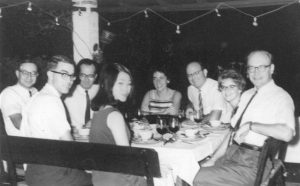
Dinner at the Paprika restaurant, December 1964. From left to right, David Morell, DE, Guy Pauker, Mai Elliott, Tela Zasloff, Joe Zasloff, Susan Morell, John Donnell.
Mai Elliott recalls the background to this meeting. “It was 1964. South Vietnam was going through a period of instability following the overthrow of President Ngo Dinh Diem, and the Viet Cong were seizing on this situation to attack in larger and larger units and to expand their zone of control. RAND sent two consultants to Saigon, Professor Joe Zasloff of Pittsburgh and Professor John Donnell of Temple University, to set up the research project to seek answers to this question. Known as the “Viet Cong Motivation and Morale” project, it would become RAND’s largest research effort in Vietnam. The data would be gathered by interviewing Viet Cong defectors and prisoners of war. The project was not expected to support or refute any policy options, or to make any policy recommendations. But since the Johnson Administration had not settled on a definite policy toward Vietnam beyond graduated pressure, the findings could influence the direction of its policy.”
“Zasloff and Donnell concluded that the insurgency in South Vietnam was a nationalist struggle, a continuation of the fight for Vietnamese independence. It was led by strongly committed and motivated men who had fought against the French, who believed they were fighting to bring about social justice, eradicate poverty, and redistribute land to the peasants toiling for landlords. They also pointed out that, after expanding their control, the Viet Cong had become “the effective government in a significant area of the countryside” and the insurgency now had to be seen, not as a “jungle insurgency led by a band of committed Communist cadres,” but “as a war waged by an alternative government.”
“When they briefed John McNaughton, Assistant Secretary of Defense for International Security Affairs, and McNamara’s closest advisor, in January 1965, McNaughton was reported to have replied, ‘If what you say is true, we’re fighting on the wrong side. The side that’s going to lose this war.’ By this time, American policy had hardened following the Tonkin Gulf Resolution, and American planes had bombed North Vietnam in retaliation for alleged torpedo attacks by North Vietnamese against US ships in the Gulf of Tonkin in August 1964.” 73
“So, the conclusions by Zasloff and Donnell had no influence on US policy toward Vietnam. Their lack of impact pointed to the problems of RAND research usually encountered. By the time a research project was concluded – with data collection, compilation and analysis — it had been overtaken by events.”74 This is the subject of the next chapter.
Farewell 1964, Hello 1965
As the year 1964 came to a close, America was poised on the cusp of direct entry into the war. To add a punctuation mark to the turbulent events of that year, a Viet Cong special operations cadre succeeded in blowing up the most prominent and centrally located Bachelor Officers’ Quarters in Saigon, the Brink Hotel located right next to the famous Continental Hotel in the center of the city. I had just emerged from the side door of the Tax Building when I heard (and felt) the explosion from a block away. I saw the plumes of smoke rising, and immediately understood that it was the Brink hotel, and that it had been the target of one of the largest terrorist attacks that had yet happened in Saigon.
To add to the dismay, it was Christmas Eve, and all Americans and many Vietnamese were looking forward to a day of respite from the war. Watching the smoke rising, my heart sank. It was a low point for me. It clearly signaled that whatever happened in Vietnam, the struggle would be long and painful. Although the U.S. did not follow Ambassador Taylor’s recommendation to bomb North Vietnam in retaliation, the Brink attack set the stage for the next major event.
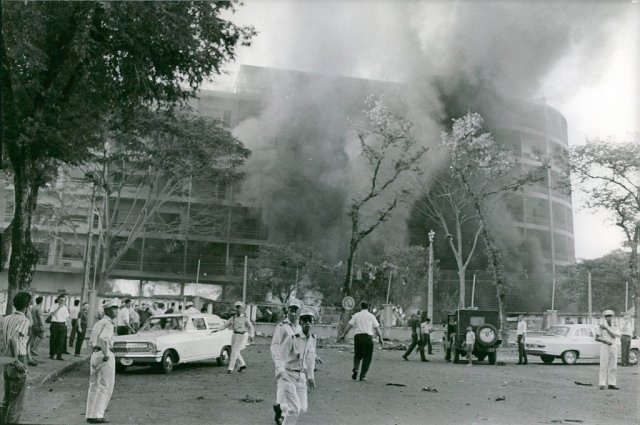
Bombing of the Brink Hotel, December 24, 1964. Two Americans were killed in the blast and 68 Americans and Vietnamese were wounded.
John Buquoi also witnessed the bombing of the Brink Hotel and was equally dismayed. A profile of Buquoi writes: “Buquoi’s six-page story poem, ‘The gifts of Christmas,’ is the best piece of any kind I’ve read on the bombing of the Brinks Hotel, which served as a Bachelor Officers Quarters in downtown Saigon. Buquoi writes of ‘Mr. Xuan, the sapper santa’ who sat across the street and sipped coffee after the bombing, ‘Satisfied as he watched his plastiquework explode.’ His 200-pound car bomb killed two and wounded more than 200 Vietnamese and Americans, civilian and military alike. This story poem brings home the reality of a war that could kill you anywhere. You didn’t have to be “out in the shit.” The shit could come to you—anytime, even on Christmas Eve.”75 Nguyễn Thanh Xuân, the sapper who conducted this operation was highly decorated after the war and singled out as a heroic special operations cadre.76
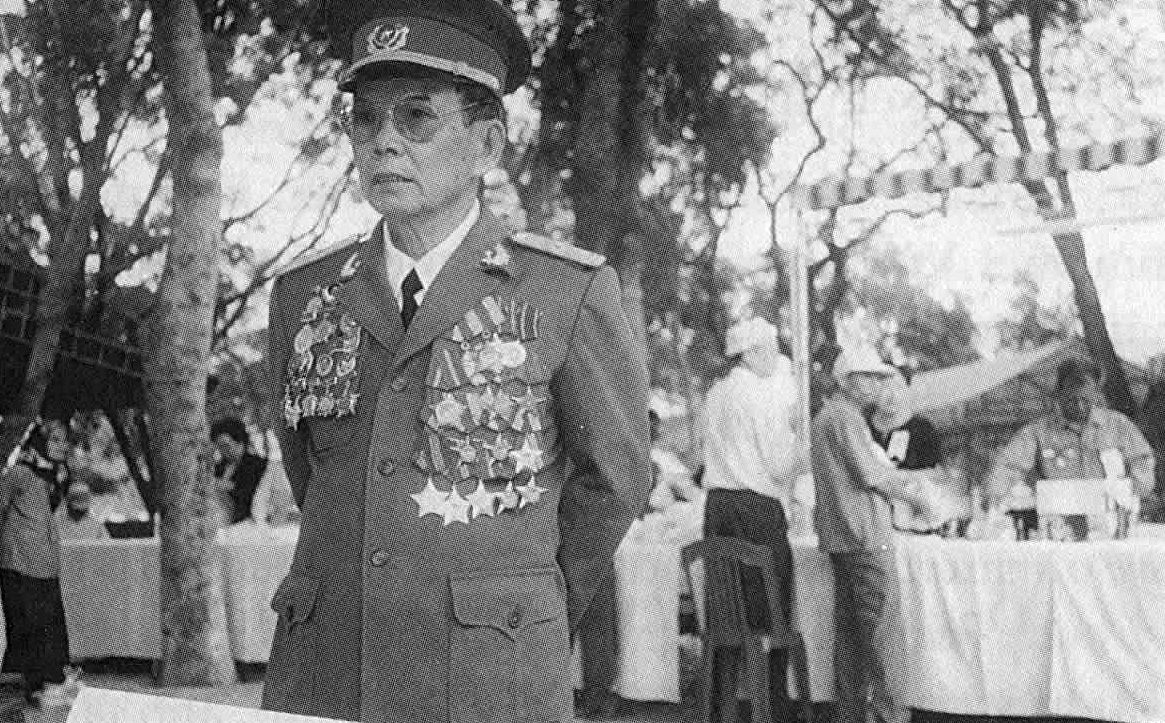
Nguyễn Thanh Xuân, Viet Cong sapper who blew up the Brink Bachelor Officers Quarters on December 24, 1964.
As the chaotic political scene in Saigon produced one unstable government after another, the domestic turmoil in Vietnam escalated. One incident I remember especially vividly was the Buddhist demonstration of January 25, 1965 against the U.S. and the crumbling civilian regime that had replaced General Khanh. The Associated Press reported that “Hundreds of Buddhists attacked a United States Information Service library with stones yesterday and battled with policemen who tried to drive them away. Skirmishes went on into the night and this morning. The disorders, set off by a rally of 450 monks and nuns outside the U.S. Embassy, spread throughout the city. They were directed against American policies supporting Premier Tran Van Huong and his government. This morning, as 2,000 students continued demonstrating outside a secondary school, a monk plunged a knife into himself. … The library rioting began when monks and nuns carried banners in a 10 block march through Saigon to the embassy in defiance of Government orders against street demonstrations. … A wave of shouting Buddhists attacked and stoned cordons of combat policemen. The rioters, dispersed with tear gas and clubs, reassembled and marched on the United States Information Service’s Abraham Lincoln Library, four blocks from the embassy. There they smashed doors and windows. … Paratroops finally donned gas masks and broke up the demonstration with tear gas and clubs. Several dozen demonstrators were injured. … From the sidelines, hundreds of old women, most of them street venders, looked on. They wept and shook their fists at the embassy, where Mr. Taylor has a fifth floor office. ‘Down with America!’ some shouted. ‘Down with the Republic.”77
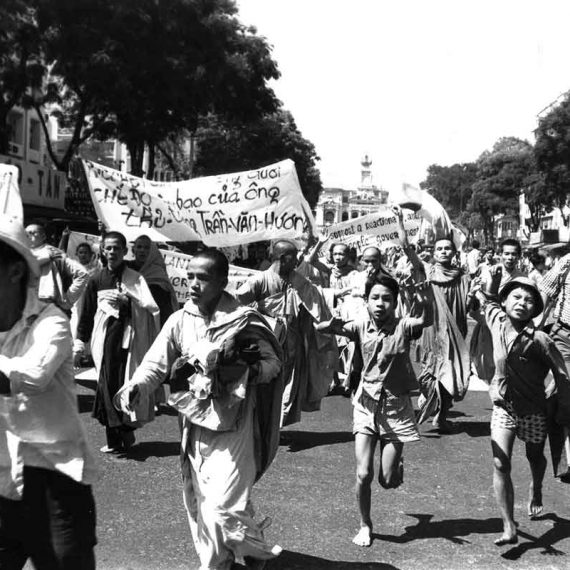
Anti-American demonstration passes Tax Building, January 22, 2915.
I was emerging from a side door of the Tax Building onto Nguyen Hue Boulevard, which was on the route from the U.S. Embassy on Ham Nghi Boulevard to the U.S. Information Service Library across the street from the Tax Building at the intersection of Le Loi and Nguyen Hue. I had been totally unaware that anything was happening outside the Tax Building, but stepped out into a maelstrom of demonstrators racing from the embassy to the library. (In the above photo, they appear to be going from the Library to the Embassy, judging from the City Hall in the background, they would have just passed the Tax Building on the upper left of the photo hidden behind trees. I remember them as coming from the Embassy to the Library, as the Associated Press account reported. Perhaps this photo was taken as they retreated from the library by the same route they had taken from the embassy. Either way, the experience was unsettling). Despite my presence as an American surrounded by anti-American demonstrators, I was completely ignored by the demonstrators as they raced toward their objective.

Tax building on left 1971 – Translation section on interior fourth floor lower left – USIS Abraham Lincoln Library on right, ground floor, corner of Nguyen Hue Boulevard
Being right in the midst of the event, I could feel the frenzied electricity of group hysteria, eyes glazed almost as though they were under a hypnotic spell, as they single mindedly surged toward their target, intoxicated with political passion. I had never in my life been so close to such raw, inflamed mob political passion. I’ll never forget the experience. Somehow I managed to retrieve my Honda, parked by the side of the Tax Building, disengaged from the mob and proceeded home.
On March 30, the U.S. Embassy was hit by a massive car bomb, resulting in major damage and significant casualties. I heard the explosion from the nearby Tax Building about four blocks away, and later went down to witness the devastation
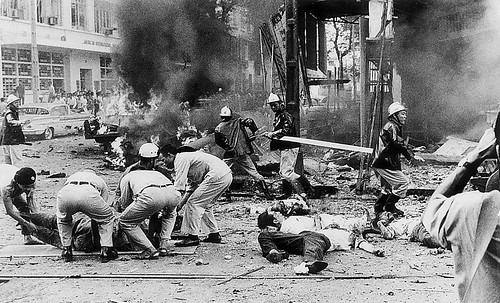
Bombing of U.S. Embassy March 30, 1965. Two Americans were killed and 180 people injured.
In February 1965 National Security Advisor McGeorge Bundy came to Vietnam to assess the rapidly deteriorating situation. On a trip to Central Vietnam, Bundy visited the airbase at Pleiku. While he was there, some U.S. planes at the base were mortared. Bundy, characteristically inflating his importance, assumed this was a challenge from Hanoi and a direct message to him and ordered retaliation. Although Taylor’s bombing recommendation in retaliation for the Brink attack was rejected, the Pleiku attack was a bridge too far for Bundy. It was the next “streetcar” or pretext that had come along, and was more serious in Bundy’s view because he mistakenly thought that this attack, which had been launched by a local Viet Cong commander who had never heard of Bundy and did not know of his presence in Pleiku, was a message sent from Hanoi directed at him. I mention Bundy not only because this was one of the great turning points in the Vietnam, which had a direct effect on me at the time, but also because of the family connection. My father had been an early patron of Bundy at Harvard, and they remained close friends.
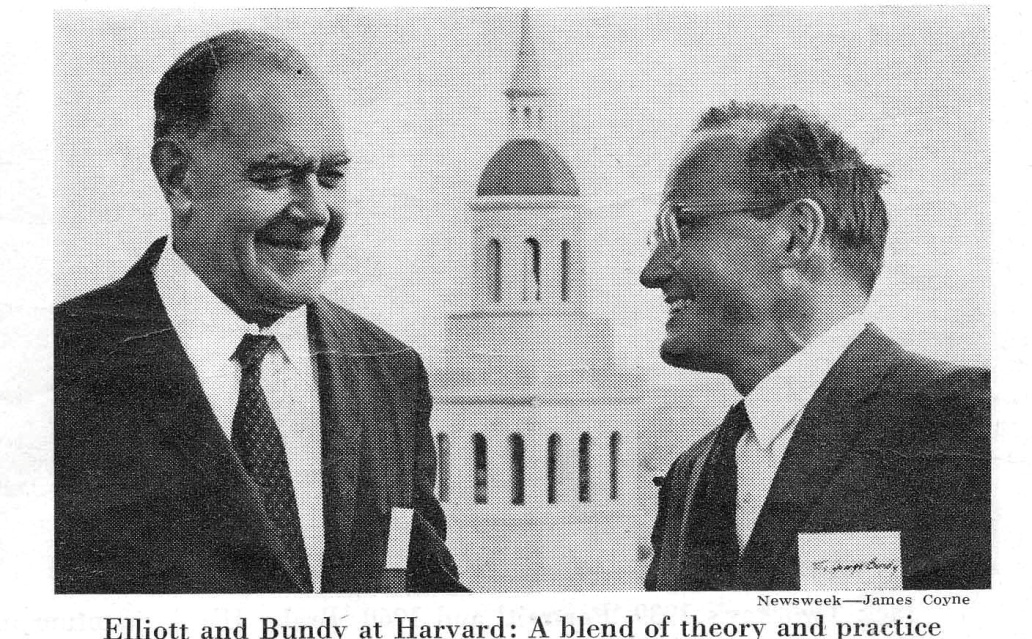
Newsweek, August 5, 1963.
The retaliation that Bundy ordered later developed into Rolling Thunder, the sustained bombing campaign against North Vietnam. This in turn, required protection of airbases in South Vietnam from which some of the raids were launched. This in turn required U.S. troops, who inevitably went on the offensive and became involved in direct combat. At the time I was fully supportive of this move, since I felt that without American intervention, the South Vietnamese government would be defeated. This was certainly true, but it was only much later that I learned that the United States had entered the war knowing that there was no clear path to victory. The aim was not to win the war, but only not to lose it. Thus relieved of the burden of having to formulate a winning strategy, the US also was not forced to carefully weigh the costs and benefits of alternative courses of action, or face the consequences of becoming embroiled in a situation in which there was no “light at the end of the tunnel.” Although the defeat-avoidance goal was certainly not a secret, even in 1965, it was still a shock to read in a biography of Mac Bundy many years after the fact that this paragon of the best and the brightest had not stopped to think through its implications.
In 2017 I wrote an op-ed in the New York Times cautioning about the perils of what was essentially a stalemate strategy in Afghanistan, based on the lessons we should have learned from Vietnam. “In August 1965, a resolute President Lyndon Johnson said: “America wins the wars that she undertakes. Make no mistake about it.” But the strategy on which he committed America to its ill-fated intervention in Vietnam that year did not aim at winning, but at not losing. McGeorge Bundy, Johnson’s national security adviser, later admitted as much to a biographer, saying that he had personally approved a strategy that used just enough military pressure to achieve a battlefield stalemate, which “would eventually compel the Vietnamese Communists to compromise their objectives,” forcing them to the negotiating table or to a Korea-style armistice. Bundy added that his strategy rested, in hindsight, on “little more than an unexamined assumption.”[5]
At the end of 1968 in a famous Foreign Affairs essay Henry Kissinger concluded that a denial strategy cannot in itself produce victory, especially in a conflict involving insurgents. “‘We fought a military war; our opponents fought a political one,” he wrote. “We sought physical attrition; our opponents aimed for our psychological exhaustion. In the process we lost sight of one of the cardinal maxims of guerrilla war: The guerrilla wins if he does not lose. The conventional army loses if it does not win.’ Many years later, Mr. Kissinger, who became Richard Nixon’s national security adviser, connected this conclusion with an additional point: America’s inability to “win” in Vietnam by producing a decisive outcome rendered the stalemate strategy of “not losing” ineffective. He no doubt took pleasure in ascribing the fallacy to his rival and predecessor, Bundy.”[6]
“’Stalemate violates the maxim that the guerrilla wins if he does not lose,” Mr. Kissinger told Newsweek in 2008. “Hanoi’s leaders had fought a decade against France and battled the United States for a similar length of time, not to achieve a political compromise, but to prevail.” In other words, a stalemate strategy against an ideologically motivated, insurgent-driven enemy is doomed to fail.” One of Bundy’s biographers writes that Bundy retrospectively noted that ”'”those who advocated or acquiesced to an attrition strategy did not foresee that military failure could result even from ‘numerical success.’ He pointedly asked himself, ‘Do we discuss whether or not we are in fact well equipped to conduct a war of attrition? I don’t think the question is ever presented to Lyndon Johnson in the whole of the year in which that strategy is adopted.'”[7]
In large part this failure to examine the consequences of adopting an approach where “not losing” led to a failure to pose fundamental questions about strategy and costs, ends and means, was due to an assumption that if worst came to worst the United States could simply shift the blame to the Saigon government and walk away. “‘The commitment’ to Saigon, Bundy explained to the president on June 27, [1965] ‘is primarily political and any decision to enlarge or reduce it will be political. My own further view is that if and when we wish to shift our course and cut our losses in Vietnam we should do so because of a finding that the Vietnamese themselves are not meeting their obligations to themselves or to us. This is the course we started on with Diem, and if we get a wholly ineffective or anti-American government we could do the same thing again.” From the American perspective, winning or losing was less important than not looking bad. As Bundy said about this time in a note to himself “You have to have made enough of an effort.” [8] In another context Bundy was even more blunt: “Even a failed intervention in Vietnam, Bundy asserted, would be better than no intervention at all.” He mused “‘Questions: in terms of U.S. politics which is better: to ‘lose’ now or to ‘lose’ after committing 100,000 men? Tentative answer: the latter.'”[9] In short, the overriding goal in Vietnam was not saving an ally, or defeating an enemy, but in avoiding loss of face. Thus “credibility” became another abstraction superimposed upon the civil war in Vietnam.
Not only had the United States made a hasty and flawed decision to escalate the war in March 1965, it didn’t even bother to consult its nominal Vietnamese allies but simply sent its troops into Vietnam without any prior consultation with the Vietnamese government, let alone a request from them. As the first contingent of U.S. Marines hit the beach in Danang, a mid-level U.S. Embassy official informed the recently-installed South Vietnamese Prime Minister of their arrival. Premier Phan Huy Quat quickly summoned his chief of staff Bui Diem and told him to write a hasty statement which would provide retroactive GVN concurrence with this unilateral American act. The stunned Bui Diem asked “Is there something going on on the military front that’s making them do this so suddenly?” Diem recalled that “Quat did his best to project an air of calm, but his voice was tense. ‘Listen,’ he told me, ‘they are already landing on the beaches right now. They are already ashore. Please just draft the communique and we can talk about the situation later.'” Bui Diem described this and subsequent retroactive Vietnamese endorsements of American unilateral initiatives examples of the “misleading impression of joint consultation.” Thus the pivotal moment in America’s intervention in Vietnam happened without any real planning or debate in Washington, or consultation with our nominal ally in Saigon.[10]
A rueful McGeorge Bundy, many years after the end of the Vietnam War said: “We ought not to ever be in a position where we are deciding, or undertaking to decide, or even trying to influence the internal power structure” of another country.”[11] George Kennan, the historian and former diplomat, came to the same conclusion long before Bundy. In the Fulbright hearings on Vietnam in February 1966, he stated, “Our country should not be asked, and should not ask of itself, to shoulder the main burden of determining the political realities in any other country.”
Of course I had no idea at that time the the United States was plunging into the Vietnam morass with a fatal disregard for the basic elements of good policy process, and a “just don’t lose, or if you do, blame Saigon,” attitude that doomed the entire enterprise to humiliating failure from the start. At any rate, the “big picture” was way above my pay grade, and my concern was the narrow sphere of personal concern and about how each turn of events would affect me at the time. The disillusionment and learning of lessons came to me gradually as what seems now to have been a fore-ordained tragedy unfolded over the succeeding years. In a way I feel fortunate that I, unlike those just a bit younger than me who later went to Vietnam, had illusions in the first place. Without that as a starting point, I don’t think my learning from the Vietnam experience would have been nearly as profound.
The U.S. took the decision to dramatically escalate its military involvement in Vietnam just as my military term of service was coming to an end. I completed my duty at MACV in March 1965 and flew back to Travis Air Base and mustered out of the Army. By this time I had already agreed to sign on at Rand and, after a brief visit home, immediately returned to Vietnam. Mai, who was still a Vietnamese citizen, remained in Vietnam for the three weeks I was gone. In the spring of 1965 there was no clearly formed public opinion about the war. I was certainly not spat upon, and this reported phenomenon did not happen until much later. I simply signed some forms and became a civilian again. Then I returned to Vietnam to work for the RAND Corporation on its study of the Viet Cong.
- Unpublished reminiscence by John Buquoi titled "Hello, Vietnam," sent to me as an email attachment, April 23, 2019. ↵
- null ↵
- For an informative biographical sketch of Cousseau see Christopher E. Goscha, Historical Dictionary of the Indochina War (1945-1954), (Copenhagen: NIAS Press, 2011). pp. 116-17. ↵
- Vietnam: A Television History; LBJ Goes to War (1964 - 1965), PBS documentary on the Vietnam War 1980 ↵
- David Elliott, “What Trump Needs to Learn From Vietnam,” New York Times, September 16, 2017 ↵
- David Elliott, “What Trump Needs to Learn From Vietnam,” New York Times, September 16, 2017 ↵
- Gordon M. Goldstein, Lessons in Disaster: McGeorge Bundy and the Path to War in Vietnam," (New York: Holt, 2008), pp. 188-89 ↵
- Gordon M. Goldstein, Lessons in Disaster: McGeorge Bundy and the Path to War in Vietnam," (New York: Holt, 2008), pp. 200-01 ↵
- Gordon M. Goldstein, Lessons in Disaster: McGeorge Bundy and the Path to War in Vietnam," (New York: Holt, 2008), p.167 ↵
- Bui Diem with David Chanoff, The Jaws of History, (Boston: Houghton-Mifflin, 1987)(, p.132 ↵
- Gordon M. Goldstein, Lessons in Disaster: McGeorge Bundy and the Path to War in Vietnam," (New York: Holt, 2008), p.95 ↵